

How Much Of A Cruise Ship Is Under Water?
Many new cruisers often ask the question, “How much of a cruise ship is underwater, and why don’t they sink ?” For me, it was a major curiosity until I got an answer. So, if you’re also one who wants to know the answer, you’re at the right place.
Basically, the ship’s depth under the water depends on the size of the ship and the amount of load being carried. Generally, around 10% of the ship’s height, or approximately 30 feet for the biggest cruise ships and 20 feet for the smaller ships, is underwater,
Sounds interesting, right? But wait, the science behind the ship floating is even more interesting, due to which they run seamlessly without being unstable.
So get ready, my fellow cruisers. I’ve discussed all the things in this article that will help you clear your doubts. The next time you cruise, you’ll be happy to see the facts with your own eyes. So let’s get started.
Table of Contents
Cruise Ship Weight, Length, and Height Statistics

Before understanding the depth at which a cruise ship sits, it’s important to learn about the cruise ship’s weight, length, and height statistics.
The 50 largest cruise ships in the world, including those from Royal Caribbean and Carnival Cruise Line, weigh over 100,000 gross tons.
Regarding height, the average Royal Caribbean Cruise Ship measures 14 decks (stories) high.
In terms of length, these ships are approximately 20% longer than the Titanic, with an average length of 325 meters.
You can also check out my comprehensive comparison of modern ships and the Titanic.
How Does A Cruise Float?
Cruise ships float above the water line and don’t sink because of the following factors:
1- Hull Shape And Design
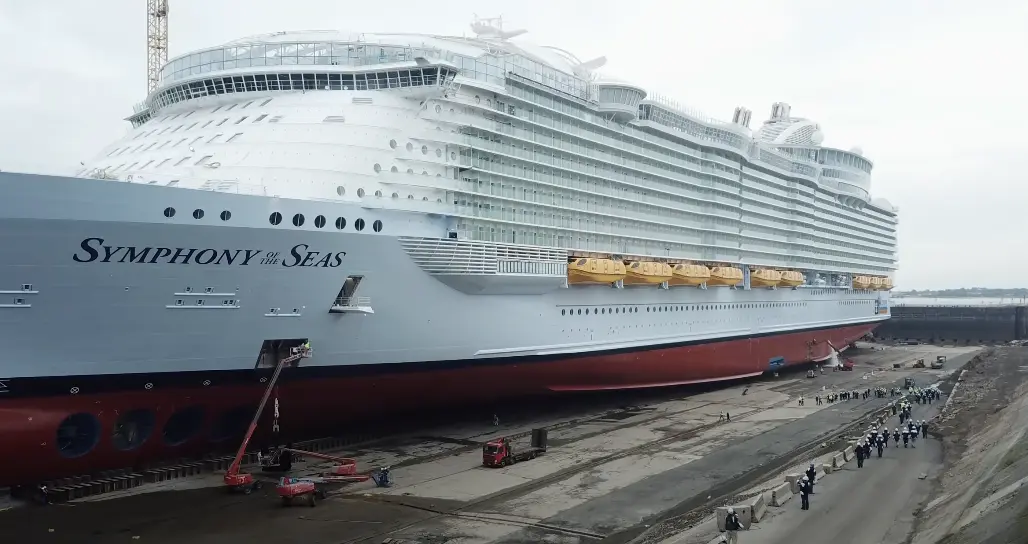
The ship’s hull and design are the major reasons why it doesn’t sink.
These U-shaped hulls push the water outward and downward, creating a buoyant force for the ship.
Not only that, but this massive hull also maximizes the water displacement, creating a lifting effect. A lot of modern cruise ships, including Royal Caribbean and Carnival Cruise Line, feature a V-shaped hull design to cut through the water efficiently.
Due to these hulls, the ship glides through the water with ease, maintaining stability and efficient floatation.
For physics lovers, let me explain with a principle. The hulls follow Archimedes’ principle, which states that the floating object is pushed up by a force equal to the weight of the liquid it displaces.
So yeah, now you must have a clear understanding of the science behind ship floatation and why it doesn’t sink.
How Deep Do Cruise Ships Sit In The Water?
Generally speaking, the answer varies due to the ship’s size.
Smaller cruise ships tend to sit lower in the water than the larger ones. It’s because they have less buoyancy and are more susceptible to being swamped by waves.
Both ship’s design and operation play an important role in the depth at which a cruise ship sits in the water.
Cruise ships typically sit between 12-15 feet below sea level when fully loaded with cargo, fuel, and passengers.
This depth helps the sea voyagers to stay stable while providing enough buoyancy for them to float.
However, it’s important to note that the depth of the cruise ship in the sea also depends on physical factors like rough seas and heavy load.
If the ship is sailing in rough seas, it may sit deeper in the water for increased stability. Likewise, for the heavy load, the depth of the ship will also be greater.
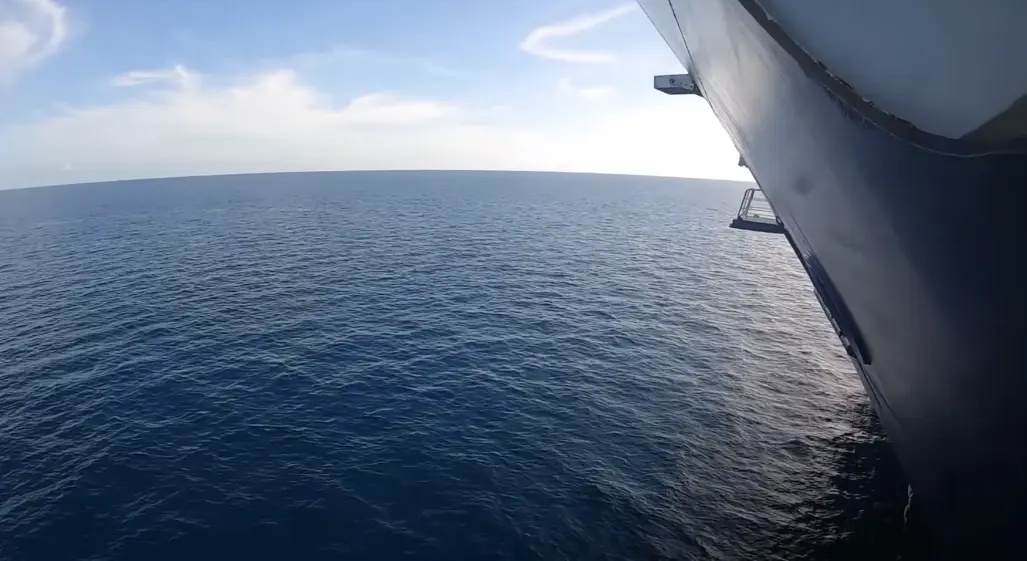
How To Measure The Depth At Which Ship Sit In The Water?
For measuring the depth at which a ship sits in the water, we look at the draft.
The draft size varies from ship to ship depending on the vessel’s size, fuel, and ballast.
Usually, cruise ships have a draft between 5 meters (16ft 5in) and 10 meters (32ft 10in).
The large cruise ships like Anthem of the Seas have a draft of 8.5 to 8.8 meters (about 28 feet). Likewise, the largest cruise ships, Royal Caribbean Oasis-class, have a draft of 9.3 meters (30ft 7in).
Smaller cruise ships typically have a draft of less than 7m (22ft 9in) so they can enter smaller ports.
Generally, the ship’s draft sizes are essential for determining the port the ship can enter.
I’ve mentioned the two terms that you’ll often hear when it comes to measuring the depth at which a ship sits in the water.
1- Draft Marks
Draft marks are the major indicator of how deep the ship is sitting in the water. These marks are located at the bow and stern.
With these marks, one can easily assess the ship’s draft, which is the depth from the waterline to the lowest point of the hull.
Next time, I suggest you focus on these marks to learn how much the cruise ship on which you’re traveling is submerged in the water.

2- Load Line
The second way I discovered this was on my last cruise ship on Royal Caribbean when I was sailing on Icon Of the Seas. It’s called the Plimsoll mark or load line.
This line is present at the center of a ship’s side, which indicates the maximum safe draft. It was named after Samuel Plimsoll.
In actuality, this line sets the limit to which the vessel can be loaded. There’s a line passing through the circle highlighting this maximum point, with a ladder arrangement showing different drafts for specific conditions.
The letters on the mark (T for Tropical, S for Summer, and W for Winter) denote maximum drafts under certain conditions.
Amazingly, the S load line is used to prevent overloading, as sailing with this mark submerged is illegal.
The N and V markings represent the ship’s classification society, ensuring adherence to international standards. This load line helps measure the ship’s depth in the water, ensuring compliance with safety regulations.
Why Do Cruise Ships Have Flat Bottoms?
Cruise ships work on the principle of buoyancy given by Archimedes’ Principle. So, for this reason, they have flat bottoms for increased stability and fuel efficiency.
Flat bottoms are highly beneficial in providing a larger surface area, thus increasing stability in calm as well as in moderately rough seas.
Not only that, flat bottoms allow for better weight distribution, preventing the ship from rolling excessively.
The Physics of Water Displacement
If you don’t enjoy physics like my husband, feel free to move on to the next section. But if you really want to understand the concept of a ship underwater, I suggest you have a look at this section.
As I already mentioned, the cruise ship’s underwater size is based on the Archimedes Principle, which explains the relation between the weight of an object and the fluid it displaces.
To make it simpler in cruise ship terms, this principle states that the ship must displace an amount of water equal to its weight to maintain stability.
The Role Of Ship Stability

Stability is a major concern while designing cruise ships. Several measures are taken to keep the ship stable, especially in the rough seas.
But do you know the science behind the ship’s stability? It’s all due to the low center of gravity and high buoyancy.
For a ship to be stable, its center of gravity must be low, and its buoyancy must be high.
As mentioned earlier, the large ship hull design helps the ship to be more stable by distributing the weight of the ship over the larger area and allowing for a more significant amount of water displacement.
With all these factors, a stable vessel is designed to provide an enjoyable experience to passengers even in the rough seas.
Read more about cruise stability here.
Explanation Of Cruise Ship Design Features
How Much Water Does A Cruise Ship Hull Displace?
The amount of water displaced by a cruise ship’s hull follows Archimedes’ principle. According to this principle, the cruise ship displaces an amount of water equal to its own mass.
Let’s take an example of the largest cruise ship, Symphony of the Seas, which weighs approximately 228,000 tons and would displace 228,000 tons of water.
Now, you’ll have a clear understanding of how much water is displaced by the ship’s hull. Thanks to Archimedes’ Principle.
What Keeps a Cruise Ship From Tipping Over?
Cruise Ships are designed so efficiently that they are safe and stable.
A lot of people are curious to know why cruise ships don’t tip over, even if they’re so huge.
So, the combination of a wide hull, low center of gravity, fuel, and ballast tanks filled with water maintains a great balance and keeps a cruise ship from tipping over in rough seas.
What Extra Steps Are Taken For Extra Stability In Rough Seas?
The cruise ship’s stability totally depends on the center of gravity. It’s kept low to keep the ship stable, but it can be moved up or down by adjusting weights within the vessel.
The most obvious is ballast water and fuel. In extreme cases and rough seas, cruise ship swimming pools could be drained to provide additional stability as the weight of so much water on the upper decks will make the center of gravity higher.
Most cruise ships have a mechanical stabilizing system, and some have bilge keels, which also help to limit the amount of roll.
How Many Decks Are Underwater on a Cruise Ship?
The number of underwater decks on a voyage depends on its size and type.
However, cruise ships usually have one or two decks underwater, but passengers won’t find them as these decks are not named or numbered.
These are usually out of bounds for passengers as they contain various ship’s operational things and consist of hundreds of crew cabins to provide living and sleeping space for them.
So the next time you cruise, keep in mind that if you’re on Deck 1, you’re not the lowest on the ship. There are other decks under you.
The lower decks also need to house the following:
- Various engine and mechanical rooms
- Food storage units
- Medical Center
- Crew-only social rooms
Do Cruise Ships Have Staterooms Underwater?
No, Cruise ships don’t offer underwater staterooms. However, there are cabins only for crew members to live and sleep in.
These are quite small and windowless as compared to those for cruise guests.
So, if you’re planning to book the underwater cabins, forget it, as they are only limited to the onboard crew members.
Why Don’t Cruise Ships Have Underwater Viewing Areas?
At the beginning of my cruise journey, I also asked my husband why the cruise line doesn’t offer underwater viewing areas to let us see all the marine life and coral reefs as we sail through the ocean.
But later on, I got an answer by myself. There are several reasons why cruise ships don’t have underwater viewing areas.
- Strength: Glass is not as strong as steel, which is crucial for handling sea pressures.
- Utilization: Underwater decks serve mechanical and crew needs, making structural changes challenging.
- Safety Concerns: Adding viewing areas may compromise ship safety during accidents or pressure.
- Cleaning Challenges: Windowed areas would require frequent cleaning due to algae buildup.
- Maintenance Costs: Regular cleaning and maintenance would be costly for cruise lines.
- Practicality: 99% of the time, an underwater viewing area would show disturbed water.
What Parts of a Cruise Ship Are Underwater?

Now, after knowing the ship’s floating science and the depth at which it’s underwater, you must be thinking about the vessel parts underwater.
These parts include:
- Bulbous Bow: The front part of the ships have a bulbous bow, a big projection that sticks out and changes how the water moves along the side of the ship.
- Propellers: At the stern, there are propellers designed to push through the water and move the ship forward or even backward in some cases.
- Hull: The U or V-shaped hulls displace large amounts of water, which increases the buoyancy force required to keep such large, heavy vessels floating.
How Much Water Does a Cruise Ship Need to Dock?
A cruise ship usually needs about 9 to 12 feet more than its draft to dock safely.
Let’s suppose that a ship has a 30-foot draft; it requires water depths of at least 40 feet for safe sailing, accounting for its bouncing movement.
Where’s the Most Of the Cruise Ship Weight?
The majority of the ship’s weight is underwater to maintain the ship’s low center of gravity for extra stability in rough seas.
What’s On The Lowest Deck?
The lowest deck of the vessel, also known as orlop, it’s just below the cove balconies and contains essential components necessary for the ship’s operation including engine room. Also, it contains crew-only cabins for their living and sleep.
Final Words
Hopefully, now you have an answer to the question of how the cruise ship floats and its depth under the water.
Next time, you’ll enjoy your cruise even more after seeing all the above facts and science with your eyes.
Have a safe and enjoyable cruise.
I am Zoe Grace, a passionate enthusiast of cruise ships. With a decade of firsthand experience in the cruising industry, I have developed a deep understanding of the intricacies and wonders that these majestic vessels hold.
Now, I am excited to embark on a new journey as an author, sharing my knowledge and insights with readers who share my fascination for the world of cruising.
Join me as we explore the captivating world of cruise ships together.
Similar Posts

Can Felons Go on a Cruise | Compulsory Documents For Felons
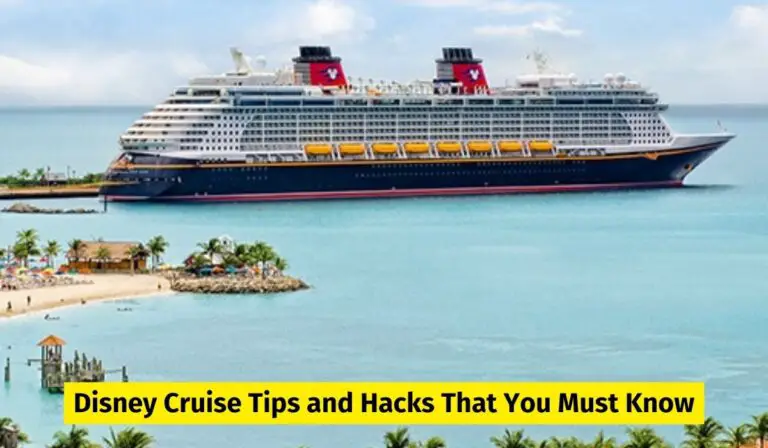
45 Disney Cruise Tips and Hacks That You Must Know

7 Best Myrtle Dinner Cruises 2024 – Ultimate Guide

Best Alaska Cruise Outfits & Packing List For Your Voyage

Why Are American Cruise Lines So Expensive? Is It Worth It?
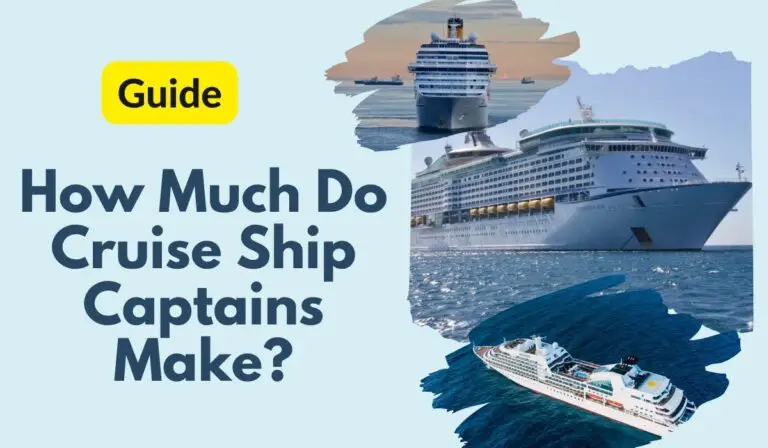
How Much Does a Cruise Ship Captains Make In 2024?

How Much of a Cruise Ship is Under Water: A Clear Explanation

Cruise ships are so mammoth that many people wonder how they stay afloat. It’s pretty amazing to see something the size of a small city seemingly floating on top of the water. But actually, how much of a cruise ship is under water?
You might be surprised to find out that only about 10-15% of a cruise ship’s overall height is underwater. The underwater part of the ship’s hull is typically wider at the back and narrows towards the bow. However, this is not the only factor determining how much the ship is submerged.
Generally speaking, a cruise ship can be anywhere between a few feet and several hundred feet below the surface of the water. The largest cruise ships are typically over 1,000 feet long and can reach depths of up to 200 feet below the surface.
These behemoths are built with multiple decks, each offering its own unique set of amenities. However, the amount of ship that is underwater is only a fraction of its overall size, which is a testament to the incredible technology that marine engineers have developed.
Understanding Cruise Ship Structures
Cruise ships are engineering marvels, with complex structures that allow them to navigate the open seas safely and comfortably.
Understanding the various components of a cruise ship’s structure can help passengers appreciate the vessel’s design and feel more secure during their voyage.
At the heart of any cruise ship is its hull, which forms the watertight outer shell of the vessel. The hull is typically made of steel and is designed to withstand the stresses of the open sea, including waves, wind, and currents. Modern cruise ships often have wide hulls, which provide greater stability and reduce drag.
A cruise ship’s hull size can vary widely, depending on the vessel’s overall size and displacement. The largest cruise ship in the world, for example, has a length of 1,188 feet and a width of 215 feet, with a gross tonnage of over 225,000. The hull of a cruise ship is also designed to accommodate various features, such as cabins, crew quarters, ballast tanks, and the engine room.
Cruise ships are typically divided into several decks, which provide different amenities and services for passengers. The bottom deck is usually reserved for crew members and may contain features such as the engine room, crew quarters, and storage areas. The upper decks are where passengers can find staterooms, dining areas, entertainment venues, and other amenities.
The height of a cruise ship’s decks can also vary depending on the vessel’s layout and design. Some modern cruise ships have flat bottoms, while others have bulbous bows that help reduce drag and improve fuel efficiency.
The weight distribution of a cruise ship is also carefully managed to ensure that the vessel remains stable and upright, even in rough seas.
In addition to its hull and decks, a cruise ship also has various other components that contribute to its overall structure and function. These include the propellers, ballast tanks, keel, and bulbous bow.
The engineering of a cruise ship is a complex field that involves physics, math, and careful planning to ensure that the vessel is safe and efficient.
The Underwater Portion of a Cruise Ship

The amount of the ship that is underwater ranges from 20 feet for a smaller ship to 31 feet for the largest vessels. This means that only about 13% of the ship’s hull and superstructure is underwater, which further reinforces how incredible the technology that marine engineers have developed.
While the underwater portion of the ship may sound concerning, it is important to note that the ship’s weight and balance are carefully calculated to ensure that it remains stable in the water.
Additionally, modern cruise ships are equipped with advanced stabilization systems that help reduce the impact of rough seas.
Passengers may wonder about the underwater cruise ship rooms or the bottom deck of the ship.
While some cruise ships do have rooms that are partially underwater, these rooms typically have windows that allow passengers to see the ocean and marine life. The bottom deck of the ship is usually reserved for crew quarters, storage, and machinery.
The Principle of Buoyancy and Stability
Cruise ships are massive structures that can weigh hundreds of thousands of tons, yet they stay afloat on the water. This is because of the principle of buoyancy and stability, which is based on the laws of physics.
Buoyancy is the upward force that a fluid, such as water, exerts on an object that is submerged in it. The amount of buoyant force depends on the volume of the object that is submerged and the density of the fluid.
A cruise ship’s hull is designed to displace a large amount of water to provide it with enough buoyancy to stay afloat.
Stability, on the other hand, refers to the property of a floating body, such as a vessel, to maintain an upright floating position in still waters, or to right itself up again in rough waters.
Stability calculations focus on centers of gravity, centers of buoyancy, the metacenters of vessels, and on how these interact.
To ensure stability, cruise ships are designed with a low center of gravity, which means that most of the weight is located near the bottom of the ship. This helps to prevent the ship from tipping over.
Additionally, the shape of the hull and the placement of the ballast tanks are carefully designed to provide the ship with the necessary stability.
The physics of water displacement also plays a role in the stability of cruise ships. As it applies to cruise ships, the physics of water displacement is based on Archimedes’ principle, which dictates that the amount of fluid displaced by an object equals its upward buoyant force.
This means that the more water the ship displaces, the greater the upward buoyant force, which helps to keep the ship afloat.
The Impact of Weight and Size
The weight and size of a cruise ship play a significant role in how much of it is underwater. As a general rule, the larger the ship, the more it will sit in the water. This is because the ship’s weight is distributed over a larger area, resulting in a lower weight-to-water ratio.
Cruise ships are measured in gross tons, which measures the ship’s overall size and not its weight. However, the weight of a ship is an important factor in determining how much of it is underwater.
Ships have to displace an equal amount of water to their weight to remain afloat. This means that the heavier the ship, the more of it will be underwater. Sometimes up to 40%.
The world’s largest cruise ship is currently Royal Caribbean’s Wonder of the Seas (source: Smithsonian Magazine ). This ship has a gross tonnage of 236,857 and measures 1,188 feet (362 m) in length across 18 decks.
How does something this significant stay afloat? It’s all about buoyancy: the power of a liquid to keep things afloat.
The weight distribution of a cruise ship is also essential. The bulk of the ship’s weight is contained in the lower portion, ensuring a low center of gravity.
This helps to stabilize the ship and prevent it from tipping over. The weight distribution also affects the ship’s draft, which is the ship’s depth below the waterline.
The draft of a cruise ship can vary depending on its size and weight. Smaller ships may have a draft of around 20 feet, while larger ships can have a draft of more than 30 feet.
The shape of the ship’s hull also affects its draft. A ship with a broader hull will have a shallower draft than a ship with a narrower hull.
Additional Features Under Water
In addition to the hull and superstructure, there are several other features of a cruise ship that are located underwater. These features include the engine room, fuel tanks, crew cabins, crew quarters, fresh water reserves, and laundry room.
The engine room is one of the most important areas of a cruise ship. It is located below the waterline and is responsible for powering the ship. The engine room contains the ship’s propulsion system, which includes the engines, generators, and other equipment that are necessary to keep the ship moving.
Fuel tanks are also located below the waterline. These tanks store the fuel that is used to power the ship. The amount of fuel that a cruise ship can carry depends on its size and the length of its voyage.
Crew cabins and crew quarters are located below the waterline as well. These areas are where the crew members live and sleep while they are working on the ship . The crew cabins are typically small and basic, and they are designed to maximize space and efficiency.
Fresh water reserves are also located below the waterline. These reserves are used to provide drinking water and to supply the ship’s various systems and equipment. The amount of fresh water that a cruise ship can carry depends on its size and the length of its voyage.
Finally, the laundry room is located below the waterline as well. This is where the ship’s laundry is done, and it is an important part of keeping the ship clean and comfortable for passengers and crew alike.
The Role of the Cruise Ship’s Draft

This measurement can vary depending on the weight of the ship, which is affected by factors such as the number of passengers, cargo, and fuel on board.
The draft of a cruise ship is a crucial consideration when it comes to navigating through different bodies of water. For instance, a ship with a deep draft may not be able to navigate through shallow waters or canals, while a ship with a shallow draft can navigate through these areas with ease.
The draft also determines what ports a cruise ship can dock at, as some ports may not have the necessary depth to accommodate a ship with a deep draft.
The depth of the water that a cruise ship is traveling in also plays a role in determining the ship’s draft. In shallow waters, the draft of the ship will be shallower as the ship will be closer to the waterline. In deeper waters, the draft will be deeper as the ship will be further from the waterline.
The waterline is the point at which the water meets the hull of the ship. The draft of the ship is measured from this point to the bottom of the hull. The draft mark measurement scale can be seen on either side of the ship’s bow and stern, indicating the current draft level.
In rapid waters, the draft of the ship becomes even more important. A ship with a deep draft will have a better chance of remaining upright in challenging sea conditions, as the weight of the ship will help to stabilize it.
However, a ship with a shallow draft may be more maneuverable in these conditions, as it will be able to navigate through the water more easily.
Cruise Ship Safety Measures
Cruise ships are some of the safest modes of transportation available, and cruise lines must follow a surprising number of rules and regulations to ensure the safety of their passengers and crew.
Here are some of the safety measures that are in place on most cruise ships:
- Emergency Drills : Before the ship sets sail, all passengers are required to participate in an emergency drill. This drill includes instructions on what to do in case of an emergency, such as a fire or a shipwreck.
- Security Personnel : Cruise ships have security personnel on board to ensure the safety of the passengers and crew. These personnel are trained to handle a variety of situations, including theft, assault, and other crimes.
- Medical Center : Most cruise ships have a medical center on board, staffed by licensed medical professionals. This center is equipped to handle a variety of medical emergencies, from minor injuries to more serious illnesses.
- Jail : While it is rare for a passenger to be arrested on a cruise ship, some ships do have a small jail on board. This jail is used to hold passengers who have committed crimes or who pose a threat to the safety of others on board.
- Morgue : Unfortunately, deaths do occur on cruise ships from time to time. For this reason, most ships have a small morgue on board to store the deceased until they can be transported back to shore.
Cruise ships are designed with safety in mind, and passengers can rest assured that they are in good hands while on board.
Accommodations and Amenities Onboard
Cruise ships offer a wide range of accommodations and amenities to cater to the needs of different passengers. From luxurious suites to cozy cabins, there is something for everyone.
Most cabins come with standard features such as a private bathroom, a television, and a telephone. Some cabins may also have a balcony or a window with a view of the ocean.
In addition to comfortable cabins, cruise ships offer a variety of amenities to keep passengers entertained and relaxed. Many ships have multiple dining options, ranging from casual buffets to fine dining restaurants.
Onboard bars and lounges offer a variety of drinks and cocktails; some ships even have ice bars where passengers can enjoy a drink in a chilly setting.
Cruise ships have plenty of options for those who enjoy music and entertainment. Many ships have live music performances, comedy shows, and theatrical productions. Some ships even have movie theaters and outdoor screens where passengers can enjoy a film under the stars.
Cruise ships also offer a variety of activities for all ages. Kids’ activities such as scavenger hunts, arts and crafts, and video game tournaments entertain younger passengers. Adults can enjoy leisure vessels such as mini-golf courses, swimming pools, and fitness centers.
Staterooms on cruise ships vary in size and amenities. Some ships offer suites with separate living areas, balconies, and even butler service. Other staterooms may be smaller and more basic, but still offer all the necessary amenities for a comfortable stay.
It is important to note that while cruise ships offer many amenities and activities, they are also home to hardworking crew members who work tirelessly to ensure passengers have a safe and enjoyable experience.
From the galley to the entertainment staff, crew members play a vital role in making a cruise ship run smoothly.
Docking and Ports
When a cruise ship arrives at a port, it typically needs to dock to allow passengers to disembark and embark. The docking process can be complex and requires careful coordination between the ship’s crew and the port authorities.
Ports are designed to accommodate different sizes and types of ships, and cruise ships are no exception. Many ports have dedicated cruise ship terminals, with facilities such as customs and immigration, baggage handling, and security.
These terminals are often located near the city center, making it easy for passengers to explore the local area.
The docking process itself involves several steps. First, the ship’s crew must communicate with the port authorities to arrange a suitable time and location for docking. Once this has been agreed, the ship will approach the port and begin the process of mooring.
Mooring a cruise ship involves securing it to the dock using a combination of ropes, cables, and winches. This is a delicate process and requires careful coordination between the ship’s crew and the port authorities. Once the ship is securely moored, passengers can begin to disembark.
Ports are also responsible for ensuring cruise ships comply with local regulations and environmental standards. This includes monitoring the discharge of waste and other pollutants and ensuring that the ship’s engines operate within acceptable noise and emissions limits.
Historical Perspective: Titanic vs. Modern Ships

The Titanic had a draft of 34 feet, meaning that 34 feet of the ship was underwater. This was necessary to accommodate the ship’s massive engines and provide stability in rough seas.
In contrast, modern cruise ships have much shallower drafts. For example, the Royal Caribbean International fleet has an average draft of around 28 feet, with some ships as shallow as 22 feet.
This is partly due to advances in ship design and propulsion technology that allow for more efficient use of space and a smaller overall size.
Another difference between the Titanic and modern cruise ships is the amount of space devoted to passenger cabins and amenities.
The Titanic had a total of 840 cabins, with a maximum capacity of 2,435 passengers and crew. In contrast, modern cruise ships can accommodate thousands of passengers and crew, with the largest ships able to carry over 6,000 passengers.
Despite these differences, there are some similarities between the Titanic and modern cruise ships. For example, both types of ships feature a variety of onboard amenities, including restaurants, bars, theaters, and swimming pools.
However, modern cruise ships often have even more extensive amenities, with some ships featuring multiple pools, water slides, rock climbing walls, and even ice skating rinks.
Frequently Asked Questions
Q: what is the draft of a typical cruise ship.
A: The draft of a cruise ship is the distance between the ship’s keel, the hull’s lowest point, and the water’s surface. The draft of a typical cruise ship is around 25 feet, or 7.6 meters.
Q: How deep does a cruise ship sit in the water?
A: The depth at which a cruise ship sits in the water depends on its weight, size, and draft. On average, a cruise ship sits about 30 feet, or 9 meters, below the waterline.
Q: What is the height of a cruise ship above the waterline?
A: The height of a cruise ship above the waterline varies depending on the ship’s design and its weight. However, on average, the height of a cruise ship above the waterline is around 100 feet, or 30 meters.
Q: How many decks are typically below the waterline on a cruise ship?
A: The number of decks below the waterline on a cruise ship varies depending on the ship’s design and size. However, on average, three to four decks are usually below the waterline.
Q: What is the weight distribution of a cruise ship?
A: The weight distribution of a cruise ship is carefully calculated to ensure that the ship remains stable in the water. The weight is distributed evenly throughout the ship, with heavy items like engines and fuel tanks located in the lower part of the ship to keep the center of gravity low.
Q: How does a cruise ship maintain stability in the water?
A: Cruise ships maintain stability in the water through a combination of weight distribution, ballast tanks, and stabilizers. Ballast tanks are used to adjust the weight distribution of the ship, while stabilizers are used to counteract the ship’s movement in the water caused by waves and wind.
Q: Are there underwater cabins on a cruise ship?
A: There are no underwater passenger cabins on any of the main cruise lines. However, some river cruise ships have cabins below the water line.
The lower decks are usually where the crew’s cabins are. Most are still well above the water, but with some large swells, those areas can be in the splash zone.
Final Thoughts
The amount of a cruise ship that is underwater varies depending on the size and type of the ship. Typically, about 10% of the ship’s overall height is underwater, which equates to around 30 feet for larger cruise ships. Such a small amount for the size of some of the cruise ships!
The underwater part of a ship’s hull is typically wider at the back and narrows towards the bow. This design helps to provide stability in rough seas and prevent the ship from tipping over thankfully!
Leave a Reply Cancel reply
Your email address will not be published. Required fields are marked *
Save my name, email, and website in this browser for the next time I comment.
Stay in the Loop: The latest cruise DEALS & NEWS delivered to your inbox - Click Here!
CruiseOverload
How Much Of A Cruise Ship Is Under Water? (& Other FAQs!)
Cruise ships are a marvel of modern engineering, defying the laws of physics to remain afloat and navigate even the most treacherous of waters.
But have you ever wondered how much of these colossal vessels are actually submerged beneath the waves?
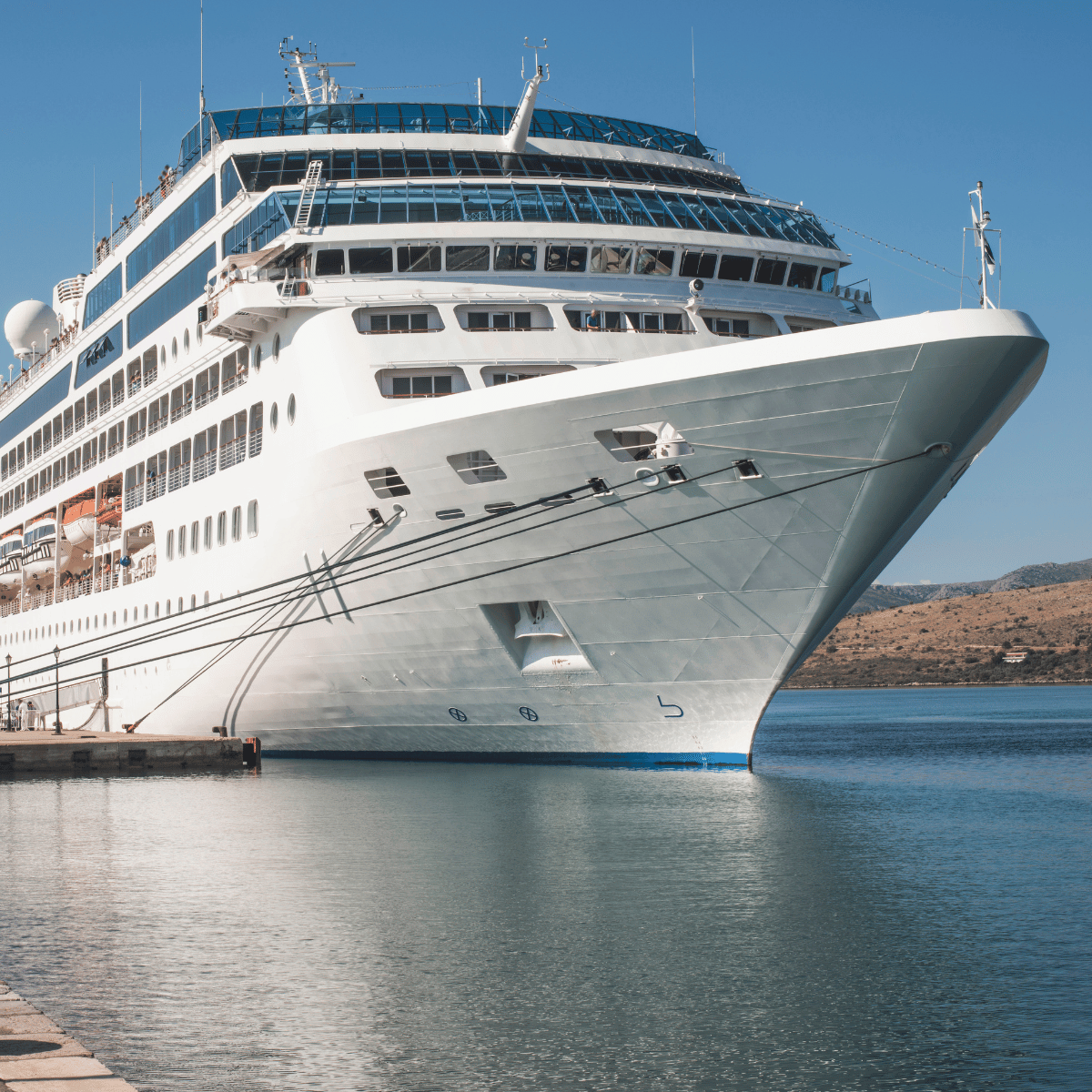
Table of Contents
How Much of a Cruise Ship is Under Water
The larger or higher the ship, the less of it is in water. For example, the amount of cruise ship that is underwater ranges from 20 feet, for a smaller ship, to 31 feet for the largest vessels.
It means that only 10% to 13% of the ship’s hull and superstructure is underwater, which further reinforces how incredible the technology that marine engineers have developed.
Usually, about 10% of a cruise ship’s overall height is under the water. This equates to about 30ft for large cruise ships.
The underwater part of the ship’s hull is typically wide at the back narrowing towards the bow.
Some of the largest cruise ships in the world, like Royal Caribbean’s Oasis-class ships, have a height above the waterline of around 72 meters (236ft 11in), and a draft below the water of around 9.3 meters (30ft 6in).
It’s important to note that the amount of the ship that is underwater can vary depending on a few different factors, such as the weight of the ship and the amount of fuel it’s carrying.
While the amount of a cruise ship that is underwater can vary, it’s generally around 10% of the ship’s overall height.
This is an impressive feat of engineering, and it’s a testament to the incredible technology that goes into designing and building these massive vessels.
What Keeps a Cruise Ship Afloat?
When you look at a massive cruise ship, it’s hard to imagine how it stays afloat in the water. Cruise ships are incredibly heavy, and most of their weight is below the waterline. So, what keeps them from sinking?
The reason a cruise ship stays afloat is buoyancy. Buoyancy is the upward force that a fluid exerts on an object that is immersed in it.
When a cruise ship is placed in water, it displaces an amount of water equal to its own weight. This displacement creates an upward force that counteracts the downward force of the ship’s weight, keeping it afloat.
The shape of the hull also plays a significant role in keeping a cruise ship afloat. The hull is designed to displace water efficiently and minimize resistance as the ship moves through the water.
The wider the hull, the more water it can displace, which creates a greater upward force.
Plus, cruise ships have a low center of gravity, which helps to keep them stable in the water. The weight of the ship is distributed over a large volume, including a wide hull and overall surface area, which spreads over a wider area of water and offers more of an upward force, keeping it afloat.
A combination of buoyancy, the shape of the hull, and the low center of gravity all work together to keep a cruise ship afloat.
The Shape of the Cruise Ship’s Hull
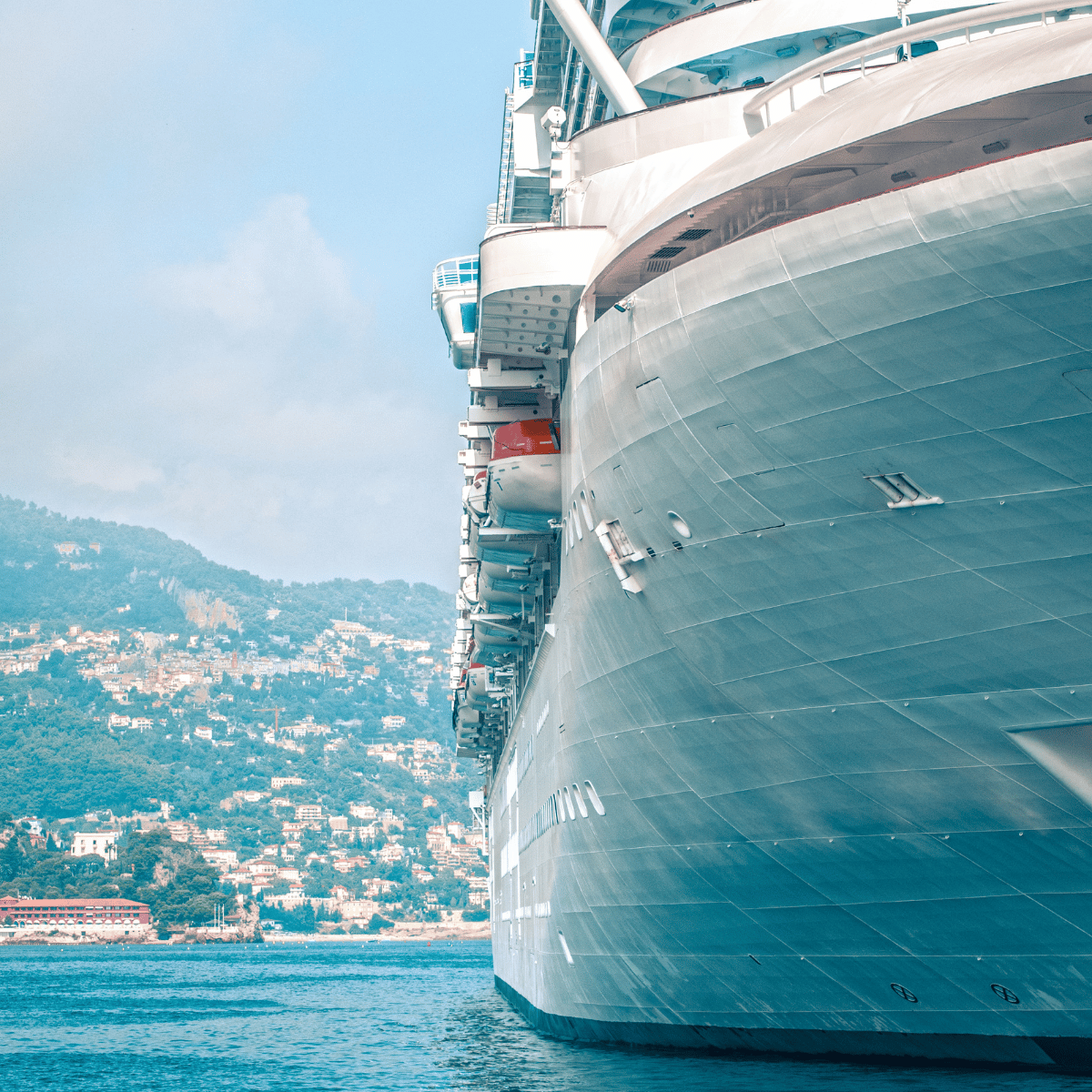
The hull of a cruise ship is the most important part of the vessel, as it is responsible for keeping the ship afloat and stable in the water. The shape of the hull is designed to minimize resistance and maximize efficiency, allowing the ship to move through the water with ease.
Most modern cruise ships have a deep V-shaped hull, which is the most efficient shape for cutting through the water.
This design allows the ship to move quickly and smoothly while minimizing the amount of fuel needed to power the engines.
The V-shaped hull is also designed to reduce the amount of rolling and pitching that the ship experiences in rough seas.
The shape of the hull helps to distribute the weight of the ship evenly, keeping it stable and balanced even in choppy waters.
In addition to the V-shaped hull, many cruise ships also have a bulbous bow. This is a bulb-shaped extension at the front of the ship that helps to reduce drag and increase efficiency.
The bulbous bow helps to push water out of the way as the ship moves through the water, reducing resistance and making the ship easier to maneuver.
Overall, the shape of the hull is a critical factor in the performance of a cruise ship. The V-shaped hull and bulbous bow work together to make the ship more efficient, stable, and maneuverable, ensuring a smooth and comfortable ride for passengers.
Hull Shape and Design
The hull of a cruise ship is a critical component of its design. It is responsible for providing stability, buoyancy, and resistance to the water.
Cruise ships typically have a V or U-shaped hull at the front, which helps to displace water and reduce drag.
The hull is flatter at the back, which helps to reduce the wake and increase speed.
The hull of a cruise ship is designed to withstand the forces of the ocean. It is made from heavy steel panels that are welded together to create a watertight outer skin.
The design of the hull is based on the classification society rules, which ensure that the ship is safe and seaworthy.
The hull of a cruise ship is also designed to reduce the impact of waves and wind. The shape of the hull helps to deflect waves and reduce the amount of water that comes over the bow of the ship.
The design of the hull also helps to reduce the amount of wind resistance, which increases the speed and efficiency of the ship.
On top of the shape of the hull, the design of the ship’s keel is also important. The keel is a structural component that runs along the bottom of the ship.
It helps to provide stability and prevents the ship from rolling over.
The depth of the keel is determined by the size and weight of the ship, as well as the depth of the water it will be sailing in.
Overall, the shape and design of the hull of a cruise ship are critical to its safety, stability, and efficiency.
The hull is designed to withstand the forces of the ocean and reduce the impact of waves and wind.
The shape of the hull helps to displace water and reduce drag, while the keel provides stability and prevents the ship from rolling over.
How Deep Do Cruise Ships Sit in the Water?
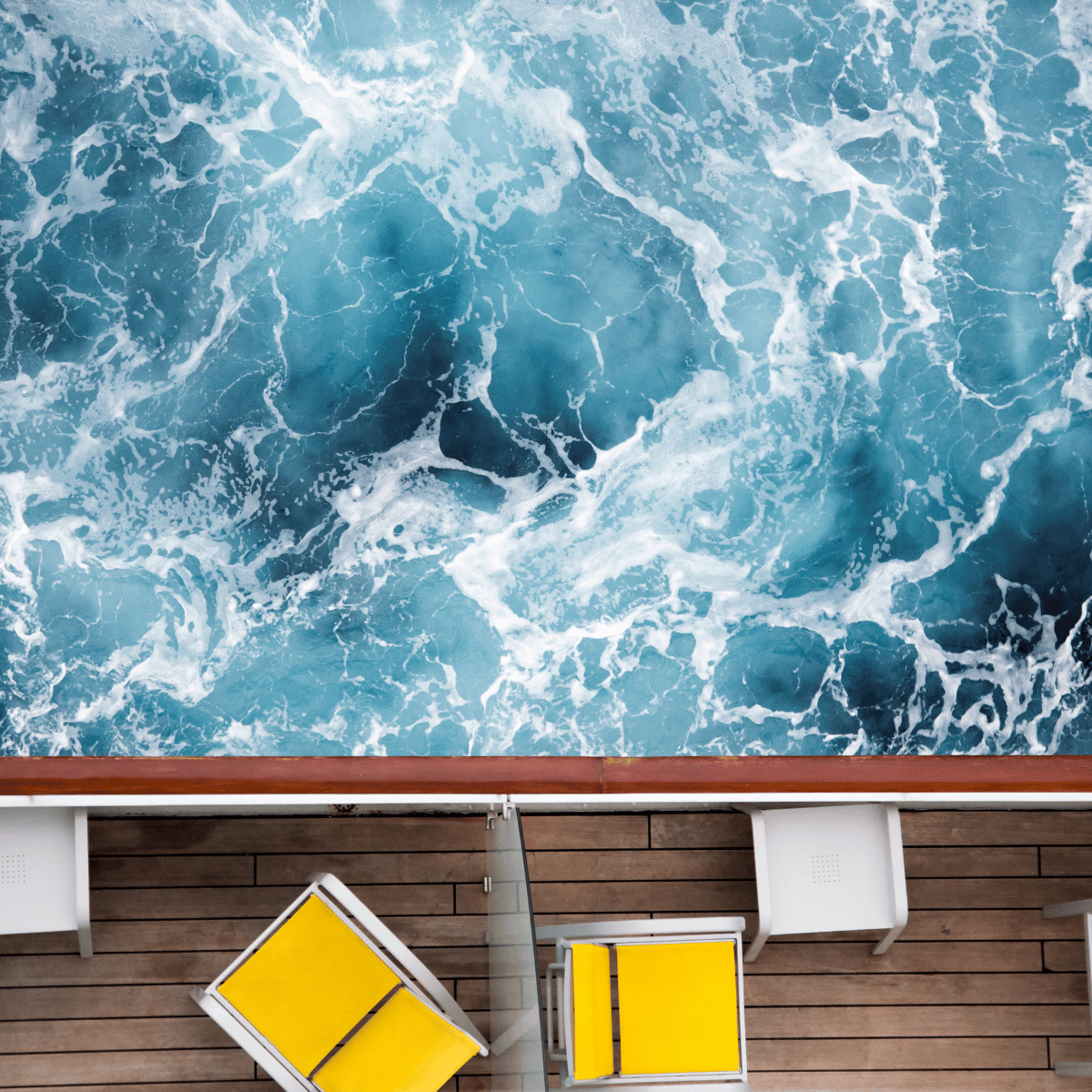
Generally speaking, smaller cruise ships tend to sit lower in the water than larger ones. This is because they have less buoyancy and are more susceptible to being swamped by waves.
Larger ships, on the other hand, tend to sit higher in the water, thanks in part to their greater size and capacity for buoyancy materials.
The depth at which a cruise ship sits in the water is an important factor for both its design and operation. Cruise ships typically sit between twelve and fifteen feet below sea level when fully loaded with cargo, fuel, and passengers.
This helps them remain stable while providing enough buoyancy for them to float.
It’s worth noting that the depth at which a cruise ship sits in the water can vary depending on the conditions.
For example, if the ship is sailing in rough seas, it may sit deeper in the water to provide greater stability.
Similarly, if the ship is carrying a particularly heavy load, it may sit deeper in the water to compensate.
How Many Decks are Underwater on a Cruise Ship?
Depending on the size and type of the cruise ship, there are typically one or sometimes two decks underwater.
These will not be deck names or numbers you’ll see on a deck plan because they are out of bounds for passengers.
The decks that are underwater are usually crew quarters, storage rooms, and machinery spaces.
These areas are not accessible to passengers and are designed to be watertight in case of an emergency.
The crew quarters are located near the bottom of the ship because they are less affected by motion and noise.
It’s important to note that the decks that are underwater do not contribute to the overall height of the ship.
The height of a cruise ship is measured from the waterline to the highest point on the ship. The decks that are underwater are not included in this measurement.
Do Cruise Ships Have Staterooms Underwater?
Cruise ships do not have staterooms underwater. While it might seem like an exciting and unique experience to stay in a room below sea level, there are several reasons why this isn’t possible.
Firstly, cruise ships are designed to be stable above water, where the majority of their weight is located. Having staterooms underwater would make the ship top-heavy, leading to stability issues and potential safety hazards.
Secondly, the underwater environment is not suitable for human habitation. The pressure and lack of light would make it difficult to create comfortable living conditions, and there would be significant safety concerns in the event of an emergency.
Finally, the logistics of building and maintaining underwater staterooms would be incredibly challenging and expensive. It’s simply not practical for cruise lines to invest in this type of accommodation.
Why Don’t Cruise Ships Have Underwater Viewing Areas?
If you’ve ever been on a cruise, you may have wondered why there aren’t any underwater viewing areas on the ship. It would be amazing to see all the marine life and coral reefs as you sail through the ocean.
However, there are several reasons why cruise ships don’t have underwater viewing areas.
It’s important to note that glass is not as strong as steel, which is needed to withstand the constant pressures of the sea. The underwater decks of a cruise ship are already fully utilized and serve the mechanical and crew needs of the ship.
Therefore, adding an underwater viewing area would require significant structural changes and potentially compromise the safety of the ship.
Secondly, the windowed area would also need frequent cleaning due to the buildup of algae and other marine organisms. This would require additional maintenance and resources, which would be costly for a cruise line.
Also, the reality is that 99% of the time, you would see nothing but disturbed water from an underwater viewing area.
The windowed area isn’t as safe as steel in an accident or under pressure, which is a significant concern when the ship is traveling through the ocean.
Overall, while it would be amazing to have an underwater viewing area on a cruise ship, it’s just not practical or safe for companies to implement.
Instead, you can enjoy the beautiful ocean views from the upper decks of the ship and participate in snorkeling or diving excursions at the various ports of call.
How Far Can a Cruise Ship Tip Over?
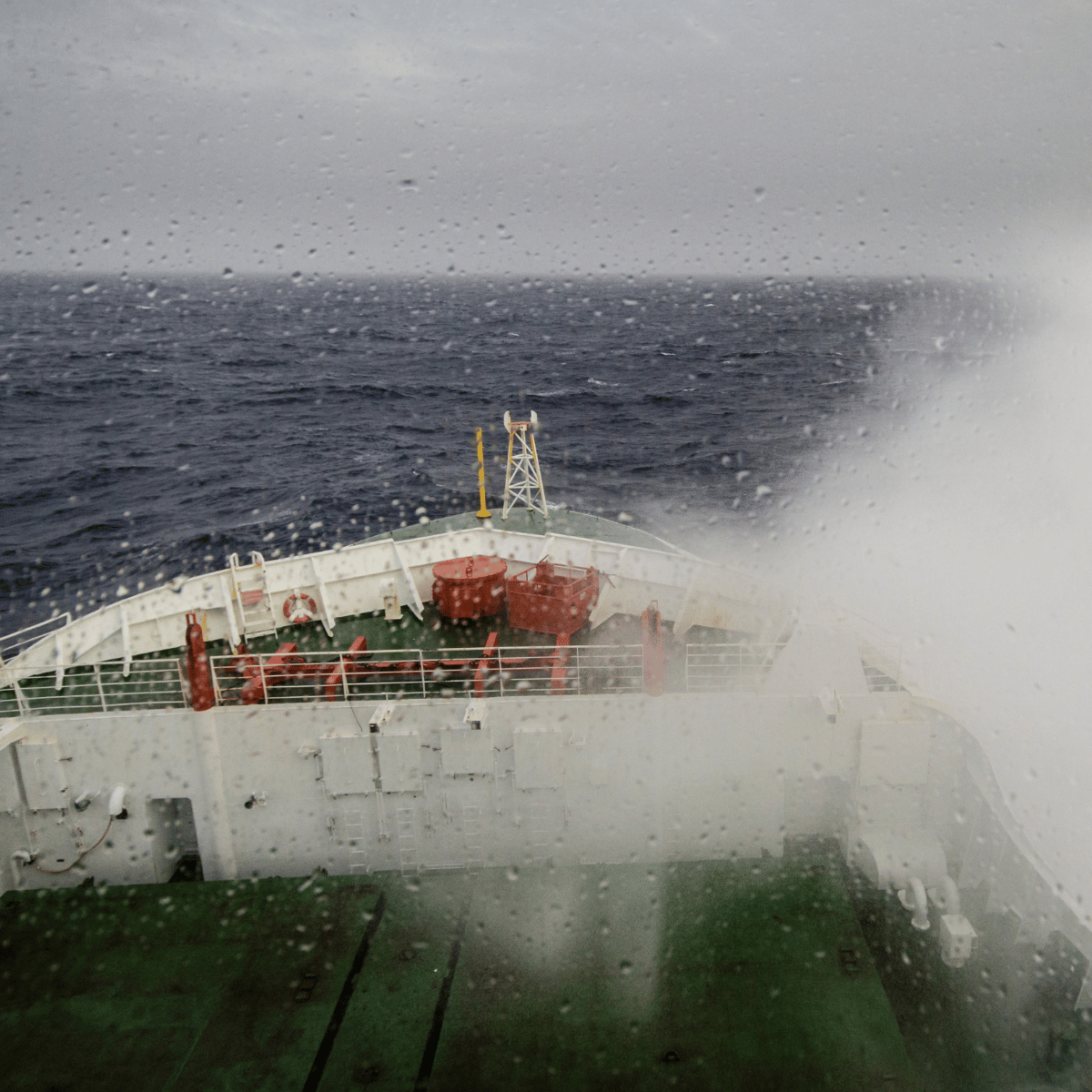
Cruise ships are built with a low center of gravity, which makes them less likely to tip over. The weight of the ship is distributed evenly, with the heaviest parts of the ship located at the bottom. This means that the ship is more stable and less likely to tip over, even in rough seas.
In fact, a cruise ship would have to tip over by more than 25 degrees before it becomes unstable . This is because the part of the hull below the surface of the water is made of much thicker, stronger, and heavier material than the superstructure. Even if the ship were to tip over, it would quickly right itself, thanks to the weight of the hull.
It’s important to note that cruise ships are also equipped with advanced stabilizers that help to reduce the amount of rolling and pitching in rough seas.
These stabilizers work by extending out from the side of the ship, creating a counterforce to the waves and reducing the amount of movement felt by passengers.
Similar Posts

6 Best Places To Cruise In November (To Sail Into Fall!)

19 Common Cruise Myths BUSTED (& Why They’re Wrong)
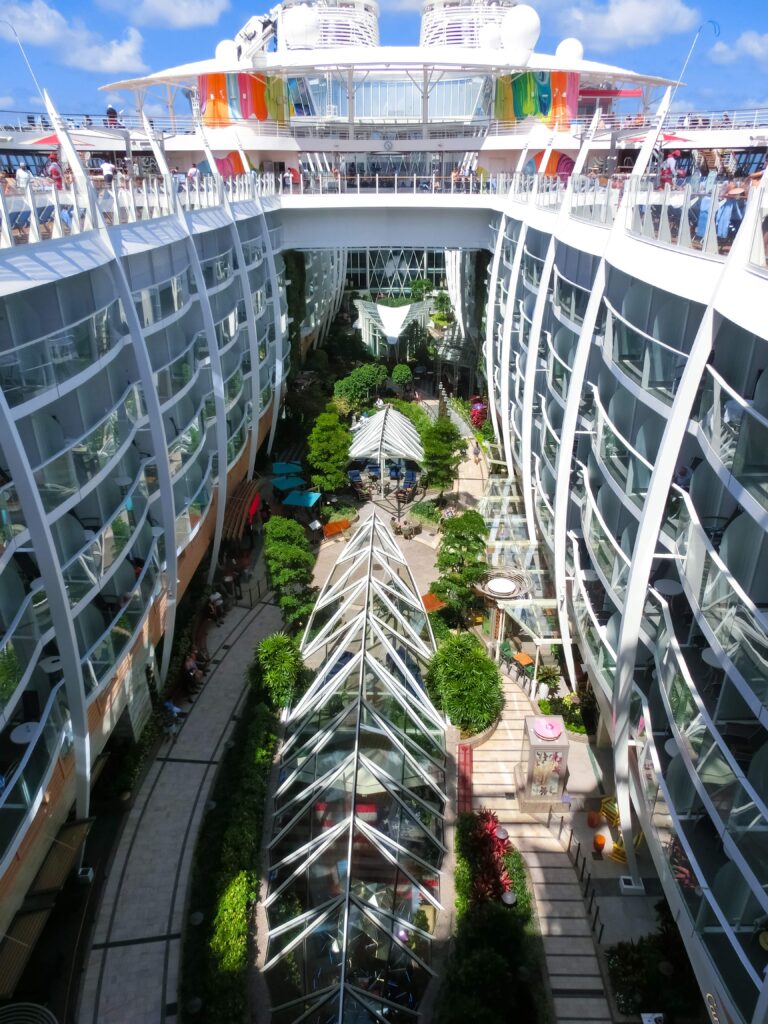
9 Cruise Ship Deck Names To Know (And What To Find On Each)

How To Sneak Alcohol On A Cruise

Walkie Talkie On Cruise Ship: Are They Allowed? Which Is The Best?!
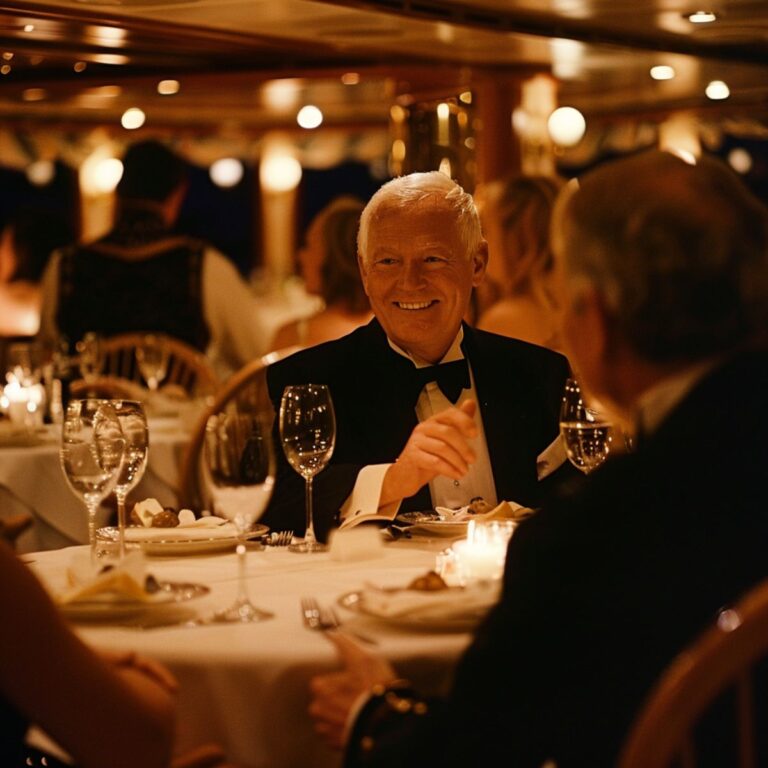
Captains Dinner on a Cruise: Is It Still A Thing?!
Leave a reply cancel reply.
Your email address will not be published. Required fields are marked *
Save my name, email, and website in this browser for the next time I comment.

How Much of a Cruise Ship is Underwater
Imagine a hidden city, submerged and unseen, beneath the ocean’s surface. As a seasoned maritime engineer with over a decade of experience in cruise ship design, I’ve explored these hidden depths firsthand.
Many travelers marvel at the towering cruise ships, yet seldom consider the vast portion beneath the waves.
This article sheds light on the surprising extent of a cruise ship’s underwater realm. It addresses your curiosity and unravels the engineering marvels below the waterline. Welcome to the unseen world of cruise ships.
Understanding the Underwater Portion of a Cruise Ship

Archimedes’ principle is key to grasping how cruise ships float. It states that a ship must displace an amount of water equal to its weight to stay stable. This principle ensures that the ship remains balanced in the water.
The design of a cruise ship’s hull is crucial for its stability. These massive ships have wide hulls to help them displace the right amount of water. On average, about 30 feet of a large cruise ship is underwater, allowing it to float and navigate safely.
Cruise Ship Weight, Length, and Height Statistics
Cruise ships are not just big; they’re enormous. Their size is a key part of their design, aimed at giving passengers a luxurious and memorable time.
The weight of cruise ships is staggering. The 50 largest cruise ships each weigh over 100,000 gross tons. That’s like the weight of around 71,000 average cars! This immense weight helps keep the ships stable and balanced in the water.
Cruise ships are also incredibly long. The four largest cruise ships, owned by Royal Caribbean International, average 325 meters in length. That’s about 20% longer than the Titanic. These huge ships have lots of room for different amenities and activities, so passengers have plenty to do while onboard.
Height of Cruise Ships
Cruise ships are not only long and heavy, but they also stand tall above the water. For instance, Royal Caribbean International’s cruise ships are about 14 decks high. From the top deck, passengers can take in stunning views of the ocean and the different ports they visit during their trip.
The Physics of Water Displacement in Cruise Ships
To know how much of a cruise ship is underwater, we need to look at the physics of water displacement. Archimedes’ principle is key here. It tells us that the upward force on an object in water equals the weight of the water it pushes aside. For cruise ships to stay stable, they must push aside water equal to their weight.
The wide hull of a cruise ship helps it displace more water. This design increases the area that pushes against the water, letting the ship move aside enough water to balance its weight. On average, about 30 feet (9 meters) of a large cruise ship is underwater, which helps keep it buoyant.
Understanding Ship Stability
Stability in a cruise ship is all about keeping the bottom heavy and the ship balanced. The design with a wide bottom helps spread the ship’s weight and lets it push away more water. This makes the ship stable and safe, even when the sea is rough, ensuring passengers are comfortable.
When building cruise ships, it’s really important to think about how much water the ship can push away and how to keep it steady. Engineers focus on these ideas to create ships that can travel safely across the ocean, offering a great experience for everyone on board.
Read: Pink Flamingo Meaning
Table: Comparison of Cruise Ship Design Features
Exploring the lowest deck of a cruise ship.

The orlop, the lowest deck of a cruise ship, is a vital area for the ship’s operations. While passengers don’t usually go here, it’s essential for keeping the ship running smoothly.
On the orlop deck, you’ll find fuel tanks that hold the fuel needed for the ship’s journey. There are also freshwater reserves for drinking, cooking, and cleaning. This deck has the laundry room, medical center, and engine rooms. The laundry room deals with all the washing for passengers and crew. The medical center is ready for any emergencies, and the engine rooms are where the ship’s engines and propulsion systems are.

Passengers generally can’t visit the orlop deck, but some might stay here to help with seasickness. Being closer to the ship’s center of gravity can make the ride smoother.

Even though passengers don’t see it, the orlop deck is crucial for a cruise ship. It has important facilities and systems that make sure the cruise goes well.
Navigating the Different Locations on a Cruise Ship
It’s important to learn the layout of a cruise ship to enjoy your trip fully. Cruise ships are huge and have many different places and features for passengers. Knowing the different areas and what they’re for can help you move around the ship more easily.
Key Locations on a Cruise Ship
Here’s a look at some important places you’ll find on most cruise ships:
- Aft: The back of the ship, where you can often find outdoor lounges and dining spots with great views of the wake.
- Bow: The front of the ship, usually with observation decks or outdoor areas for wide views.
- Bridge: The main control center of the ship, where the captain and crew steer and operate the vessel.
- Cabin: The private rooms for passengers, from simple cabins to fancy suites.
- Deck: Each level of the ship, numbered from the bottom up.
- Galley: The ship’s kitchen, where chefs make delicious meals for passengers.
- Hull: The main body of the ship, holding various compartments.
- Lido Deck: An entertainment area with pools, lounges, bars, and live music.
- Midship: The middle part of the ship, giving easy access to different areas on various decks.
- Port: The left side of the ship when you’re facing forward.
- Starboard: The right side of the ship when you’re facing forward.
- Stern: The very back of the ship, with more outdoor spots and sometimes special restaurants.
By knowing these places, you can find your way around the ship easily and enjoy everything your cruise has to offer, from relaxing by the pool to dining on gourmet food and taking in amazing views.
How Cruise Ships Navigate Different Waters

For cruise ships, it’s important to sail in water that’s deep enough, usually between 25 and 50 feet, depending on the ship’s size. The depth needed is linked to the ship’s draught, which is the distance from the waterline to the bottom of the ship. This affects how stable the ship is. In deeper water, less of the ship sticks out above the surface.
Usually, about 40% of a cruise ship is underwater, no matter how big the ship is or what the water is like. This is based on the ship’s water displacement, which is about its length, width, and draught. Water displacement is how much water the ship moves out of the way when it floats, and it’s important for keeping the ship steady and afloat.
Cruise ships use advanced technology to navigate safely. They have radar systems that help the captain see what’s around them in the water and avoid bad weather. Ships also follow certain rules for docking that depend on how deep the water is and other factors. These rules help keep the ship and passengers safe.
Navigating cruise ships in different waters needs careful planning around the ship’s size, water depth, and other factors. The design and steadiness of cruise ships are key for their safety. With their modern technology and docking rules, cruise ships can give passengers a safe and enjoyable trip, no matter the water conditions.
Frequently Asked Questions about Cruise Ships
How much of a cruise ship is underwater.
The part of a cruise ship that’s underwater, also known as the draft, varies with the ship’s size and weight. For large modern cruise ships, about 30 feet of the ship is usually underwater. Marine engineers have designed ships to displace enough water to keep them stable and prevent tipping.
How Does a Cruise Ship Stay Afloat?
A cruise ship stays afloat by pushing aside a volume of water equal to its own weight. This means the ship’s weight is balanced by the upward force of the water it moves out of the way. The hull and other parts of the ship are designed by marine engineers to help it move through the water while staying stable and buoyant.
What’s Underwater on a Cruise Ship?
The underwater part of a cruise ship includes the front, known as the bow, and other sections depending on how big and heavy the ship is. The ship’s bottom, or hull, pushes water aside to keep the ship steady.
How Much Water Does a Cruise Ship Move?
A cruise ship moves a lot of water to stay balanced. It pushes aside water about ten times its own size. For big ships, this means moving a huge amount of water to avoid tipping over.
Technology for Stability
To keep the cruise ship stable, engineers design the bottom part of the ship and use special systems. These systems help the ship stay balanced when the wind blows or waves hit. This tech is very important for a safe journey.
Stopping the Ship from Tipping
Engineers make sure the cruise ship can push aside enough water to balance its weight. This stops the ship from tipping over and keeps everyone on board safe.
How Much Water Does a Cruise Ship Keep to Stay Afloat?
A cruise ship keeps enough water to stay stable and float. Modern cruise ships are designed to push aside water equal to their weight, which keeps them from sinking or tipping over.
What Keeps a Large Cruise Ship Stable?
Large cruise ships stay stable because of the technology and design made by marine engineers. This includes the shape of the bottom part of the ship, special systems to keep it steady, and the ship’s ability to push aside enough water to stay balanced, even in different weather and sea conditions.
How Much Water Does a Modern Cruise Ship Push Aside?
Modern cruise ships are made to push aside enough water to stay afloat and steady. Depending on how big and heavy the ship is, it can push aside a lot of water. This creates a stable area that stops the ship from tipping and keeps everyone on board safe.
How Do Modern Cruise Ships Avoid Tipping and Stay Afloat?
Modern cruise ships use technology and design to make sure they push aside enough water to stay stable and avoid tipping. This, along with the ship’s weight, helps keep the ship floating and steady as it moves through the water.
Final Thoughts: The Design and Buoyancy of Cruise Ships
Cruise ships are carefully designed with special features like stabilizers and tanks for balance. These features help make sure the ship stays upright, balanced, and safe. The wide bottom part of the ship helps push aside enough water to keep it floating. Stabilizers and tanks keep the ship’s center of gravity low, which helps keep it stable.
Cruise ships are made to handle all sorts of weather, even rough seas. They have systems to help the captain steer clear of bad weather. These systems, along with the ship’s design, help keep everyone on board safe and comfortable.
Cruise ships are amazing examples of engineering. Their design and technology make sure passengers have a smooth and enjoyable trip. With a focus on staying afloat, stable, and safe, these ships let passengers relax and have fun on their vacation.
Leave a Comment Cancel reply
Save my name, email, and website in this browser for the next time I comment.

How Much of a Cruise Ship is Underwater?
When you see the size of some modern-day cruise ships, especially the mega cruise ships it’s common for people to wonder how much of the cruise ship is underwater compared to the huge amounts we see above the waterline.
The answer might come as a surprise because, in relation to the size of the cruise ship, surprisingly, little of the ship is actually underwater.
How Much of a Cruise Ship is Under water?
Usually, about 10% of a cruise ship’s overall height is under the water. This equates to about 30ft for large cruise ships. The underwater part of the ship’s hull is typically wide at the back narrowing towards the bow.
It usually correlates proportionally that the larger the cruise ship is, the deeper the cruise ship drafts will be, but on average, this will still be around 10% of the ship’s total height.
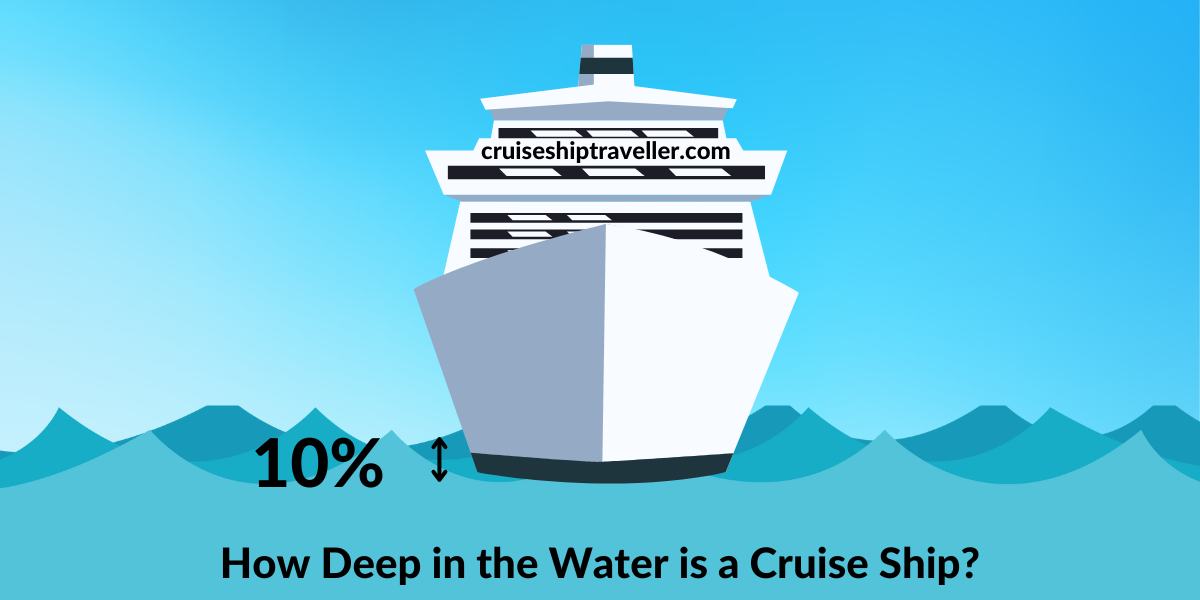
For some, this begs the next question, how do cruise ships not tip over ?
While only 10% of the cruise ship is underwater, the bulk of the ship’s weight is contained with this lower portion ensuring a low center of gravity.
The larger the cruise ship and the more decks it has, all adding to the ship’s weight, the more you can expect it to sit in the water.
How Deep Do Cruise Ships Sit In The Water?
For a cruise ship to float it must displace as much water equal to the weight of the cruise ship . This typically equates to only 10% of a cruise ship’s total height sitting in the water.
Depending on the size of the cruise ship this will be the range of 20ft to 30ft. This is known as the draft and should be marked on the cruise ship’s hull, typically on the bow and the stern.
This is a lot shallower than many other types of ships which are not as high but have deeper drafts.
The cruise ship draft is important because it determines which ports the cruise ship can enter safely without any part of the ship coming into contact with the floor of the docking area. An accident no one onboard wants to experience.
Waterline Depth Indicators on the Cruise Ship
Draft mark measurement scale.
A draft mark measurement scale can be seen on either side of the ship’s bow and stern where the waterline is, indicating the current draft level.
Here you can find out more about draft marks .
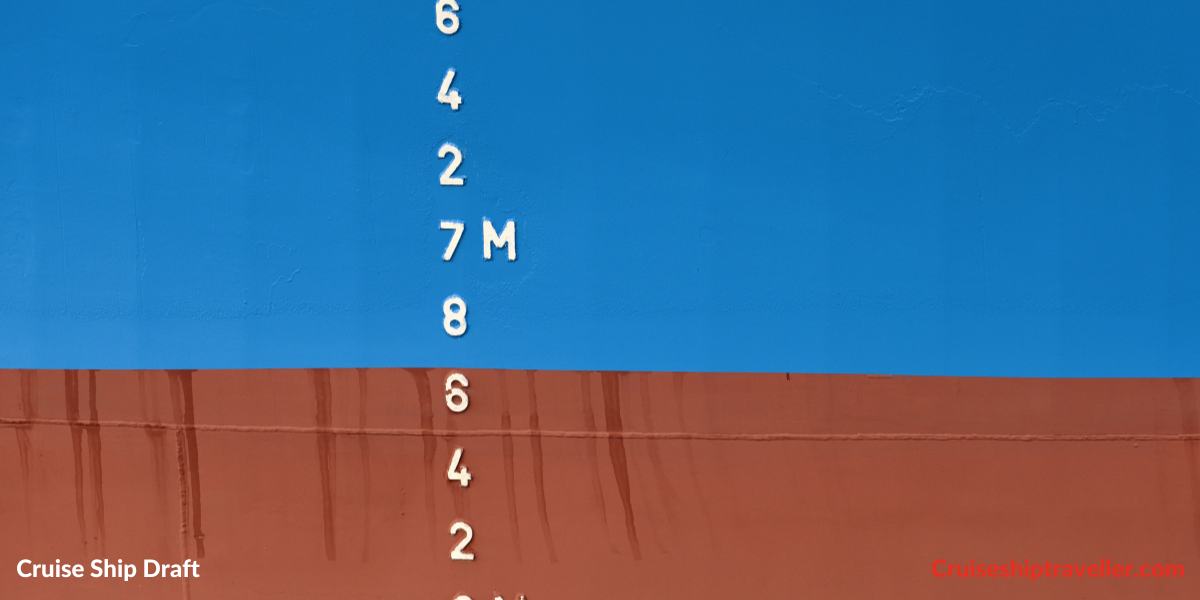
Plimsoll Lines
On the side of a cruise ship is what’s known as the Plimsoll Line. When the water line is on the plimsole line, this represents the maximum amount of weight the ship can carry.
The Plimsoll lines indicate different waterline limits for various water conditions and water types.

How Many Decks are Underwater on a Cruise Ship?
Depending on the size and type of the cruise ship, there are typically one or sometimes two decks underwater. These will not be deck names or numbers you’ll see on a deck plan because they are out of bounds for passengers.
Even if the deck plan of a cruise ship starts at Deck 1 , it doesn’t mean that it is the lowest deck on the ship. It’s just the lowest for passengers.
These lower decks will consist of hundreds of crew cabins to provide living and sleeping space for the staff who live onboard.
The lower decks also need to house the following:
- Various engine and mechanical rooms
- Food storage units
- Medical Center
- Crew-only social rooms
The Majority of Ships Weight is Underwater
The majority of the cruise ship’s weight is underwater, this maintains the ship’s low center of gravity which is a vital factor for keeping the ship stable and upright and preventing the cruise ship from tipping over.
Fuel and freshwater tanks can hold thousands of tonnes.
Machinery and masses of plumbing in the engine rooms, as well as air conditioning, take up vast areas and add considerable weight to the lowest desks.
Do Cruise Ships Have Staterooms Underwater?
There are no staterooms under the water level on any cruise lines. There are only cabins for crew members to live and sleep in. These are quite small and windowless.
We have covered more depth here underwater rooms on a cruise ship , including rare occurrences that offer an ocean view.
Related Reads:
- How Cruise Ships Get Launched into the Water
What Parts of a Cruise Ship Are Underwater?
On the bottom of a cruise ship , various features are out of sight when the cruise ship is underwater.
Bulbous Bow
At the bow, cruise ships have a bulbous bow, a large projection that extends out and modifies the water flowing down the side of the hull.

At the stern, you will find the propellors designed to push through the water to propel forwards or even backward in some cases.
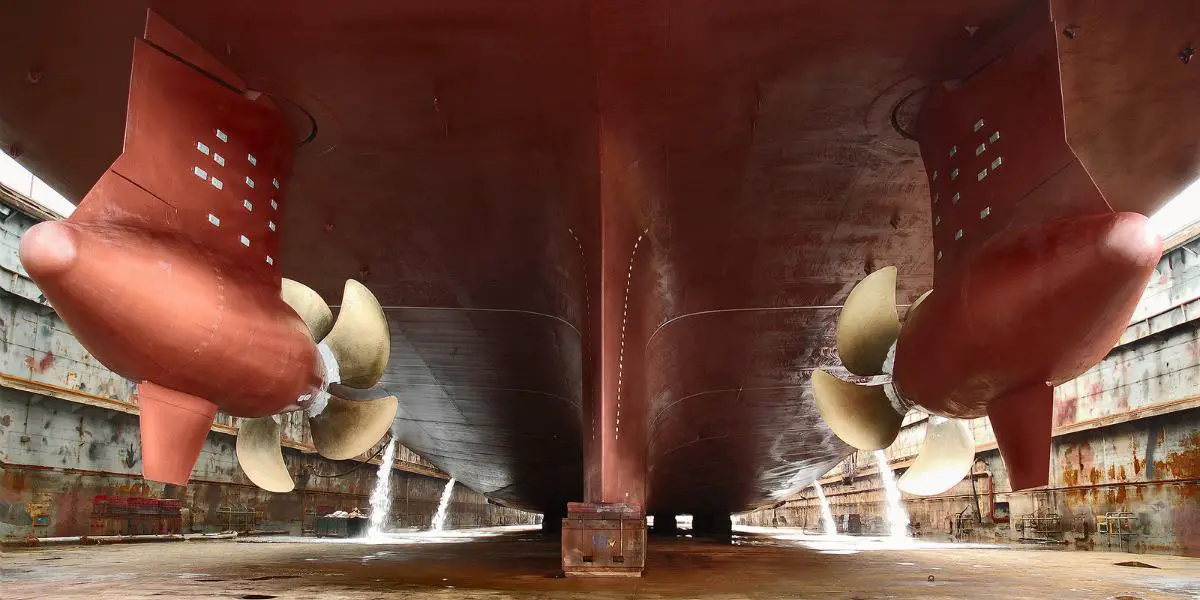
Cruise ships tend to have wide U-shaped hulls that are under the water. These displace large amounts of water which increases the buoyancy force required to keep such large, heavy vessels afloat .
How Much Water Does a Cruise Ship Need to Dock?
A cruise ship will generally need an extra 3 to 4 meters or 9 to 12 ft on top of the ship’s draft to dock.
If a cruise ship has a 30ft draft, it would need water depths of at least 40ft to sail safely. The extra depth is to allow for the ships bouncing movement in the water.
Related Posts

What is the Draft of a Cruise Ship? (and Why Does it Matter?)

How Many Doors on a Cruise Ship? (Yes, I Counted)
Leave a comment cancel reply.
Your email address will not be published. Required fields are marked *
Save my name, email, and website in this browser for the next time I comment.

How Much of a Cruise Ship Is Underwater? (Infographic)
How Much of a Cruise Ship Is Underwater?
When you see a cruise ship docked in a port, it’s hard to imagine that most of the vessel is actually underwater. But it’s true! The average cruise ship has a draft of about 25 feet, meaning that about two-thirds of its hull is submerged. This is necessary for stability, as the ship’s weight needs to be distributed evenly across the water.
But how much of a cruise ship is underwater when it’s sailing? The answer to this question depends on a number of factors, including the ship’s size, weight, and speed. In general, the larger and heavier the ship, the deeper it will sit in the water. And the faster the ship is moving, the less of it will be submerged.
So, if you’re ever wondering how much of a cruise ship is underwater, just remember that it’s a lot more than you might think!
Cruise ships are massive vessels that can carry thousands of passengers and crew. They are designed to travel long distances across oceans, and they must be able to withstand the harsh conditions of the open sea.
One of the most striking things about cruise ships is how much of them is underwater. The average cruise ship is about 20% underwater, but this can vary depending on the size of the ship and the draft (the depth of the ship below the waterline).
In this article, we will take a closer look at the different parts of a cruise ship and explore how much of each part is underwater. We will also discuss the factors that affect the draft of a cruise ship and how this affects the amount of the ship that is submerged.
The Different Parts of a Cruise Ship
The different parts of a cruise ship can be divided into three main categories:
- The engines and other facilities
The hull is the main body of the ship and it is responsible for providing buoyancy and stability. The hull is made of steel and it is divided into several watertight compartments. This helps to prevent the ship from sinking if one of the compartments is flooded.
The hull of a cruise ship is typically about 20% underwater. This is because the hull needs to be deep enough to provide enough buoyancy for the ship to float. The draft of a cruise ship can vary depending on the size of the ship and the amount of cargo that it is carrying.
The decks of a cruise ship are the platforms that provide space for passengers and crew to move around. The decks are typically arranged in a tiered fashion, with the lowest decks being closest to the waterline.
The decks of a cruise ship are typically about 80% above the waterline. This is because the decks need to be high enough to provide enough space for passengers and crew to move around comfortably. The height of the decks can also vary depending on the size of the ship and the amount of amenities that it has.
The Engines and Other Facilities
The engines and other facilities of a cruise ship are located in the lower part of the ship. This includes the engine room, the boiler room, the electrical room, and the storage areas.
The engines and other facilities of a cruise ship are typically about 60% underwater. This is because the engines and other facilities need to be located close to the waterline in order to be efficient. The location of the engines and other facilities can also vary depending on the size of the ship and the type of engines that it has.
The average cruise ship is about 20% underwater. This can vary depending on the size of the ship and the draft (the depth of the ship below the waterline).
The deepest part of a cruise ship is usually the keel, which is the lowest point of the ship. The keel is typically about 10% underwater.
The amount of a cruise ship that is underwater also affects the stability of the ship. A ship that is too deep in the water will be less stable than a ship that is closer to the surface. This is because the weight of the water that is displaced by the ship helps to keep the ship afloat.
The different parts of a cruise ship can be divided into three main categories: the hull, the decks, and the engines and other facilities. The hull is the main body of the ship and it is responsible for providing buoyancy and stability. The decks are the platforms that provide space for passengers and crew to move around. The engines and other facilities are located in the lower part of the ship and they include the engine room, the boiler room, the electrical room, and the storage areas.
The amount of a cruise ship that is underwater affects the stability of the ship. A ship that is too deep in the water will be less stable than a ship that is closer to the surface. This is because the weight of the water that is displaced by the ship helps to keep the ship afloat.
How Much Cruise Ship Is Underwater?
Cruise ships are designed to have a large portion of their hull underwater. This is for a number of reasons, including stability, resistance to waves, and fuel efficiency.
The weight of the water displaced by a cruise ship helps to keep it stable. This is because the upward force of the water (buoyant force) is equal to the downward force of the ship’s weight. If the ship were to tip too far, the water would flow to the opposite side and right it back up.
Resistance to Waves
The underwater portion of a cruise ship helps to reduce the impact of waves. This is because the waves travel more slowly through water than they do through air. The underwater portion of the ship acts as a buffer, absorbing the energy of the waves and preventing them from rocking the ship too much.
Fuel Efficiency
The underwater portion of a cruise ship helps to improve fuel efficiency. This is because the water provides a layer of insulation that helps to reduce drag. Drag is the force that opposes the motion of a ship through water. The less drag a ship has, the more efficient it is.
The Safety Implications of Cruise Ships Being Underwater
There are some safety implications associated with cruise ships being underwater. These include:
- Increased risk of sinking
- Difficulty in evacuating passengers in an emergency
- Potential for environmental damage
Increased Risk of Sinking
The underwater portion of a cruise ship is not as well protected as the above-water portion. This is because the water is more corrosive than air. If the underwater portion of the ship is damaged, it could lead to the ship sinking.
Difficulty in Evacuating Passengers in an Emergency
If a cruise ship sinks, it is more difficult to evacuate passengers from the underwater portion of the ship. This is because the water pressure is greater underwater, and it is difficult to open doors and windows.
Potential for Environmental Damage
The underwater portion of a cruise ship can damage the environment. This is because the ship can release pollutants into the water. The ship can also create noise pollution, which can harm marine life.
Cruise ships are designed to have a large portion of their hull underwater. This is for a number of reasons, including stability, resistance to waves, and fuel efficiency. However, there are also some safety implications associated with cruise ships being underwater. These include an increased risk of sinking, difficulty in evacuating passengers in an emergency, and potential for environmental damage.
The average cruise ship is about 75% underwater. This means that the top of the ship is about 25% above the waterline. However, this can vary depending on the size and design of the ship. Some cruise ships are designed to have a higher or lower draft, which is the vertical distance between the waterline and the bottom of the ship. This can affect how much of the ship is underwater at any given time.
Why is the bottom of a cruise ship underwater?
The bottom of a cruise ship is underwater for several reasons. First, it helps to stabilize the ship and keep it from tipping over. Second, it provides a platform for the ship’s engines and propellers. Third, it helps to protect the ship from damage from waves and other debris.
How deep does a cruise ship sink?
The maximum depth that a cruise ship can sink is determined by its draft. The draft is the vertical distance between the waterline and the bottom of the ship. The deeper the draft, the more the ship will sink if it takes on water. Most cruise ships have a draft of around 20 feet, which means that they can sink to a maximum depth of around 20 feet.
What happens if a cruise ship sinks?
If a cruise ship sinks, it can have a devastating impact on the passengers and crew. The sinking of the Titanic in 1912 resulted in the deaths of over 1,500 people. In recent years, there have been several other incidents of cruise ships sinking, but these have resulted in fewer casualties.
There are a number of factors that can contribute to a cruise ship sinking, including:
- Collisions: A cruise ship can sink if it collides with another ship, a reef, or another object.
- Fire: A fire on a cruise ship can spread quickly and cause the ship to sink.
- Storms: A severe storm can cause a cruise ship to capsize or sink.
- Human error: Human error, such as a navigational error or a failure to properly maintain the ship, can also lead to a sinking.
What can I do to stay safe if a cruise ship sinks?
If you are on a cruise ship that is sinking, there are a few things you can do to stay safe:
- Stay calm. Panicking will only make things worse.
- Follow the instructions of the crew. The crew will be trained to handle a sinking ship and will be able to provide you with the best advice.
- Put on a life jacket. Life jackets are designed to keep you afloat in the water. Make sure that the life jacket is properly fitted and that you know how to use it.
- Assemble in an assembly area. The crew will designate a safe area where you can gather in the event of a sinking.
- Stay away from the ship. The ship will be unstable and dangerous after it sinks.
By following these tips, you can increase your chances of surviving a cruise ship sinking.
the average cruise ship is about 60% underwater. This means that the top 40% of the ship is above the waterline, while the bottom 60% is submerged. This design is necessary to provide stability and buoyancy for the ship, as well as to allow for the storage of cargo and fuel.
The amount of a cruise ship that is underwater can vary depending on the size of the ship, the draft of the ship, and the weight of the ship’s cargo. Smaller ships will have a lower draft and will therefore be less submerged than larger ships. Ships that are carrying heavy cargo will also be more submerged than ships that are carrying lighter cargo.
The average cruise ship has a draft of about 20 feet. This means that the bottom 20 feet of the ship is submerged. The weight of the ship’s cargo can also affect the draft of the ship. Ships that are carrying heavy cargo will have a deeper draft than ships that are carrying lighter cargo.
The amount of a cruise ship that is underwater is important for a number of reasons. The draft of the ship affects the stability of the ship, and the weight of the ship’s cargo affects the draft of the ship. These factors must be taken into account when designing and operating a cruise ship.
Author Profile

Latest entries
- January 19, 2024 Hiking How to Lace Hiking Boots for a Perfect Fit
- January 19, 2024 Camping How to Dispose of Camping Propane Tanks the Right Way
- January 19, 2024 Traveling Information Is Buffalo Still Under Travel Ban? (Updated for 2023)
- January 19, 2024 Cruise/Cruising Which Carnival Cruise Is Best for Families?

- Accommodations
- Communities
- Privacy Policy
- Search for...
How Much of a Cruise Ship Is Under Water? Explained
- by Juan Folsom

- Privacy Overview
- Strictly Necessary Cookies
This website uses cookies so that we can provide you with the best user experience possible. Cookie information is stored in your browser and performs functions such as recognising you when you return to our website and helping our team to understand which sections of the website you find most interesting and useful.
Strictly Necessary Cookie should be enabled at all times so that we can save your preferences for cookie settings.
If you disable this cookie, we will not be able to save your preferences. This means that every time you visit this website you will need to enable or disable cookies again.

How Much of a Cruise Ship Is Under Water and Why?
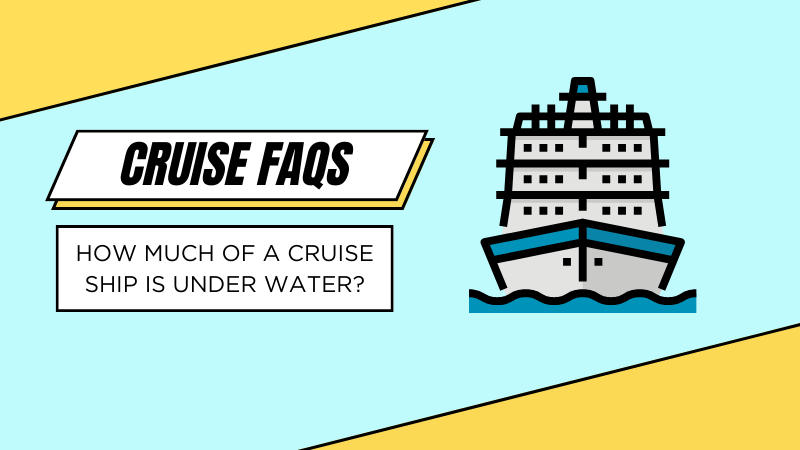
Have you ever thought about how cruise ships are like big floating cities? They’re huge and have all sorts of fancy stuff on board. It’s pretty cool, right? Yet, behind the glamour is an engineering marvel that most people overlook. One question that frequently arises is: how much of a cruise ship is under water? Understanding this not only satisfies curiosity but also sheds light on the intricate design and safety measures in place, including how fast cruise ships go .
In this blog post, we will delve into the nautical intricacies of how cruise ships float, including the typical cruise ship draft, why a cruise ship floats, and what actually goes on beneath the water line. Climb aboard as we delve into the hidden facets of these buoyant marvels.
How Is It That a Cruise Ship Remains Buoyant?
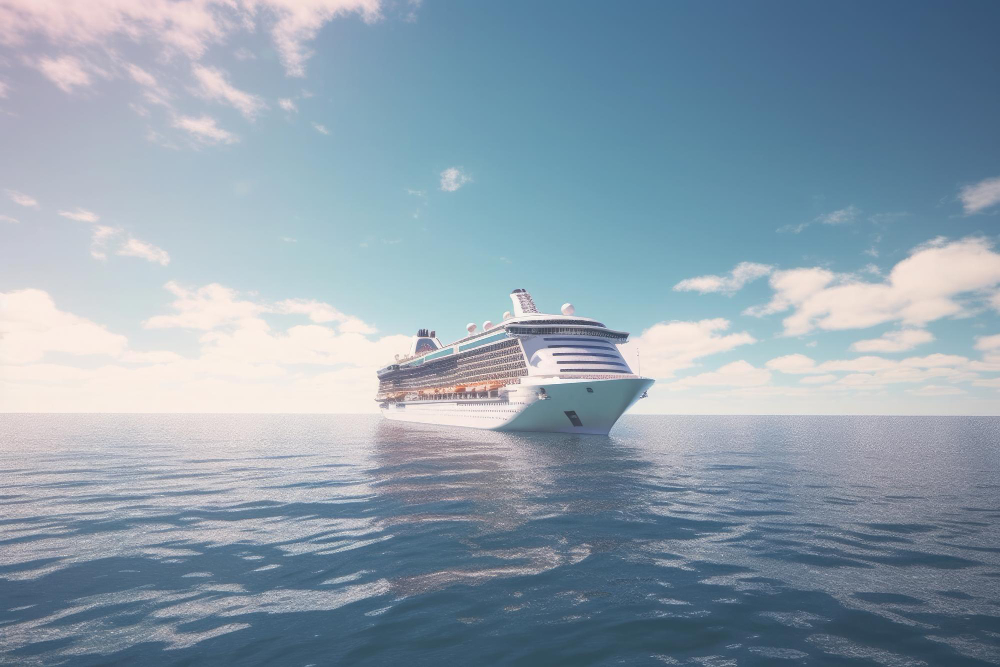
Cruise ships are fascinating because they can remain afloat despite their enormous weight and size. Archimedes’ principle is the key to their buoyancy. In essence, this rule posits that an object immersed in a fluid encounters an upward force equal to the weight of the fluid it has displaced.
Imagine a cruise ship that has a hull shaped like a “U.” This unique design causes the water to move outward and downward when the ship is in the water. As the water tries to flow back into the space, it creates energy that pushes the ship upward, helping it stay afloat. Marine engineers refer to this as ‘the first condition of equilibrium.’
So, whether it’s the grand Carnival Glory or a smaller ship, the upward buoyant force exerted on any cruise ship is precisely balanced against the weight of the ship coming into water displaced. This balancing act allows cruise ships to sail safely, even in rough seas.
This understanding of buoyancy is crucial as it directly impacts the cruise ship’s overall height, stability, and safety.
How Much of a Cruise Ship Is Under Water?
When you see a massive cruise ship gliding smoothly through the sea, it’s easy to forget that a significant portion of it is actually submerged. So how much of a cruise ship is underwater? To answer this, we look at a measurement called the draught .
The draught is the distance from the ship’s keel (the lowest point of the ship sits or hull) to the water’s surface. This varies among cruise ships, but for context, smaller ships might have a draught of around 20-30 feet. Some of the globe’s most colossal cruise liners, such as Royal Caribbean’s Symphony of the Seas, can boast a draught going beyond 31 feet.
Multiple elements play a role in determining a cruise ship’s draught:
- Shape of the Hull : The design and shape of the cruise ship’s hull play an essential role in determining the draught.
- Weight of the Ship : This includes everything from the decks underwater the engines, fuel tanks, and superstructure to amenities and cabins.
- Passenger and Luggage Weight : The combined mass of the travelers and their baggage can also have an impact on the ship’s draught.
Archimedes’ principle helped us understand that the force that keeps a ship afloat is equal to the weight of the water it displaces. For instance, Royal Caribbean’s Oasis-Class cruise ships typically displace roughly 100,000 tons of water. This means that the buoyant force needs to be at least 100,000 tons to keep the ship afloat. Let’s talk numbers for clarity:
- A typical cruise ship draft is usually around 8.8 meters (approximately 28 feet).
- Royal Caribbean’s Oasis-class ships, some of the largest in the world, have a draft of about 30 feet 7 inches.
Draught measurements are vital as they dictate the ports that a cruise ship can access. Smaller ships with shallower drafts can dock at smaller, less-touristy ports, offering a different cruising experience.
Environmental and Safety Implications
Understanding how much of a cruise ship is underwater is not just a fun fact but also has real-world implications. From an environmental standpoint, knowing the draught helps minimize damage to marine ecosystems, as ships can better avoid shallow reefs or sensitive seabed areas. Furthermore, it assists in the controlled release of ballast water, which may harbor invasive organisms.
On the safety front, understanding the draught is essential for stability, especially in rough seas. Cruise lines take this into account when determining emergency protocols and safety measures like ballast tanks and weight distribution, ensuring that your time at sea is as secure as it is enjoyable.
How Many Floors Are Below Water on a Cruise Ship?
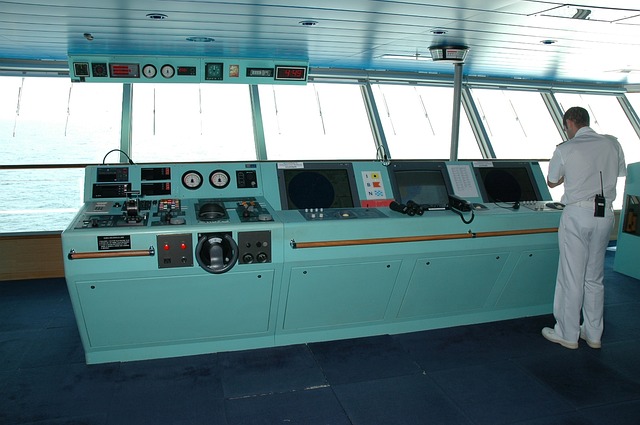
It is common to wonder about the number of floors that are situated below the waterline on a cruise ship. This varies from one ship to another, but generally, one or two decks are submerged, housing everything from the engine room to rooms and food storage to crew cabins.
For example, on many cruise ships, the first few decks are usually below water, containing essential operating components and staff accommodation. Knowing this can add a new layer of fascination as you wander through the ship, enjoying amenities that are above sea level while being aware of a whole operational world beneath you.
What Facilities Are Typically Found on a Cruise Ship Beneath the Waterline?
Cruise ships typically house essential facilities below the waterline, such as the engine room, water treatment plants, air conditioning units, fuel bunkers, water storage tanks, plumbing units, and crew cabins. Passengers do not have underwater cabins, as these areas are reserved for staff, ensuring ship safety and functionality. Deck 2, the first fully above-water deck, often serves as the embarkation point and includes food galleys, storage, and crew dining areas.
What Are the Reasons Cruise Ships Don’t Include Underwater Viewing Areas?
Cruise ships do not typically include underwater viewing areas for practical reasons. These areas would often offer a view of turbulent water, providing little to see. Additionally, the glass used for such windows would be more vulnerable to damage than the ship’s steel hull, raising safety concerns, and maintenance costs. Designing and adding these areas also require complex structural changes and pose engineering challenges. Passenger comfort and demand are limited, and the cost of building and maintaining underwater viewing areas is high. As a result, cruise ships prioritize other amenities and services, leaving specialized vessels like submarines for those seeking underwater experiences.
Is It Possible for a Cruise Ship to Experience a Rollover?
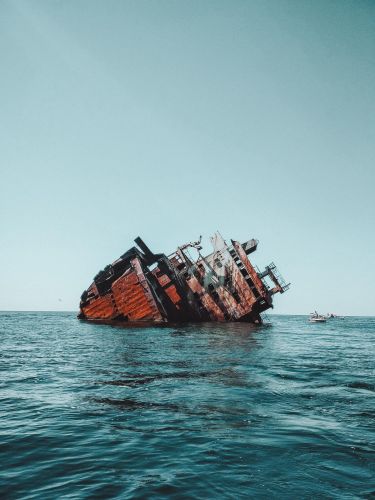
The thought of a cruise ship sinking or experiencing a rollover is the stuff of nightmares, and thankfully, it’s an extremely rare occurrence. Modern cruise ships are designed with a low center of gravity and wide hull to maximize stability. They also have ballast tanks that can be adjusted for better weight distribution, helping the ship to stay afloat even in rough waters.
Furthermore, marine engineers take into account various other safety measures, such as the division of the ship into two adjacent compartments, that can be sealed off in emergencies. So, while the physics behind it is complex, the outcome is designed for passenger safety.
What Prevents a Ship From Tipping?
When you gaze upon a towering cruise ship, you might wonder how something so massive avoids tipping over. The secret lies in the marvel of engineering that combines a wide hull , often referred to as “the water plane area,” and a low center of gravity . These two factors work in tandem to provide stability. But that’s not all. Cruise ships are equipped with ballast systems that can adjust the ship’s weight distribution by filling or emptying tanks with water.
There are also mechanical stabilizers , which extend like fins from the sides of the ship, reducing the roll when at sea. Another vital component is the bilge keels , long metal fins along each side of the ship, which help limit rolling. Rest assured, a multitude of safety measures are in place to keep the ship stable and upright.
What Are the Consequences of a Cruise Ship Tipping Over?
The idea of a cruise ship tipping over is terrifying but highly improbable, thanks to the rigorous safety measures in place. Nonetheless, should such an incident happen, the aftermath would be disastrous, spanning from the loss of life and property to environmental damage. The stability of the cruise line of ships is consistently overseen by seasoned navigational officers, who make certain that weight distribution is modified as needed to uphold safety. Though the scenario is unlikely, it underscores the importance of adhering to safety instructions during your voyage.
The Role of Ballast Systems in Keeping Ships Stable
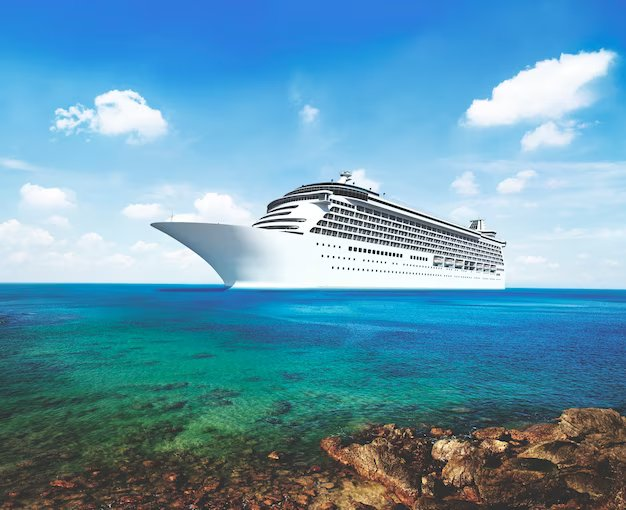
Now, you might be asking, what exactly are ballast systems? Ballast systems are specialized tanks filled with water to help regulate the ship’s stability and buoyancy . The amount of water can be adjusted to change the vessel’s center of gravity. In dire situations, the vessel’s swimming pools might even be emptied to bring down the center of gravity, thereby enhancing stability. The ballast system plays a critical role in determining how much of the ship is underwater, effectively keeping the vessel stable even in rough waters.
By managing weight effectively and employing these advanced systems, cruise ships can withstand even the toughest marine conditions. In doing so, they provide passengers and crew members with a safe and enjoyable experience while traversing the open seas.
Understanding the intricate details of why and how much of a cruise ship is underwater is nothing short of fascinating. From Archimedes’ principle governing buoyancy to the role of ballast systems in maintaining stability, cruise ships are marvels of marine engineering. These sophisticated techniques ensure the vessel’s safety, whether you’re a casual traveler sipping a cocktail by the pool or a marine engineering buff interested in the ship’s mechanics. Additionally, knowing how much cruise ships cost to build and maintain is another aspect that adds to the intrigue of these floating giants.
So why does this knowledge matter? For the everyday traveler, it offers peace of mind, knowing the extraordinary measures taken to ensure your safety at sea. For engineering enthusiasts, it provides a real-world application of scientific principles, a testament to human ingenuity. Either way, this information adds a layer of depth (pun intended!) to your cruise experience.
We encourage you to delve deeper into this subject. Perhaps the next time you’re on a cruise, you’ll appreciate not just the horizon’s beauty but also the engineering marvel you’re aboard. Happy cruising!
What part of a cruise ship is underwater?
The part of the cruise ship that’s underwater is primarily the hull, which includes the keel—the lowest point of the ship including fuel tanks, air conditioning units, laundry room, etc. This underwater section is engineered for buoyancy and stability, governed by principles like Archimedes’ law. It’s essential for keeping the vessel afloat.
How far is it from the deck of a cruise ship to the water?
The distance from the flat bottom of the deck to the water varies depending on the ship’s design and load. However, for large cruise ships like Royal Caribbean’s Oasis-class, the distance can be quite significant about 7-9 meters, often exceeding 30 feet. It can vary based on factors like weight distribution and ballast.
Is deck 3 underwater?
In most large cruise ships, Deck 3 is typically above the waterline on most ships. Nonetheless, this can fluctuate based on the design of the ship and its cargo load. It’s often where lower-level cabins and some amenities might be located but are generally not underwater.
Is deck 1 underwater?
Deck 1 is usually at or near the waterline, but not typically underwater. It’s often reserved for mechanical and operational purposes. In some smaller or differently designed ships, Deck 1 could be closer to or at the waterline and isn’t accessible to the passengers but it’s generally engineered to stay above water.
Digital Marketer
I’m Bobby Pham, but you can call me “Bobby on Cruise.” I’ve been cruising the high seas and exploring the world for years, and I’m thrilled to share my passion and expertise with you. When not cruising, I spend my time on growing my marketing agency.
About FunkyCruise

How Much Of A Cruise Ship Is Underwater? Explained.
by Judith Eve | Oct 31, 2023 | Cruise Planning & Cruiser Lifestyle

Cruise ships are a popular choice for vacations and traveling. They offer a variety of amenities, entertainment, and destinations. However, have you ever wondered how much of a cruise ship is underwater? It is a common question that many people have when considering a cruise.

The amount of a cruise ship that is underwater varies depending on several factors. It is primarily determined by the size of the ship and the amount of load being carried. Generally, about 10% of the ship's height or around 30 feet for the biggest cruise ships is underwater. The weight of passengers and crew also contributes to how much of the ship is underwater. For instance, the Symphony of the Seas cruise ship can carry 9,000 people, including passengers and crew. The average weight of US males is 199.8 pounds, and the average weight of US females is 170.8 pounds. Assume each passenger has 100 pounds of luggage.

Understanding Cruise Ships

Cruise ships are engineering marvels designed to provide luxurious and comfortable travel experiences for passengers. Modern cruise ships are massive, with some of the largest cruise ships weighing over 100,000 gross tons. These ships are designed to be stable and safe, even in rough seas .
The design of a cruise ship is critical to its performance and passenger comfort. The shape and structure of the hull, superstructure, and stabilizers are all carefully engineered to ensure the ship can handle the stresses of the ocean. The hull shape is typically flat-bottomed, with a keel that helps stabilize the ship. The superstructure is the part of the ship above the waterline and includes the cabins, restaurants, and other facilities. The stabilizers are designed to reduce the rolling motion of the ship in rough seas.
Propulsion systems are another critical component of a cruise ship. Large propellers are used to move the ship through the water, while a bulbous bow helps reduce drag and improve fuel efficiency. The materials used in construction are typically steel or aluminum, which are strong and durable.
Construction technologies have improved significantly over the years, allowing for the construction of larger and more complex cruise ships. Computer-aided design and manufacturing have made it possible to build ships with greater precision and efficiency.
Overall, the design and engineering of a cruise ship are essential to its success. Passengers expect a comfortable and safe journey, and modern cruise ships are designed to meet those expectations.
Cruise Ship Dimensions
Cruise ships are massive vessels that can range in size from small luxury ships to massive floating cities. The dimensions of a cruise ship can vary greatly depending on the ship's purpose and the number of passengers it can accommodate.
The length of a cruise ship is one of its most significant dimensions, as it determines how many passengers and crew members the ship can carry. The average length of a large cruise ship is approximately 1,000 feet (305 meters), although some ships can be as long as 1,200 feet (366 meters).
In addition to length, the height of a cruise ship is also an essential dimension to consider. The height of a cruise ship is typically measured from the waterline to the top of the ship's upper deck. The average height of a large cruise ship is approximately 200 feet (61 meters), although some ships can be as tall as 300 feet (91 meters).
Cruise ships are typically divided into several decks, with the upper decks reserved for passenger cabins and amenities such as restaurants, pools, and theaters. The number of decks on a cruise ship can vary, with some smaller ships having only a few decks and larger ships having as many as 18 or more decks.
Passenger cabins on a cruise ship can range from small interior cabins with no windows to spacious suites with balconies. The number of cabins on a cruise ship can vary greatly depending on the ship's size and purpose. For example, a small luxury cruise ship may have only 50 cabins, while a large ocean liner can have over 2,500 cabins.
Crew cabins are also an essential part of a cruise ship's dimensions, as they determine how many crew members the ship can carry. Crew cabins are typically much smaller than passenger cabins and may not have windows or portholes.
Overall, the dimensions of a cruise ship are essential to consider when planning a cruise vacation. Passengers should be aware of the ship's length, height, and number of decks, as well as the size and location of their cabin to ensure a comfortable and enjoyable cruise experience.
The Underwater Part of a Cruise Ship

When it comes to cruise ships, many people wonder how much of the ship is underwater. The answer is that it varies depending on several factors, such as the size of the ship, the amount of load being carried, and the water depth. On average, about 10% of a cruise ship's height is underwater, but this can be more or less depending on the ship's draft.
The draft of a ship is the distance between the waterline and the bottom of the ship's hull. If a cruise ship has a 30ft draft, it would need water depths of at least 40ft to sail safely. The extra depth is to allow for the ship's bouncing movement in the water. The weight of the ship is also distributed to maintain a low center of gravity, which helps to keep the ship stable.
Many cruise ships also have underwater viewing areas, which allow passengers to see the underwater world without getting wet. These areas are typically located at the bottom of the ship's hull and are made of reinforced glass or acrylic. Some ships even have submarines or underwater drones that can take passengers on guided tours of the ocean floor.
It's important to note that the amount of the ship that is underwater does not affect its stability. Cruise ships are designed to withstand rough seas and high winds, and their weight distribution and ballast systems ensure that they remain upright in all conditions. So, passengers can rest assured that they won't tip over, even if a large portion of the ship is underwater.
In conclusion, while a significant portion of a cruise ship is underwater, it is designed to be that way. The ship's draft, weight distribution, and ballast systems ensure that it remains stable and safe in all conditions. And with the addition of underwater viewing areas, passengers can get a glimpse of the underwater world without ever leaving the ship.
Physics and Buoyancy of Cruise Ships
Cruise ships are massive vessels that are designed to float and carry thousands of passengers and crew members. The physics of cruise ships is based on the principles of buoyancy, displacement, and stability. When a cruise ship is in the water, it displaces a large amount of water based on its weight and size. This displacement creates an upward force known as buoyancy, which helps the ship to stay afloat.
Archimedes' principle states that the buoyant force acting on a submerged object is equal to the weight of the fluid displaced by the object. This principle applies to cruise ships as well. The shape of the hull plays a crucial role in displacement. Cruise ships have a U-shaped hull that displaces thousands of tons of water. The weight of the ship and the weight of the water displaced by the hull determine the buoyancy force acting on the ship.
The stability of a cruise ship is also important. The center of gravity of the ship must be low to ensure that the ship remains stable in the water. The weight distribution of passengers and cargo on the ship must be carefully managed to maintain the ship's stability. If the center of gravity is too high, the ship may tip over and capsize.
The water displacement of a cruise ship is also an important factor in its design. The draft or draught of a ship is the distance between the waterline and the bottom of the hull. The draft of a ship affects its maneuverability and stability. The deeper the draft, the more stable the ship is in the water.
In summary, the physics of cruise ships is based on the principles of buoyancy, displacement, and stability. The weight, shape, and distribution of weight on the ship affect its buoyancy and stability. The draft of the ship affects its maneuverability and stability. By understanding these principles, cruise ship designers can create vessels that are safe, stable, and comfortable for passengers and crew members.
Safety and Stability Features
Cruise ships are designed with safety and stability in mind. The hull of a typical ship is either U-shaped or V-shaped, which helps to displace as much water as possible and create upward pressure, known as buoyancy. Larger cruise ships typically have U-shaped hulls. The shape and design of the hull are critical to its safety, stability, and efficiency. The hull is designed to withstand the forces of the ocean and reduce the impact of waves and wind. The shape of the hull helps to displace water and reduce drag, while the keel provides stability and prevents the ship from rolling over.
In addition to the hull design, modern cruise ships have safety features such as watertight compartments. These compartments are separated by bulkheads and are designed to prevent water from flooding the entire ship in case of a breach. The compartments are also designed to be self-sufficient, meaning that they have their own power and ventilation systems.
Weight distribution is also a crucial factor in the stability of a cruise ship. The ship's designers carefully consider the placement of heavy items such as engines, fuel tanks, and water tanks to ensure that the weight is distributed evenly throughout the ship. This helps to prevent the ship from listing or tipping over.
Finally, cruise ships are equipped with safety features such as lifeboats, life rafts, and life jackets. These items are strategically placed throughout the ship and are easily accessible in case of an emergency.
Overall, the safety and stability features of modern cruise ships are designed to ensure the safety of passengers and crew. From the hull design to the placement of heavy items, every aspect of the ship is carefully considered to prevent tipping and ensure a smooth and safe voyage.
Maintenance and Damage Control
Cruise ships require regular maintenance to ensure their safety and longevity. This includes routine inspections of the hull, engines, and other critical systems. Any damage or wear and tear must be repaired promptly to prevent any further issues.
One of the most significant concerns for any cruise ship is the possibility of damage to the hull. While modern cruise ships are designed to withstand most impacts, accidents can still happen. In the event of a collision or other damage, the ship's crew will take immediate action to assess the situation and make any necessary repairs.
Damage control procedures are critical in the event of a hull breach or other serious damage. The crew will work quickly to contain any flooding and prevent the ship from sinking. This may involve the use of pumps, patching materials, and other emergency equipment.
Regular maintenance and damage control are essential for ensuring the safety of passengers and crew on board a cruise ship. By taking these steps, the ship's operators can minimize the risk of accidents and ensure that any issues are addressed promptly and effectively.
Cruise Ship Operations
Cruise ships are complex vessels that require a lot of planning and coordination to operate safely and efficiently. From loading cargo and fuel to managing passenger accommodations and entertainment, there are many different aspects of cruise ship operations to consider.
One of the most important factors in cruise ship operations is the ship's draft, or the amount of the vessel that is submerged beneath the waterline. This draft is determined by factors such as the ship's size, weight, and load, and it plays a crucial role in the vessel's stability and maneuverability.
To ensure that cruise ships operate safely and in compliance with regulations, marine engineers and crew members work closely together to manage all aspects of the vessel's operations. This includes everything from managing fuel tanks and engine rooms to ensuring that passengers have a comfortable and enjoyable experience onboard.
In addition to managing the ship's operations, cruise ship crews are also responsible for maintaining a safe and clean environment for passengers and crew members alike. This includes managing waste and sewage, maintaining crew quarters, and ensuring that all areas of the ship are kept clean and well-maintained.
Overall, cruise ship operations are a complex and challenging undertaking that require a high degree of skill and coordination. From managing cargo and fuel to ensuring passenger safety and comfort, there are many different factors to consider when operating a cruise ship. By working together and following strict regulations and guidelines, cruise ship crews can help ensure that passengers have a safe and enjoyable experience onboard .
Cruise ships are designed to be as efficient as possible, both in terms of fuel consumption and space utilization. This means that many ships are equipped with advanced technologies and systems that help to conserve energy and reduce waste. For example, some ships use solar panels or other renewable energy sources to generate electricity, while others use advanced water treatment systems to recycle wastewater and reduce the amount of freshwater needed.
Overall, cruise ships are fascinating vessels that offer a unique blend of luxury, entertainment, and practicality. Whether you're interested in exploring exotic destinations or simply relaxing onboard, there's something for everyone on a modern cruise ship. A cruise ship offers the opportunity for an amazing vacation. So, no need to worry about how much of a cruise ship is underwater. It is perfectly safe.

Judith Eve, loves to write riveting articles on crusingtonpost.com. She hails from the sun-kissed regions of South Florida, residing within a stone’s throw of the bustling Fort Lauderdale and Miami cruise ports. As a native Floridian, Judith’s love for the ocean and cruising extends as far back as her memory can recall.
Her lifelong passion for travel has taken her to countless destinations around the globe, but cruising, undeniably, holds a special place in her heart. Judith has embraced the elegance of luxury liners, relished the intimacy of boutique ships, and marveled at the innovation found on the newest megaships. This varied experience makes her a well-rounded and knowledgeable commentator on everything cruise-related.
Balancing her writing career and family life with effortless grace, Judith is happily married, mother to two wonderful children, and a doting grandmother to three grandkids. Much like Judith, her family shares her enthusiasm for the sea, often accompanying her on cruise adventures and enriching her articles with their unique perspectives.
Her work for crusingtonpost.com provides readers with insightful, engaging narratives of her travels, from vivid descriptions of the picturesque locales she visits to in-depth reviews of the cruise lines she travels with. Her writing is not only an exploration of travel and cruising; it is a testament to her zest for life, her commitment to family, and her love for the ocean.
Endearing herself to readers with her warm, personable writing style, Judith has become a trusted voice in the cruising community. She is the go-to source for tips, advice, and comprehensive information on cruising. As a tireless explorer and devoted family woman, Judith Eve embodies the essence of the adventurous spirit, inspiring readers to set sail and create their own sea stories.

Best Mediterranean Cruise Itineraries for Families: Top Picks for Memorable Voyages
by Cruisington Post | Jul 15, 2024 | Cruise Lines & Cruise Types
Taking the family on a...

Mediterranean Cruises with Best Wine Tasting Excursions: A Sip & Sail Guide
by Judith Eve | Jul 2, 2024 | Cruise Planning & Cruiser Lifestyle
Embarking on a...

Pros and Cons of River Cruises: An Insightful Guide for Waterway Wanderers
by Judith Eve | Jun 13, 2024 | Cruise Lines & Cruise Types
River cruises offer a...

Don't Miss Out on Cruise info!
The latest Cruisington Post news delivered to your inbox.
Contact Us - Disclaimer - Curation Policy - Amazon Affiliate Disclosure - Terms and Conditions - Privacy Policy

How Much Of A Cruise Ship Is Under Water? Don’t Worry! You Won’t Tip Over.
By: Author David Chapman
Posted on Last updated: October 14, 2023
Categories LEARN
When you stand on the shore and watch the massive ships slowly appear over the horizon, it seems improbable that they float and won’t capsize, even in low-sea states. You may wonder how much of a cruise ship is under water that allows it to handle ocean conditions like hurricanes (which they deliberately stay away from) with huge waves.
Let’s take a closer look at how much of a cruise ship is under water and how they are designed for a wide range of conditions.
So, Exactly How Much Of a Cruise Ship Is Under Water?
The amount of cruise ship that is underwater ranges from 20 feet, for a smaller ship, to 31 feet for the largest vessels. It means that only 13% of the ship’s hull and superstructure is underwater, which further reinforces how incredible the technology that marine engineers have developed.
The complete design of a cruise ship is built around the economics of the vessels and the needs, safety, and comfort of the passengers. All of the engineering decisions have been made with these factors in mind, and the results are the impressive cruise ships that travel the seas.
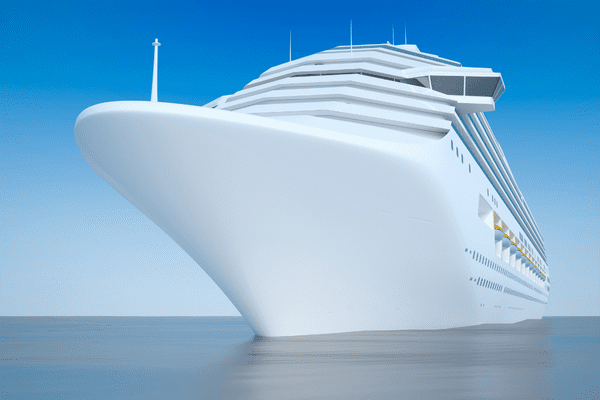
The Depth A Cruise Ship Is Under Water
To calculate how much of a cruise ship is underwater, we want to take the measurement between the cruise ship’s keel (the lowest point of the hull) and the water’s surface; this is called the draught.
The depth of cruise ships’ draught ranges from approximately twenty for smaller ships to more than thirty-one feet for one of the largest cruise ships in the world like Royal Caribbean’s Symphony of the Seas.
The measurement of the draught depends on the following factors:
- The shape of the cruise ship’s hull
- The weight of the cruise ship, including the engines, fuel tanks (whether it is full or not), the hull, superstructure, amenities, cabins, etc
- The weight of the passengers and the luggage
Archimedes was a mathematician, scientist, philosopher, and inventor born in 212 BC and lived in the city of Syracuse in Sicily.
He developed the Archimedes principle , which states that the force needed to keep the cruise ship (or any other floating item) afloat in the water must equal the weight of the water it displaces.
Royal Caribbean’s Oasis-Class generally contains the world’s largest cruise ships, such as Wonder of the Seas and Symphony of the Seas . The Oasis-Class ships have a displacement tonnage of about 100,000 tons . So those ships will displace 100,000 tons of water. (Note that displacement tonnage differs from the typically reported “gross tonnage,” which is a volumetric-based measurement.)
So, for an Oasis-Class ship, the ship will float as long as the amount of force that the water exerts back onto the cruise ship is equal to or greater than 100,000 tons.
The Shape Of The Cruise Ships Hull
The hull’s shape is a key determinant of how deep the cruise ships’ hulls are under the water (the draught).
The bigger the area of the hull which comes into contact with the water, the cruise ship bigger the surface area of the water and, therefore, the weight of the water.
As the ships do, in fact, float, it means that the upward force the water exerts on the boat is greater than the downward pressure it exerts on the water.
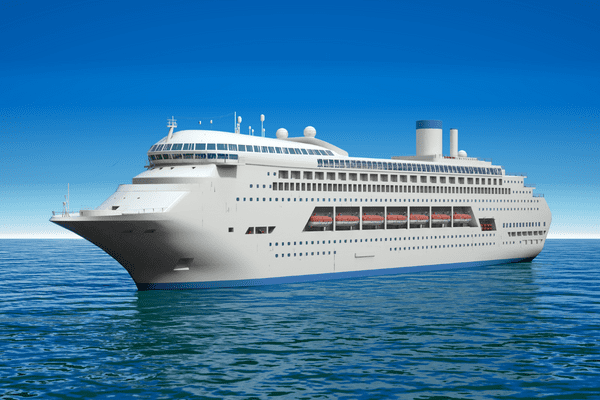
The Weight Of The Passengers
The weight of passengers on board also contributes to how much of a cruise ship is underwater.
For instance, the Symphony of the Seas cruise ship can carry 9,000 people , including passengers and crew.
The average weight of US males is 199.8 pounds. The average weight of US females is 170.8 pounds.
Assume each passenger has 100 pounds of luggage.
Assuming the ship has an equal number of male and female passengers, the weight of the passengers will roughly equate to:
- Men 899,100 pounds (500 tons)
- Women 768,600 pounds. (384 tons)
- Weight of baggage 900,000 pounds (450 tons)
The ship inhabitants, therefore, collectively weigh 1,334 tons. When the ship is completely loaded, it will sink into the water to a distance where the water weighs an additional 1,334 tons.
The effect is that the ship will sit 0.6% (or 0.72 inches) deeper.
What Facilities Are In A Cruise Ship Under Water?
In modern cruise ships, most of the “backroom” functions, and weight, are placed below the waterline and include the following:
- The engine room
- The water treatment plants (clean and dirty)
- Air conditioning units
- The fuel bunkers
- Water storage tanks
- The massive plumbing units
- Many crew cabins (Senior officers and staff are usually housed on higher decks)
On most ships, Deck 2 is the first deck fully above the water line (it may be numbered differently from one cruise line and class of class to the next) but is generally the reception area which the passengers embark and disembark from.
That deck is commonly fitted out with the food galleys and storage area, and dining room where the crew eats (the mess).
What Stops A Cruise Ship From Sinking?
The below deck areas serve two purposes regarding the ship’s flotation.
The Cruise Ship Stability
The below desk area ensures that the volumetric weight of water displaced is greater than the weight of the ship itself (Archimedes principle)
While cruise ships appear top heavy with a very small, the superstructure is relatively light, and all the heaviest equipment is placed below deck, which results in the ship being “bottom heavy” and, therefore, less prone to wild swaying or even capsizing.
They Provide Protection If The Side Of The Ship Is Holed
The ships are designed to provide a bigger buoyancy area to ensure “ two-compartment damage stability .”
It means that even if any two adjacent compartments are open to the sea, there will still be enough buoyancy to ensure that the ship will not sink.
While this is a design requirement, the ship will actually cope with worse damage.
Why Don’t Cruise Ships Have Underwater Viewing Areas?
For several reasons, it would not be realistic to have glass windows below the surface.
- Most of the time, the only view would be of disturbed water (wake), and there would be little to see.
- Even bulletproof glass would present a greater hazard of being damaged than a steel hull.
- The windowed area would also need frequent maintenance, and the cost-benefit analysis would make it uneconomic.
Closing Thoughts
Cruise ships are truly feats of engineering. How much of a cruise ship sits underwater ranges from 20 to 31 feet, depending on the size of the vessel. However, the safety and stability of a cruise ship aren’t due to the depth that it’s submerged, but rather a combination of factors such as the shape of the hull.
If you are fascinated by cruise ship facts, you may also enjoy this post .
Keep up with the latest cruise tips and insights! Follow us on Pinterest:
Related articles.
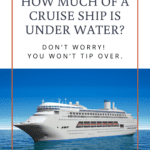

How Much of a Cruise Ship is Underwater?
How much of a cruise ship is underwater? When you see the huge Royal Caribbean International cruise ships, it’s interesting to think about their design. These ships are some of the largest in the world, and they sit about 50 meters high from the waterline to the top.
This means a big part of the ship is actually underwater to help keep it stable and balanced. They weigh over 100,000 tons and have up to 14 decks full of fun activities and places to relax, offering everything passengers need for a great vacation on the water.
In this article, we examine the activities taking place on the lower decks, present factual details regarding cruise ship measurements, and analyze the proportion of a typical cruise ship situated underwater.
Table of Contents
The principle of water displacement plays a crucial role in the stability and balance of cruise ships and other large vessels. This concept, first introduced by Archimedes and a cornerstone in the field of physics, is essential to modern hull designs .
According to this principle, a ship floats because it displaces water equal to its own weight before it starts to sink. For cruise ships, particularly those with hulls that extend about 30 feet below the water line , this is critical. It affects how the ship behaves on the surface of the water, especially when carrying thousands of passengers and heavy cargo.
The design of the hull helps distribute the weight evenly across the ship, enhancing stability and ensuring the ship maintains balance while at sea, providing a smooth ride for all onboard.
What Facilities Are In A Cruise Ship Under Water?
In modern cruise ships, most of the operational and heavy components are positioned below the waterline. These include:
- Engine room
- Water treatment plants
- Air conditioning units
- Fuel storage bunkers
- Water storage tanks
- Extensive plumbing systems
- Many crew cabins
On cruise ships , Deck 2 is very important and sits close to the water line, which helps keep the ship stable. This deck has the kitchens (food galleys) where all the meals are made before they are served in the dining room.
It also has a storage area for all the supplies and a reception area where passengers are welcomed. Deck 2 usually has places where the crew can stay, making it a busy area that helps everything on the ship run smoothly. This setup makes sure that passengers have a great time during their cruise.
Dimensions of Cruise Ships: Weight, Length, and Height
Cruise ships are massive vessels, with their weight, length, and height playing a crucial role in their design and functionality. Here are the specifics of their height, weight, and length:
1: Cruise Ship Weight
Cruise ships are truly giants of the sea. To give you an idea of just how big they are, a large cruise ship can weigh about 100,000 tons . This huge weight is very important because it helps keep the ship stable and balanced on the water.
This steadiness is essential for the comfort and safety of all the passengers on board. It’s just one of the many reasons why these ships are considered amazing feats of engineering in the maritime world.
2: Cruise Ship Height
Royal Caribbean International is known for its large cruise ships that feature 14 decks . These decks offer expansive views of the ocean and provide a variety of activities for passengers.
The height of these ships enhances the experience, allowing travelers to enjoy different perspectives and amenities as they visit various ports of call during their journey. This design maximizes both comfort and entertainment, ensuring every cruise is a memorable adventure.
3: Cruise Ship Length
Royal Caribbean International redefines the scale of modern cruise ships with vessels that stretch 325 meters in length, offering a vast range of activities and amenities. Unlike the historic Titanic, these ships provide a remarkable variety of experiences across four main activity zones, catering to thousands of passengers.
The Physics Behind Water Displacement
“At the University of Michigan, the department of Naval Architecture and Marine Engineering studies how ships, especially cruise ships, are built. They often discuss how the water displacement principle, first explained by the ancient scientist Archimedes, helps ships float.”
This principle says that a ship will float if it can push away water that weighs the same as the ship itself. Ship architects pay close attention to the draft of the ship, which is how much of the hull is underwater. They make sure the draft matches the ship’s weight to keep it stable and easy to steer in the water.
Cruise Ships in Different Water Conditions
In the world of cruise ships, understanding physics and math related to displacement and draft is crucial for safe and efficient navigation. The draft of a vessel is the measurement from the water line to the bottom hull, indicating how much of the ship is submerged underwater.
This measurement is vital as it affects how a ship can sail in various water depths and handle different water currents.
For instance, a typical cruise ship might have a draft of 40 feet, which is about 40% of its overall depth from top to bottom, enabling it to manage water displacement efficiently. This percentage helps ensure the ship maintains balance and stability in varying waters.
Knowing these percentages and ratios allows cruise ships to optimize their design for different types of sea conditions, making them less susceptible to risks associated with deep or turbulent waters.
Understanding these factors in relation to one another ensures that all parts of the ship function harmoniously, contributing to a smooth voyage.
What’s Located on the Lowest Deck?
Cruise vessels are complex structures, typically composed of multiple decks often as many as 4 or 5 each serving distinct functions to accommodate all aboard.
The lower deck, sometimes known as the orlop, houses critical operational facilities like engine rooms, fuel tanks, and fresh water reserves, all meticulously held together with bolts and nuts.
Above, you may find crew quarters, ensuring those who work on the ship have their private spaces, along with specialized areas such as a laundry room, medical center fo r health issues including seasicknes s, and even a morgue for emergencies .
Higher decks provide accommodations and leisure activities, ensuring passengers have fun and comfort throughout their journey. Each deck is strategically designed to optimize both the safety and enjoyment of everyone on board.
Facilities on the Lowest Deck
- Focus on Engineering: Utilizes the principle of water displacement from Archimedes.
- Ship Weight: Approximately 100,000 tons.
- Ship Height: Around 50 meters from the waterline, enhancing stability.
- Physics and Stability: Advanced physics integrated into hull designs to ensure the ships are stable in the water.
- Decks: Up to 14 decks, offering extensive facilities and space.
- Purpose of Design: Ensures stable and comfortable journeys across various sea conditions by displacing enough water to support their massive weight.
Frequently Asked Questions
How much of a pirate ship is underwater.
Pirate ships had a part called the draft, which was about 6 to 18 feet underwater. This helped them sail in deep waters and close to shores.
What Is The Minimum Depth Of Water Required For Ship?
Initially, cruise ships require docking in waters that are at least 25 to 50 feet deep. The important consideration here is the draft, which is the depth from the waterline to the ship’s lowest hull point.
How Tall Is A Cruise Ship Below Water?
The ship’s draft varies based on its size, with larger tonnage ships usually having a deeper draft. Ocean cruise ships typically start with a draft of approximately 20 feet, while larger ones may have a draft ranging from 25 to 30 feet.
What Is The Draught Of A Cruise Ship?
A ship’s draft, or draught, is the depth of the vessel below the waterline. It’s measured vertically to the lowest part of the hull, propellers, or other reference point. Essentially, it tells us how deep the ship sits in the water, including any additional parts like rudders or propellers when they’re deployed.
How Much Of A Cruise Boat Is Under Water?
The hull of a cruise ship, which constitutes the outermost part of its underwater section, typically remains submerged by approximately 30-40%. This section is engineered to be watertight and capable of withstanding the ocean’s pressures.
How Much Of A Big Cruise Ship Is Underwater?
About 30 feet (9 meters) of the average large cruise ship is underwater, but as we’ll see shortly, there are easier ways to measure this.
What Percentage Of A Cruise Ship Is Underwater?
The underwater portion of a cruise ship, known as the hull, typically extends to about 30-40% below the waterline.
- 17 Best Royal Caribbean Cruise Tips and Tricks: That Enhance Your Trip
- 10 Best Royal Caribbean Ships By Size Biggest To Smallest
- 21 Must Know Do’s and Don’ts on a Cruise Ship
- Starlink on Cruise Ships: Enhanced Internet at Sea
- What is a Cruise Ship Bridge?
- Top 9 Smallest Cruise Ship in the World
Leave a Comment Cancel reply
Save my name, email, and website in this browser for the next time I comment.
Winter is here! Check out the winter wonderlands at these 5 amazing winter destinations in Montana
- Plan Your Trip
How Much Of The Cruise Ship Is Underwater
Published: December 16, 2023
Modified: December 28, 2023
by Elli Banta
- Sustainability
Introduction
When it comes to cruise ships, one question that often arises is how much of the ship is actually underwater. After all, these massive floating hotels seem to defy gravity as they glide effortlessly through the water. Understanding the design of a cruise ship can shed light on this intriguing question.
Cruise ships are marvels of engineering, carefully constructed to ensure both stability and comfort for passengers. They are designed with multiple levels and compartments, each serving a specific purpose. To determine how much of the ship is underwater, we need to examine the different areas of the vessel.
In this article, we will explore the various parts of a cruise ship and see how they relate to its position in the water. From the hull to the engine room to the passenger areas, we’ll take a comprehensive look at what lies above and below the waterline. So, let’s dive in and navigate the depths of a cruise ship’s design!
Understanding the Design of a Cruise Ship
A cruise ship is a complex structure with a design that balances functionality, stability, and aesthetics. To understand how much of the ship is underwater, it’s crucial to have a basic understanding of its design.
The ship is divided into various levels or decks, each serving specific purposes. The lower decks house essentials like the engine room, fuel tanks, and storage areas. As we move up, we encounter passenger areas, including cabins, dining rooms, entertainment venues, and recreational facilities.
The ship’s design is built around the concept of buoyancy. Buoyancy is the force that allows the ship to float on the water. The ship’s hull, which is the outermost layer, is carefully designed to displace a large amount of water, supporting the weight of the ship and its contents.
However, the exact amount of the ship’s hull that remains underwater varies depending on factors such as the ship’s size, load, and design. Generally, it is estimated that about one-third to one-half of the ship’s height is underwater. This means that a significant portion of a cruise ship remains above the waterline, providing ample spaces for passengers to enjoy breathtaking views of the ocean.
Now that we have a general idea of cruise ship design let’s delve deeper into the specific areas of the ship that are above and below the waterline.
The Hull: Below the Waterline
The hull is the most critical part of a cruise ship’s design when it comes to being underwater. It is the structure that forms the outer shell of the ship and is responsible for displacing the water around it to keep the vessel afloat.
The hull is typically made of sturdy materials such as steel or aluminum to withstand the constant exposure to water and the forces of the ocean. Its design includes a bulbous bow, which helps to reduce drag and increase fuel efficiency. The shape of the hull also plays a role in stability and maneuverability.
Below the waterline, the hull extends deep into the water. This submerged section is responsible for the ship’s buoyancy and stability. The deeper the hull extends, the more stability it provides against waves and rough sea conditions.
The area of the hull below the waterline also includes other essential components such as ballast tanks. These tanks can be filled with water or emptied to help regulate the ship’s stability and balance. By adjusting the amount of water in the ballast tanks, the ship’s operators can control its trim and ensure a smooth sailing experience for passengers.
It’s worth noting that the exact percentage of the hull below the waterline can vary depending on the ship’s design, size, and load. However, as a general estimate, it is typically around one-third to one-half of the overall height of the ship.
The hull beneath the waterline performs a crucial role in ensuring the seaworthiness and stability of the cruise ship. It’s an integral part of the vessel’s design that allows it to navigate the seas with ease, providing passengers with a safe and enjoyable cruise experience.
The Engine Room: Below the Waterline
Deep within a cruise ship lies the engine room, a critical area that plays a vital role in the ship’s propulsion and operation. Located below the waterline, the engine room is a bustling hub of machinery and systems that power the ship.
Typically, the engine room houses the ship’s main engines, generators, fuel tanks, and various auxiliary systems necessary for the ship’s functions. These systems include electrical, hydraulic, and ventilation systems that help maintain optimal conditions for operating the ship.
The engines in the engine room generate the power needed to propel the ship through the water. They drive the propellers, which provide the thrust necessary for movement. These powerful engines are often massive and can consume significant amounts of fuel to keep the ship moving efficiently.
Fuel tanks, also located in the engine room, store the vast quantities of fuel required to power the ship. These tanks are usually situated in the lower part of the vessel to maintain stability. The fuel is carefully managed and distributed to the engines as needed for propulsion.
Other systems present in the engine room include cooling systems to regulate the temperature of the engines, exhaust systems to expel smoke and gases, and monitoring systems to ensure safe and efficient operation. These systems work in harmony to keep the cruise ship running smoothly.
The location of the engine room below the waterline helps to maintain balance and stability for the ship. Placing the heavy engines and fuel tanks low in the vessel helps to lower its center of gravity, enhancing stability and reducing the ship’s susceptibility to rolling motions caused by waves.
While passengers may not have direct access to the engine room, it is an integral part of the ship’s design, powering the vessel and ensuring its smooth operation. It is a testament to the engineering expertise required to construct a complex machine that can navigate the seas reliably.
Passenger Areas: Above the Waterline
One of the most exciting aspects of a cruise ship is the variety of passenger areas available for guests to enjoy. These areas are located above the waterline, providing passengers with stunning views and a chance to immerse themselves in the beauty of the ocean.
The passenger areas on a cruise ship are designed to offer comfort, entertainment, and relaxation. They include a range of amenities, such as cabins, dining areas, lounges, theaters, swimming pools, and open decks.
Cabins or staterooms are where passengers rest and sleep during their cruise. These are typically located on the higher decks of the ship, providing breathtaking views of the surrounding sea. Cabins come in various sizes and configurations, catering to different needs and preferences.
Dining areas include restaurants, buffets, and cafes, offering a wide selection of cuisines and dining experiences. Passengers can indulge in delicious meals while enjoying panoramic views of the ocean. These areas are often designed to create a pleasant and relaxed atmosphere for dining pleasure.
Lounges and entertainment venues provide spaces for relaxation, socializing, and enjoying live performances. Passengers can unwind with a drink, engage in conversation, or be entertained by talented artists. These areas are carefully designed to create a welcoming and enjoyable environment for all guests.
Swimming pools and sun decks are popular spots for relaxation and recreation. Located on the upper decks, these areas offer stunning views as passengers take a dip in the pool or soak up the sun on lounge chairs. It’s a perfect way to unwind and enjoy the cruise experience.
Open decks provide ample space for passengers to stroll along the ship and admire the scenery. These decks offer unobstructed views of the surrounding ocean, allowing passengers to feel connected to the vastness of the sea. They often feature walking tracks, seating areas, and outdoor activities to keep guests engaged.
Passenger areas above the waterline are designed with both aesthetics and functionality in mind. The goal is to create an inviting atmosphere that allows passengers to relax and enjoy their time on board, all while being treated to magnificent views of the sea.
So, whether you’re savoring a delicious meal, lounging by the pool, or simply admiring the ocean from your cabin, the passenger areas above the waterline offer an unforgettable experience on a cruise ship.
Stabilizers: Above and Below the Waterline
Stability is a crucial aspect of cruise ship design to ensure a comfortable and smooth sailing experience for passengers. To achieve this, cruise ships are equipped with stabilizers, which are mechanisms designed to reduce the rolling motion caused by waves and keep the ship steady.
Stabilizers can be found both above and below the waterline, working together to enhance the ship’s stability. Above the waterline, retractable fins or wings are deployed from the sides of the ship. These fins act as hydrofoils that counteract the rolling motion by generating a lifting force as the ship moves through the water.
The retractable nature of these fins allows them to be adjusted depending on the sea conditions. When the ship encounters rough seas or high winds, the stabilizers can be extended to reduce the rolling motion and ensure a smoother ride for passengers.
Below the waterline, the ship may also have stabilization systems known as active stabilizers. These are typically in the form of large gyroscopes or rotating cylinders that can be controlled to counteract the movement of the ship caused by waves. These systems provide stability by using the principle of gyroscopic motion.
The active stabilizers below the waterline work in conjunction with the above-waterline fins. The combination of both systems helps to minimize the effects of rough seas, reducing the rolling motion and providing a more comfortable cruise experience for passengers.
The use of stabilizers is especially important for larger ships, as they are more susceptible to the forces of waves. By utilizing stabilizers, cruise ships can navigate through varying sea conditions with reduced movement, allowing passengers to enjoy their time on board without constant discomfort.
It’s important to note that while stabilizers significantly improve stability, they cannot completely eliminate the rocking motion entirely. In rough weather conditions, a ship may still experience some movement, albeit significantly reduced thanks to the stabilizer systems.
Overall, the combination of stabilizers above and below the waterline is a crucial aspect of cruise ship design. They work together to mitigate the rolling motion caused by waves, providing passengers with a more pleasant and stable experience at sea.
Understanding the design of a cruise ship can provide valuable insights into how much of the ship is underwater. From the hull to the engine room, passenger areas, and stabilizers, each element plays a vital role in ensuring a safe, comfortable, and enjoyable cruise experience.
The hull, located below the waterline, is responsible for displacing water and providing buoyancy to keep the ship afloat. It extends deep into the water, contributing to stability and balance in various sea conditions.
The engine room, also located below the waterline, houses the engines, fuel tanks, and systems necessary for powering and operating the ship. This area plays a critical role in propulsion and maintaining the ship’s functionality.
Above the waterline, passenger areas offer breathtaking views and a range of amenities for guests. From cabins with panoramic ocean views to dining areas, lounges, and recreational spaces, these areas are designed to provide comfort, entertainment, and relaxation.
Stabilizers, both above and below the waterline, work in tandem to minimize the rolling motion caused by waves. By utilizing retractable fins and active stabilization systems, cruise ships can enhance stability and provide a smoother sailing experience.
In conclusion, a significant portion of a cruise ship remains above the waterline, allowing passengers to enjoy stunning vistas and luxurious amenities. While the exact percentage of the ship underwater can vary depending on factors such as design, size, and load, the overall design is carefully balanced to ensure optimal buoyancy, stability, and passenger comfort.
Next time you step foot on a cruise ship, take a moment to appreciate the intricate design and engineering that goes into creating these floating marvels. Whether exploring below the waterline or indulging in the passenger areas above, a cruise ship offers a unique and unforgettable experience on the high seas.

- Privacy Overview
- Strictly Necessary Cookies
This website uses cookies so that we can provide you with the best user experience possible. Cookie information is stored in your browser and performs functions such as recognising you when you return to our website and helping our team to understand which sections of the website you find most interesting and useful.
Strictly Necessary Cookie should be enabled at all times so that we can save your preferences for cookie settings.
If you disable this cookie, we will not be able to save your preferences. This means that every time you visit this website you will need to enable or disable cookies again.
How Deep Does the Water Have to Be for a Cruise Ship?

Anyone who’s ever seen a cruise ship in person will tell you that those colossal watercrafts are nothing short of a modern marvel. But with the cautionary tale of the Titanic etched in our collective consciousness, some people might feel apprehensive about stepping aboard a modern-day cruise ship that’s twice the size of the infamous titan.
All of that said, you might find yourself wondering - how deep does the water have to be for a cruise ship? And could those things possibly tip over if the water underneath just gets a little too shallow? Here’s everything you need to know.
How Deep is the Water Under a Cruise Ship?
Now, the answer to this question isn’t really etched in stone. In fact, the numbers can actually change drastically depending on the size and the weight of the ship. Interestingly enough, the weight of a cruise ship can actually change between docking and departing, thus the depth of the water may also have to be reconsidered.
In general though, the water under a cruise ship has to be 25 to 50 feet deep. Keep in mind though that it may have to be slightly deeper than that. This takes into account the ship’s draft which is essentially the measure from the waterline along the side of the cruise ship to the lowest point of its hull.
A cruise ship with a hull that extends 25 feet into the water will need the water to be slightly deeper than that to prevent its hull from scraping the bottom. On average though, an allowance of 10 feet or thereabouts should be more than enough to accommodate the ship’s weight.
Remember though that ships tend to dip a little lower into the water when there are passengers on board. So while 35 feet of depth might be enough to accommodate an empty cruise ship that extends 25 feet into the water, it might need more allowance once the passengers start boarding.
How Deep is a Cruise Ship Underwater?
More than half of the ship (or essentially the part of a cruise ship you can actually see) is where you’ll find all of the guest amenities and staterooms that are available for cruise guests to visit. Below that are utility rooms and spaces that they like to keep out of view since they’re not really necessary for passengers to visit.
To mix things up a little though, there are some cruise ship liners that offer underwater rooms. No doubt, this can be a bit daunting. But the strange new views and the risky appeal definitely lures in guests who want a new perspective on the good old cruise ship format.
It’s important to keep in mind that the amount of ship that goes underwater depends on the weight it carries. That said, a cruise ship should be much less submerged when it’s empty as compared to when it’s full of passengers at full capacity.
Another thing that dictates how deep a cruise ship will be underwater is its displacement. This basically pertains to the amount of water it pushes out of the way so it can move forward. The deeper a cruise ship dips into the water, the higher its displacement have to be. For reference, some of the biggest cruise ships will displace about 100,000 tons of water as it moves forward to keep the vessel afloat and upright.
What Percentage of a Cruise Ship is Underwater?

So, exactly how much of the ship actually goes underwater? Well, again, the answer varies. Cruise ships come in varying sizes, so the measure of the draft can change from ship to ship. In general though, there’s about 40% of cruise ship underwater that you can’t see .
That means whatever you see above water usually only accounts for 60% of the ship’s entire size. Remember though that some ships can have more or less than 40% under the waves. But in general, the amount of ship underwater rarely ever exceeds 50% of its actual size.
Why Don’t Cruise Ships Tip Over?
With such colossal size and hefty weight, the common notion is that cruise ships struggle to float. But if that were true, then they wouldn’t exist today. In simple terms, cruise ships float because they displace the same amount of water versus how much it weighs.
To achieve this, engineers who designed the cruise ship compensated for the minimal draft by giving cruise ships an extra wide hull. This helps the ship displace more water so that it can compensate for its size and weight. In the maritime world, this type of hull is called a ‘displacement hull’ and is typically found on larger vessels like cruise ships, freighters, and naval vessels.
Another reason why cruise ships aren’t likely to just give up and sink or tip over is because they take weight distribution into careful consideration. The heftiest weight on the ship is placed at the bottom of the hull.
This is opposed to placing it somewhere towards the center or the top of the ship’s height which would make it vulnerable to tipping over under moderate winds. But what about when it’s fully loaded with guests? Well, they took that into consideration too.
You’ll notice that the different features and amenities on a cruise ship try to spread people out across the available space. This allows cruise ship operators to prevent people from congesting just one area, thus making the ship more balanced in general.
Bon Voyage!
While memories of the Titanic can haunt even the best of us, cruise ships of today are far more stable and reliable than how they were built way back when. So there’s really no need to worry. Nonetheless, if you were wondering how deep does the water have to be for a cruise ship, this quick explainer should clear up the smoke and help you feel a little less apprehensive about booking that three day cruise.
Related Posts
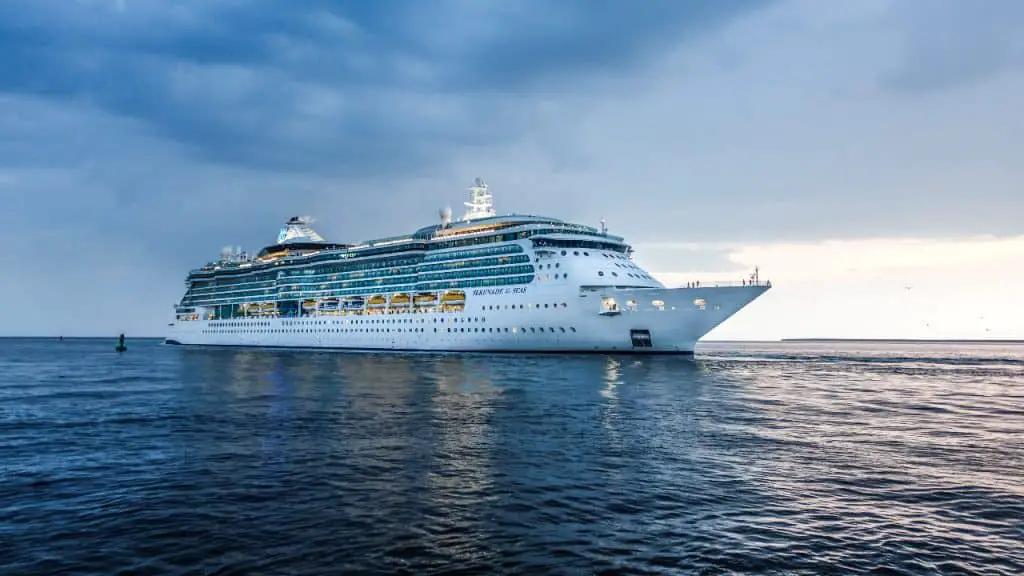
Where to Stay on a Cruise Ship to Avoid Seasickness

What is the Best Side of a Cruise Ship to Be On?

How Many People Can Fit on a Cruise Ship? (15 Examples)

How to Contact Someone on a Cruise Ship in an Emergency


How Much of a Cruise Ship Is Underwater?
Modern cruise ships are massive entertainment and leisure vessels that are places of great fun, enjoyment, and joie de vivre. They provide outlets for cruise ship passengers to enjoy various activities, from dining to drinking to music, kids’ activities, and more.
There are different sections of modern cruise ships that go from the bottom deck up to the top, sometimes 20 stories above the water. In this article, we explore what goes on on the lower decks, get some facts and figures about cruise ship measurements, and understand how much of a typical cruise ship is underwater.
In This Article…
Cruise ship weight, length, and height statistics.
How much does a cruise ship weigh, how long does it measure, and what is its height? Well, the 50 largest cruise ships in the world weigh over 100,000 gross tons . Royal Caribbean International owns the four largest ships in the world.
In terms of height, the average Royal Caribbean International cruise ship measures 14 decks (stories) high. Length-wise, these RCG ships are 20% longer than the Titanic at an average length of 325 meters (the length of several football fields).
The Physics of Water Displacement
As it applies to cruise ships, the physics of water displacement is based on Archimedes’ principle, which dictates that the amount of fluid displaced by an object equals its upward buoyant force.

To expand on this principle, according to a professor of Naval Architecture and Marine Engineering at the University of Michigan , ships have to displace an equal amount of water to how much they weigh. To do so and to stabilize the ship to prevent a draft, the ship architects designed wide hulls.
That means the vessel has to be extremely wide to compensate for the weight-to-water ratio. Approximately 30 feet (9 meters) of the average large cruise ship sits underwater, but as you’ll see below, there are more understandable ways to measure this.
What’s on the Lowest Deck?
The lowest deck on a ship usually contains the nuts and bolts of the ship. On cruise vessels, it is known as the orlop . Most of the time, the lowest deck has the morgue , fuel tanks, fresh water reserves, laundry room, medical center, jail, and engine rooms. It can also contain crew quarters.

The lowest deck is typically off-limits to passengers – the fun is all on the upper decks, and passengers tend to board at Decks 4 or 5. Sometimes, however, the lowest deck is available, and passengers can book accommodations to alleviate seasickness.
Layout of a Cruise Ship
It’s essential to understand the overall layout and structure of a cruise ship – not only to familiarize yourself with the various parts so you can navigate it well but, for this article, to understand the ship’s lower decks in context.
The following are the different locations within your average cruise ship :
- Aft – Ever heard of the “aft of a ship?” This is the penultimate backmost part of the ship, close to the stern.
- Bow – The front of the ship.
- Bridge – ”All crew to the bridge!” You can almost imagine Captain Picard from Star Trek summoning his crew to the main control section of the ship, usually found at the bow.
- Cabin – Sectioned, private living quarters. Akin to a hotel room.
- Deck – A given level of a ship.
- Galley – The kitchen, where the chefs whip up great cuisine.
- Hull – The central body of the ship.
- Lido Deck – Entertainment central! This is where the pool, bars, restaurants, and fitness center are located.
- Midship – The veritable middle of the ship!
- Port – The left side of the vessel when facing the bow.
- Starboard – The right side when facing the bow.
- Stern – The backmost part of the ship.
Navigating Cruise Ships in Various Types of Water
Knowledge is power, and knowing how captains operate cruise ships in different depths and types of water currents can help you feel safe and secure.
First of all, cruise ships must dock in water that is at least 25 to 50 feet deep . What factors in here is the draft, which is the measurement of water between the water line and the cruise ship’s bottom hull.
Thinking about how much of a cruise ship is underwater is best conceptualized as a percentage of the vessel rather than feet. The ship weighs in differently when unloaded and loaded, which affects the displacement. Therefore, the math best works out in ratios and percentages – one part of the ship in relation to another or the water underneath.

We have already conveniently determined the number of feet an average cruise ship sits below water, but what is the percentage? Approximately 40% of the average cruise ship sits below water . The larger or higher the ship, the less of it is in water. This may seem counterintuitive, but this is how math and physics work out!
This percentage is constant. When cruise ships set sail and navigate deeper and perhaps more rapid waters, still, 40% sits underwater. Now you know the ins and outs of determining a cruise ship’s displacement – and can explain it to your friends!
It’s fun to think about how much a cruise ship sits below water. As we’ve seen from our analysis, several factors go into approximating this figure. They range from how densely packed the ship is when it’s loaded or unloaded, and how large the ship is by height, width, and weight.
Read Also: Underwater Cruise Ship Rooms – What Are They?
We also discussed how much water needs to sit below the ship when it docks and learned about Archimedes’ principle of water displacement. You also found out what goes on in the lowest deck of your typical cruise ship and where most of the action happens. Lastly, we went over the different parts of the ship.
You’re now a cruise ship anatomist and amply prepared with the knowledge of how they work on the water so that your next vacation is sublime.
Related Posts
Leave a reply cancel reply.
Your email address will not be published. Required fields are marked *
🚚FREE SHIPPING ON ALL U.S. ORDERS📦

- Sailor's News
- Travel blog
- Help center
You are eligible for free shipping!
Your cart is empty
How much of a cruise ship is underwater?
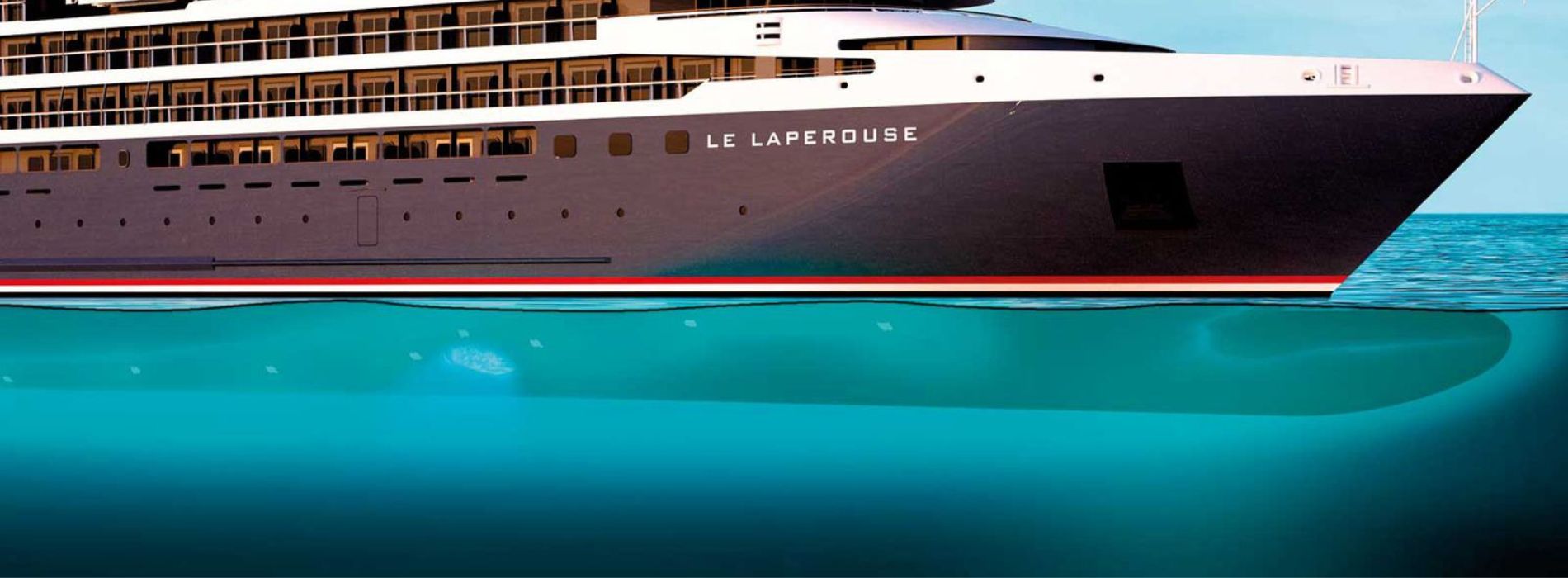
How Much of a Cruise Ship is Underwater?
The structure of a cruise ship.
A cruise ship is a magnificent vessel that is constructed to provide the ultimate experience for sea lovers. These ships are meticulously designed and engineered to float on water, with only a small portion of their total size being underwater. The majority of a cruise ship's structure is above the waterline, creating a majestic sight as it sails through the ocean.
The hull of a cruise ship, which is the outermost layer of the ship's underwater part, is typically about 30-40% submerged. This part of the ship is specially designed to be watertight and withstand the pressures of the ocean. It is made of strong materials such as steel or aluminum, ensuring the safety and stability of the vessel. The underwater hull accounts for a significant portion of the ship's weight and provides buoyancy.
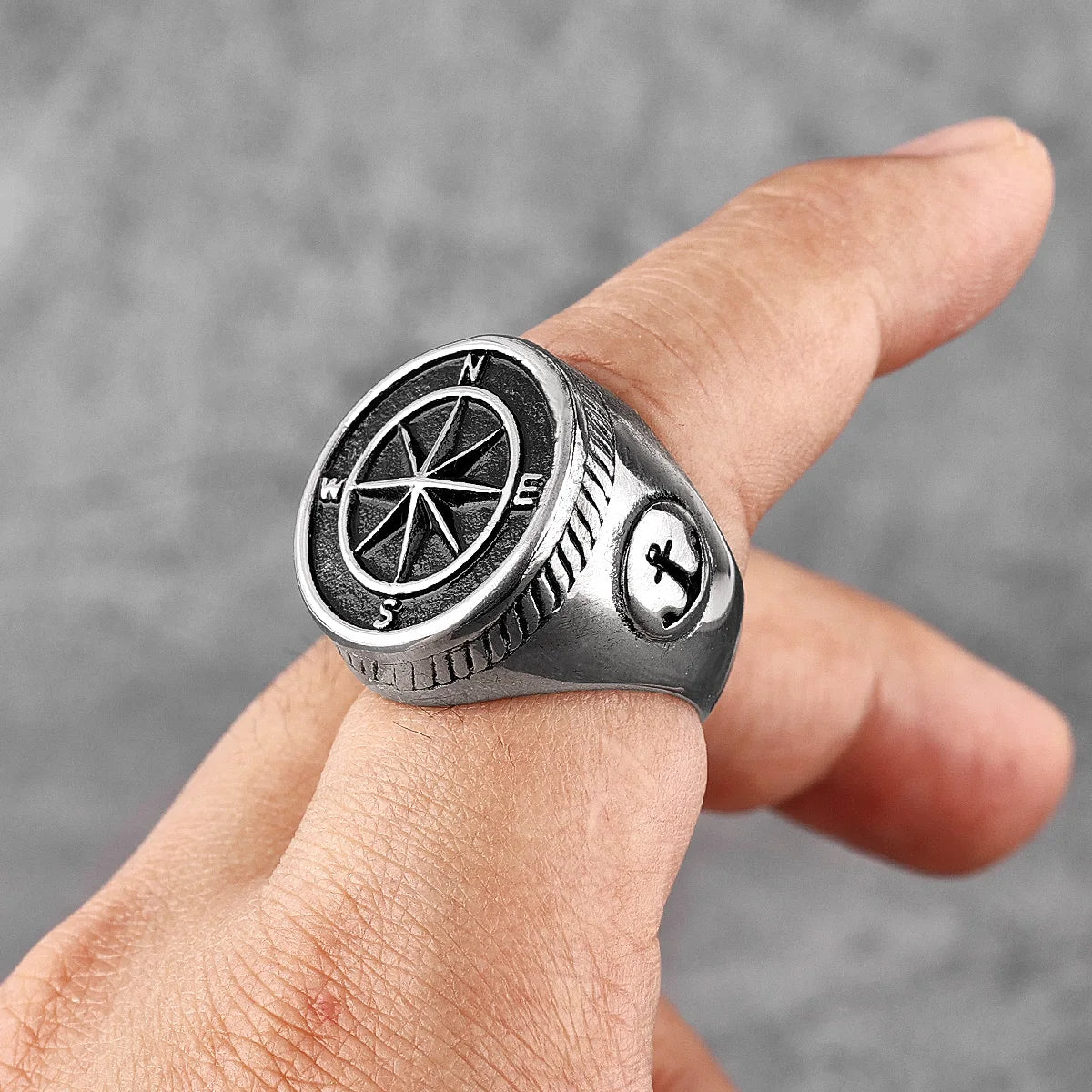
Design and Function of the Superstructure
Above the waterline, the cruise ship's superstructure rises high into the sky. This is where the cabins, restaurants, entertainment venues, and other amenities are located. The superstructure is the visible part of the ship that gives it its unique appearance and provides all the comforts and luxuries for the passengers.
The superstructure is designed to be lightweight and constructed using materials such as fiberglass, aluminum, and glass. This allows for flexibility and maneuverability, which is crucial for the ship's stability and ease of navigation. The superstructure also houses the bridge, where the captain and crew control and navigate the ship's course.
In addition to the above-water structures, there are several decks that extend outwards from the superstructure. These decks accommodate various recreational areas, pools, and lounges, allowing passengers to enjoy the sunshine and breathtaking views of the sea.
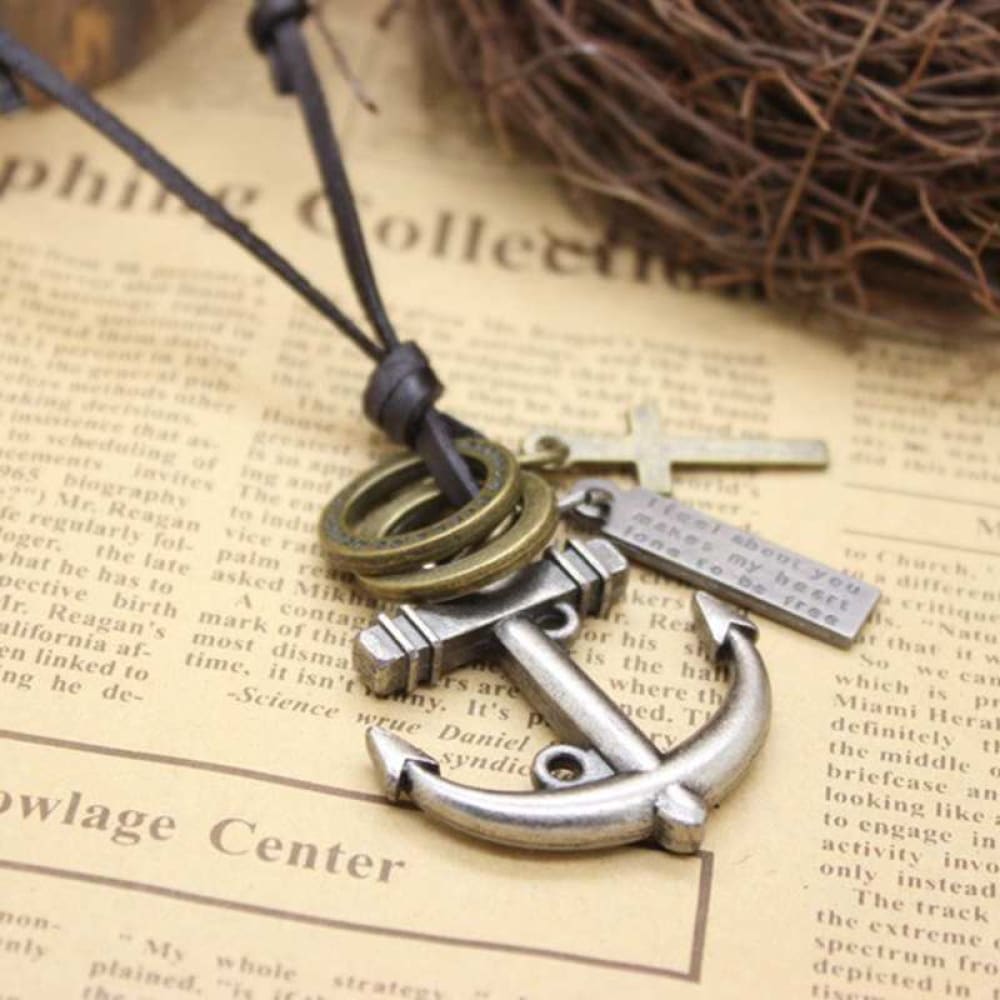
The Importance of Balancing Weight Distribution
To ensure the stability of the cruise ship, careful attention is paid to weight distribution. The weight of the superstructure, cabins, amenities, and passengers is strategically distributed throughout the ship to maintain balance. This prevents the ship from tipping over or becoming unstable in rough seas.
The underwater part of the ship, including the hull, is designed to provide ballast and stability. The weight of the underwater structure, along with the engines, fuel, and other machinery, acts as a counterbalance to the above-water structures. This allows the ship to navigate through the ocean smoothly and withstand any external forces.
Overall, a cruise ship is a remarkable engineering feat, with a small portion of its structure underwater. The majority of the ship is above the waterline, providing breathtaking views and luxurious accommodations for sea lovers.
Environmental Considerations
As passionate sea lovers, it's essential to consider the environmental impact of cruise ships. While these vessels provide incredible experiences, they also have an ecological footprint that should be taken into account.
Cruise ships are powered by engines that run on fuel, which can contribute to air and water pollution. Efforts are being made to reduce emissions and implement more sustainable practices, such as using cleaner fuels and adopting energy-efficient technologies.
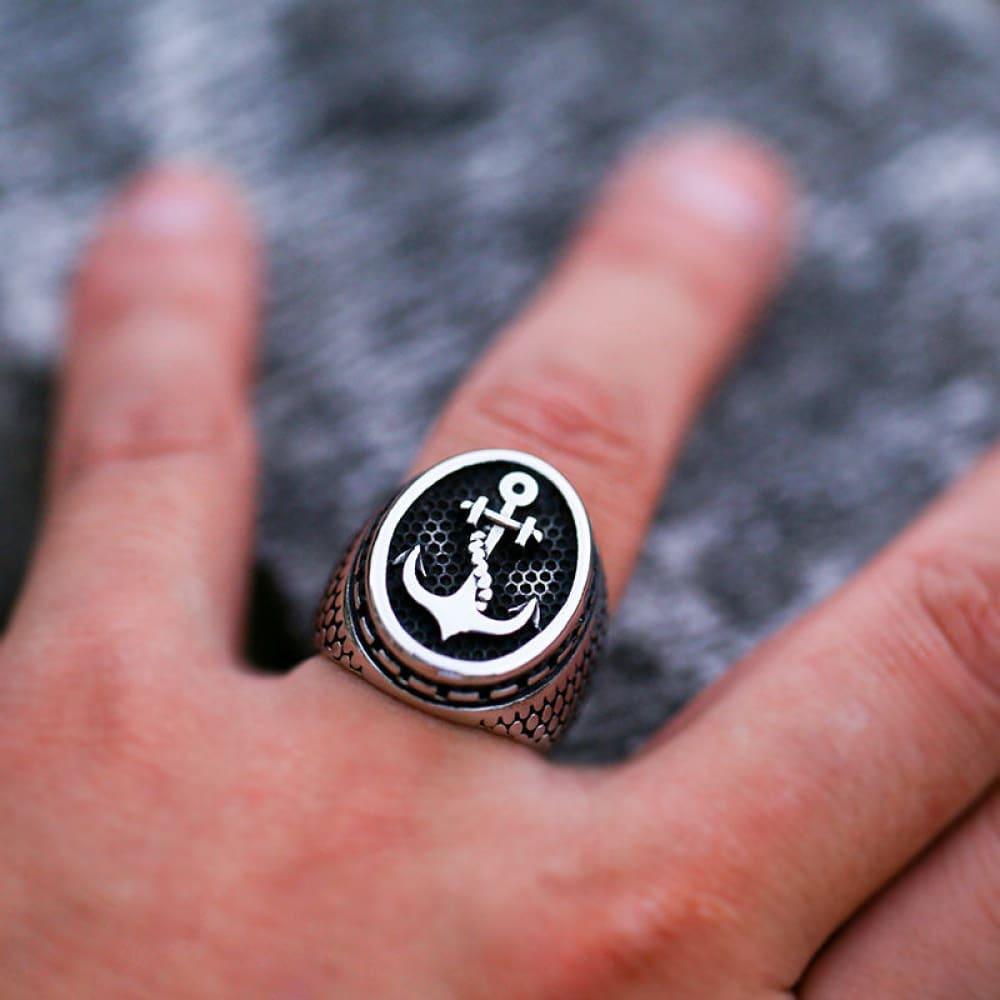
Waste Management and Conservation
Cruise ships have elaborate waste management systems in place to minimize the impact on the environment. This includes recycling, treating wastewater, and proper disposal of solid waste. Some cruise lines have also implemented conservation measures like reducing single-use plastic items and promoting responsible tourism.
Furthermore, cruise ships adhere to strict regulations concerning the discharge of wastewater and the preservation of marine life. These regulations are in place to protect fragile ecosystems and ensure that the impact on the ocean environment is minimal.
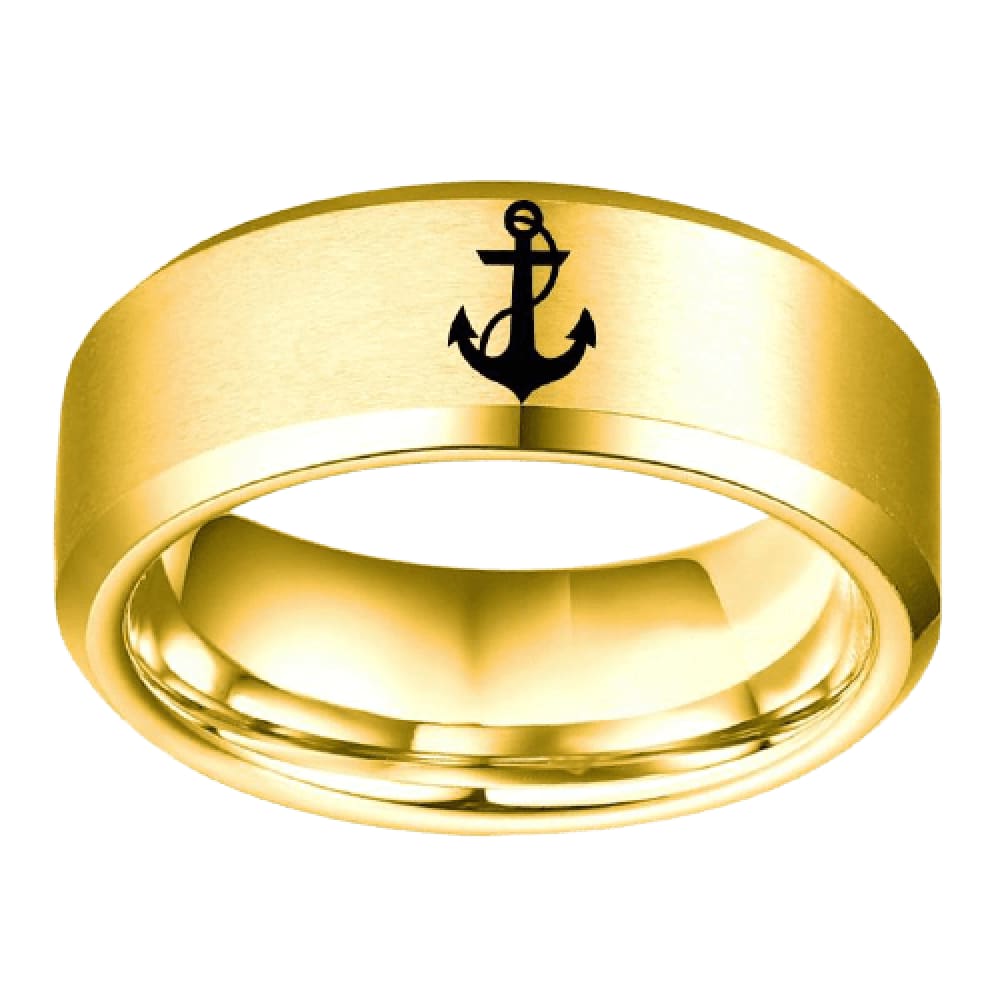
Cruise Ship Design Innovations
In recent years, there have been significant developments in cruise ship design to minimize environmental impact. New ships are being equipped with advanced wastewater treatment systems, energy-saving technologies, and even alternative propulsion methods like hybrid or electric systems.
Additionally, some cruise lines are investing in research and education programs focused on marine conservation, promoting awareness and understanding of the importance of preserving our oceans.
Cruise ships are a marvel of engineering, with only a portion of their structure being underwater. These magnificent vessels are designed to provide comfort, luxury, and breathtaking views for sea lovers. However, it's crucial to recognize and address the environmental considerations associated with cruising. As passionate ocean enthusiasts, let's continue to support sustainable practices and contribute to the preservation of our beautiful seas.
Leave a comment
All comments are moderated before being published
Hop on our boat!
Sign up to be the first to learn about our new blog posts and get a 20% discount coupon code for our nautical jewelry e-shop!
100% free, unsubscribe at any time!
Follow us on social media
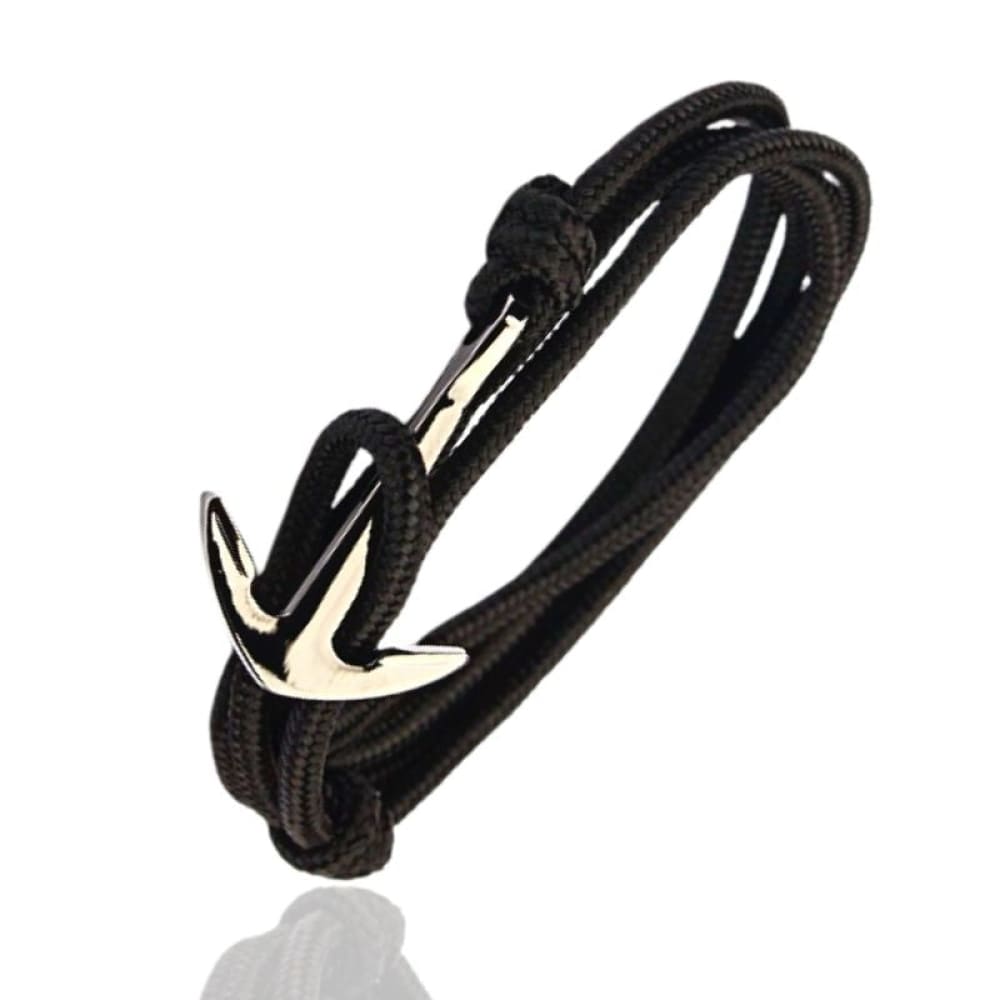
Our Favourites
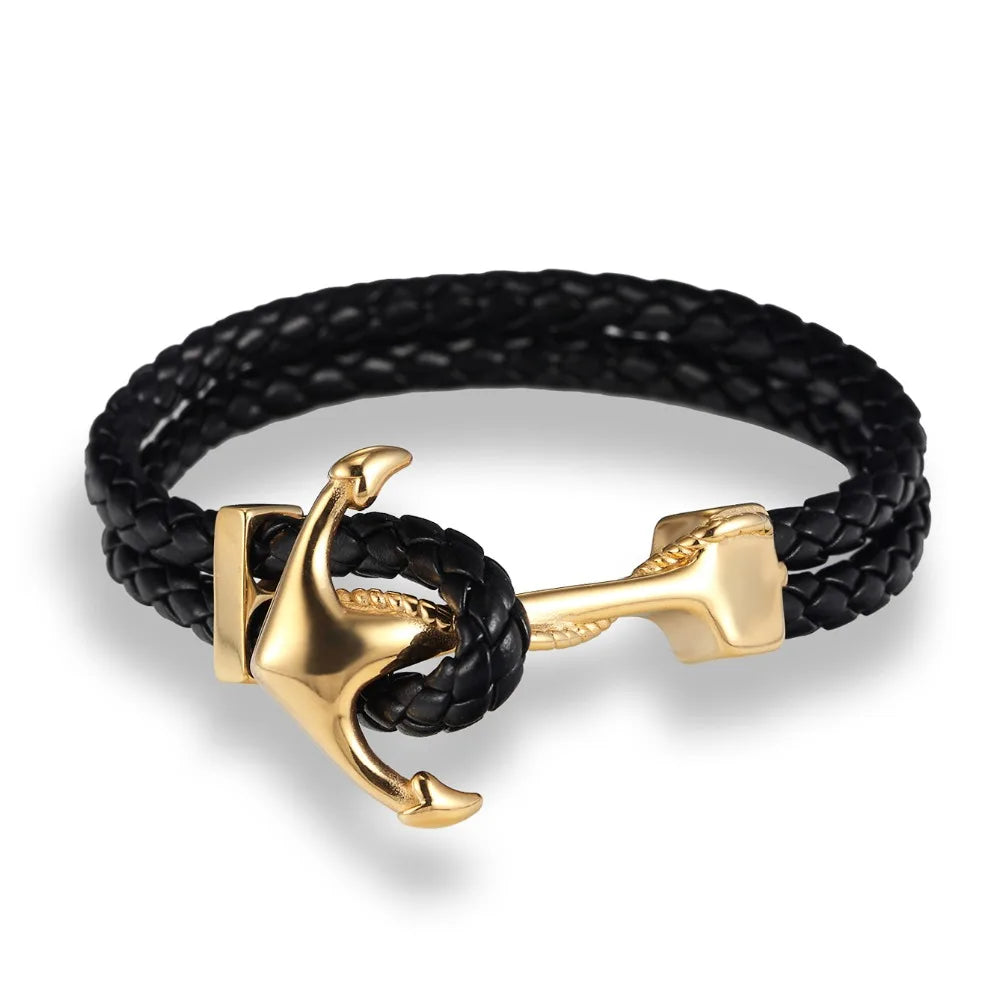
What does sail gp stand for?

Do more sails make you go faster in raft?

How much did it cost to sail on the titanic?
Sign up to be the first to learn about our news and get a 20% discount coupon code!
- Opens in a new window.

Cruise Ships, What Shape Are They Below the Water?
Have you ever seen a cruise ship you may be wondering what is below the waterline and how they actually manage to float?
A lot of a ship’s ability to float comes from the way that the ship is designed below the waterline.
Do Cruise Ships Have Flat Bottoms?
The bottom of a cruise ship is not perfectly flat, although it does look flat from a distance.
Under the water, the front of the ship is usually v-shaped or u-shaped, with the back of the ship having a square-like shape.
In this article, we will look at how the bottom of cruise ships are shaped – and why they are shaped like this .
We will also explore why the bottom of cruise ships are different to the bottom of Ocean Liners.

What Shapes Are the Bottoms of Cruise Ships?
If you look at a cruise ship from land, you may think that the bottom of the ship looks flat. Cruise ships often tower high into the sky and do resemble buildings in many cases.
If you were to take the ship out of the water. you’d see that the bottom isn’t perfectly flat.
I’ve been under a cruise ship. I visited the MSC Bellissima when she was being built and we were able to go under the cruise ship before the “Float-out Ceremony” – when the ship sails for the first time.
We were able to explore not only under the ship. but inside the ship too.
It was very surreal being in a ship that was mostly just steel. I’ve always understood the scale of cruise ships having cruised many times in the past, but being UNDER the ship was something different entirely!
Watch the video below to join me as we explore the ship:
How Does the Hull Shape Make a Difference to a Ship?
The hull is the main body of the ship. Hulls come in a variety of different shapes and can be built with different materials, depending on the purpose of the ship.
There are a few different types of hulls, including:
Displacement Hulls
Ships with displacement hulls are designed to move through the water by pushing the water to the sides.
If you were to think about a ship’s hull, this is probably what you think of by default.
When you put a ship into water, it has to displace water in order to be able to float. The amount of water it needs to displace for the ship to be able to float is carefully calculated when designing the ship.
The weight of the water that is displaced weighs the same as the ship according to Archimedes Principle.
If a ship’s hull displaced too much water, it would sink. Too little and the ship would sit too high on the water.
Planing Hulls
Ships with planing hulls are designed to glide across the top of the water.
An example of this would be a speedboat, where the front of the ship comes above the waterline.
Ships with Planing Hulls usually are designed to go faster than ships with Displacement Hulls.
Semi-Displacement Hulls
A ship with a semi-displacement hull, acts like a displacement hull when travelling at slow speeds, pushing water to the sides of the ship.
When the ship gains speed, it is able to act like a Planing hull.
What type of Hull Does a Cruise Ship Have?
Cruise ships have displacement hulls.
Engineers use lightweight but sturdy materials to help achieve the buoyancy needed to keep the ship afloat.
You can see in the photo below that the sides of the ship are built to displace the water as the ship is sailing.
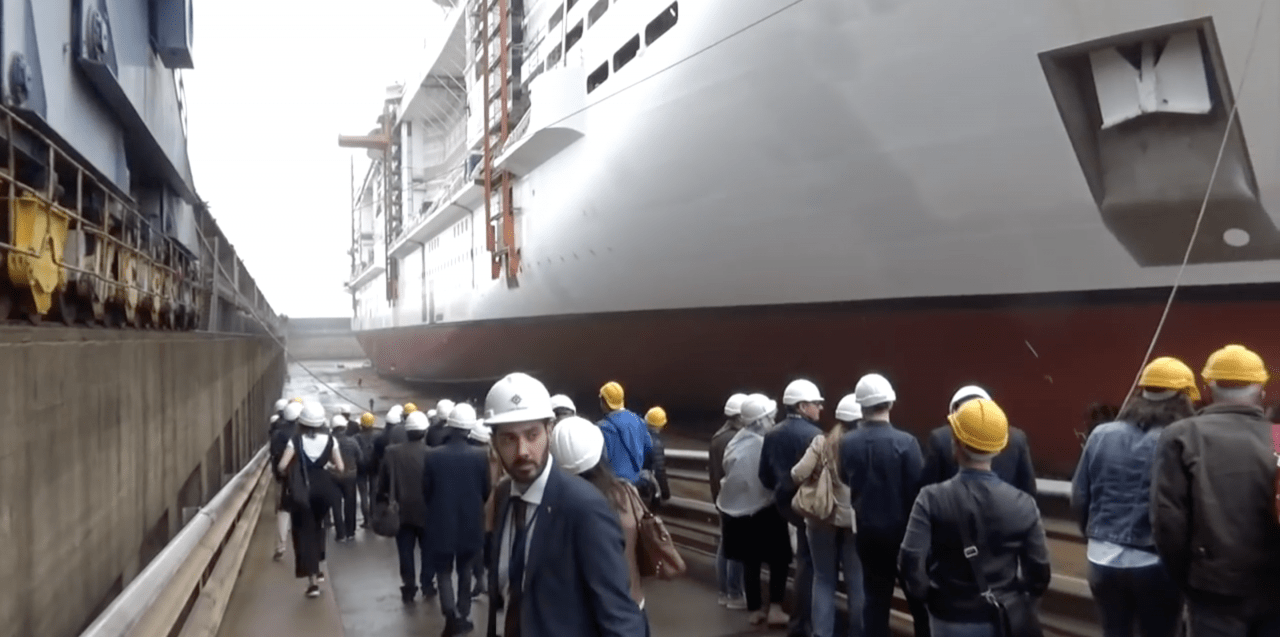
Why Are Cruise Ship Hulls The Shape That They Are?
Elimination of drag.
The rounded edges of the hull help to dissipate the drag or force of the water acting against the ship.
The shape allows the ship to easily travel through the water without too much resistance.
Fluidity and Stability
Ships with Displacement Hulls provide a steadier sailing, than ships with Planing Hulls.
Cruise ships are designed with the onboard experience in mind and being able to keep the ship as stable and steady as possible is very important.
Cruise ships also have stabilisers to help keep the ship as stable as possible for the guests. On the majority of cruise ship sailings, you will not experience any movement of the ship.
To learn more about how much of the movement on a cruise can be felt, check out this post below:
You May Feel Movement on a Cruise Ship – Here’s When and Why
Most cruise ships are built with a double hull (a hull within a hull) to help prevent damage.
Cruise ships are designed to last for decades and to be able to sail day after day without stopping to take any breaks.
The round bottom shape also helps with further protection from reefs, icebergs, and other damage to the ship.

Are There Any Downside to Displacement Hulls?
The drawback of a Displacement Hull is that the ships can’t go as fast as they might with a different hull shape.
That said, cruise ships still sail at around 20 knots, which is almost 25 miles per hour.
The Ocean Liner Queen Mary 2 has a maximum speed of just over 30 knots and a cruising speed of 26 knots. This is faster than a cruise ship.
The speed that a ship can go at is determined by a speed-length-ratio meaning that the length of the ship determines how fast it can realistically travel. The calculation is worked out as below:
Maximum speed (knots) = 1.34 x the square root of the waterline length (in feet) – source.
How Do Cruise Ships Compare to Ocean Liners?
Most people aren’t aware of the difference between cruise ships and Ocean Liners.
They may appear similar but there are significant differences in purpose and design. The design differences affect the hull in multiple ways.
Find out more about the differences in the article below:
Cruise Ships vs Ocean Liners – Measurable Differences You Need to Know
Do Cruise Ships and Ocean Liners Have Different Bottoms?
When Ocean Liners were created, their primary purpose was transportation – to get from point A to point B. Arguably, the most well-known Ocean Liner in history is the Titanic.
There are many important differences in cruise ships and Ocean Liner design.
This affects how the bottom of the ships are built. The chart below gives a basic overlook of the most important differences.
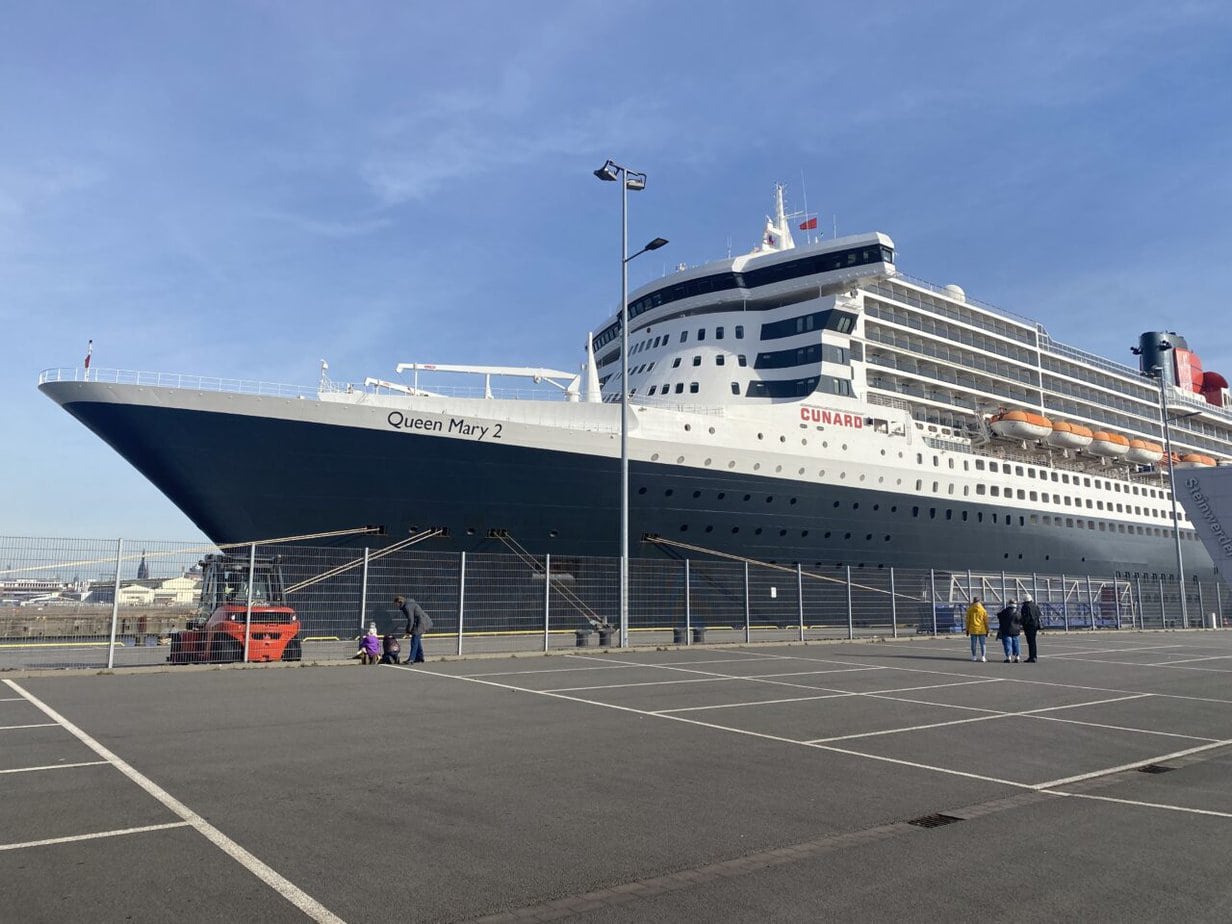
Ocean liners tend to sit quite low in the water and have a pointed bow. They are designed this way to be able to deal with bad weather and to minimize the feeling of movement onboard.
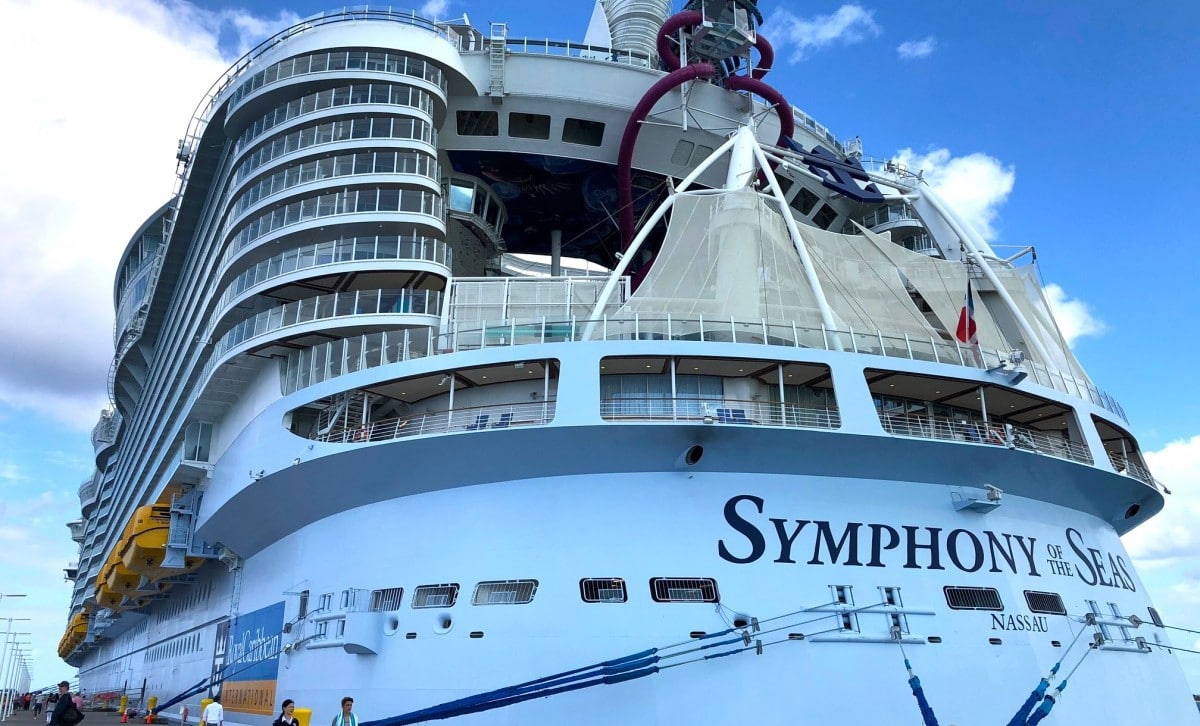
Cruise ships often sit high on the water and can often be strange shapes that aren’t hydrodynamic at all.
Cruise ships aren’t designed to deal with particularly bad weather, although modern ships do have powerful stabilizers.
Most cruise ships will try to avoid stormy weather and may slow down or change their route to do so, Ocean Liners are less likely to have to do this.
Ocean Liners generally have a stronger hull than Cruise Ships. Queen Mary 2 features steel hull plating – ” Thick for rigidity during Atlantic crossings .”
There is only one modernly designed ocean liner currently still in service, and that is the Queen Mary 2 (QM2), which is owned by Cunard.
It was completed in 2003. Cruise ships are still being built in large numbers.
I was lucky enough to sail on the last Ocean Liner, The Queen Mary 2. It was a very different experience to the normal cruises I take.
Find out all about that sailing here:
Before You Go
Find out more about Ocean Liners – including what happens to some when they are taken out of service – below:
Ocean Liners, They Still Exist: Here’s Everything You Need to Know
I stayed in the cheapest cabin when I sailed on the Queen Mary 2. Find out whether I enjoyed the experience here:
I Cruised in The Cheapest Cabin on the World’s LAST Ocean Liner – Queen Mary 2

Free Insiders Cruise Line Guide
Ever wondered how the mainstream cruise lines compare? Cruise lines won’t tell you this, but I will.
This FREE guide shows you everything you need to know to find your perfect cruise line.
Enter your email address below:
Seabourn Pursuit cruise ship review: An expedition vessel built for luxury lovers

Editor's Note
Are you looking for a cruise ship that can take you to the most remote places in the world in style? Seabourn Pursuit will surely be on your short list of candidates.
Unveiled in August by Seabourn , one of the world's best-known luxury lines, Seabourn Pursuit is a small and agile expedition ship designed to visit such hard-to-reach and rugged destinations as Antarctica and Australia's Kimberley coast. But it's also a luxury ship that delivers some of the highest levels of service and pampering at sea.
For more cruise reviews, guides, news and tips, sign up for TPG's cruise newsletter .
As I saw during a recent 10-night voyage in the Kimberley region, Seabourn Pursuit combines some of the best attributes of both expedition ships and traditional luxury ships to offer an unusually upscale adventure experience.
The biggest caveat to picking this ship: It doesn't come cheap. Suites on the vessel — and every cabin is a suite — often start at around $2,000 per day.
Overview of Seabourn Pursuit
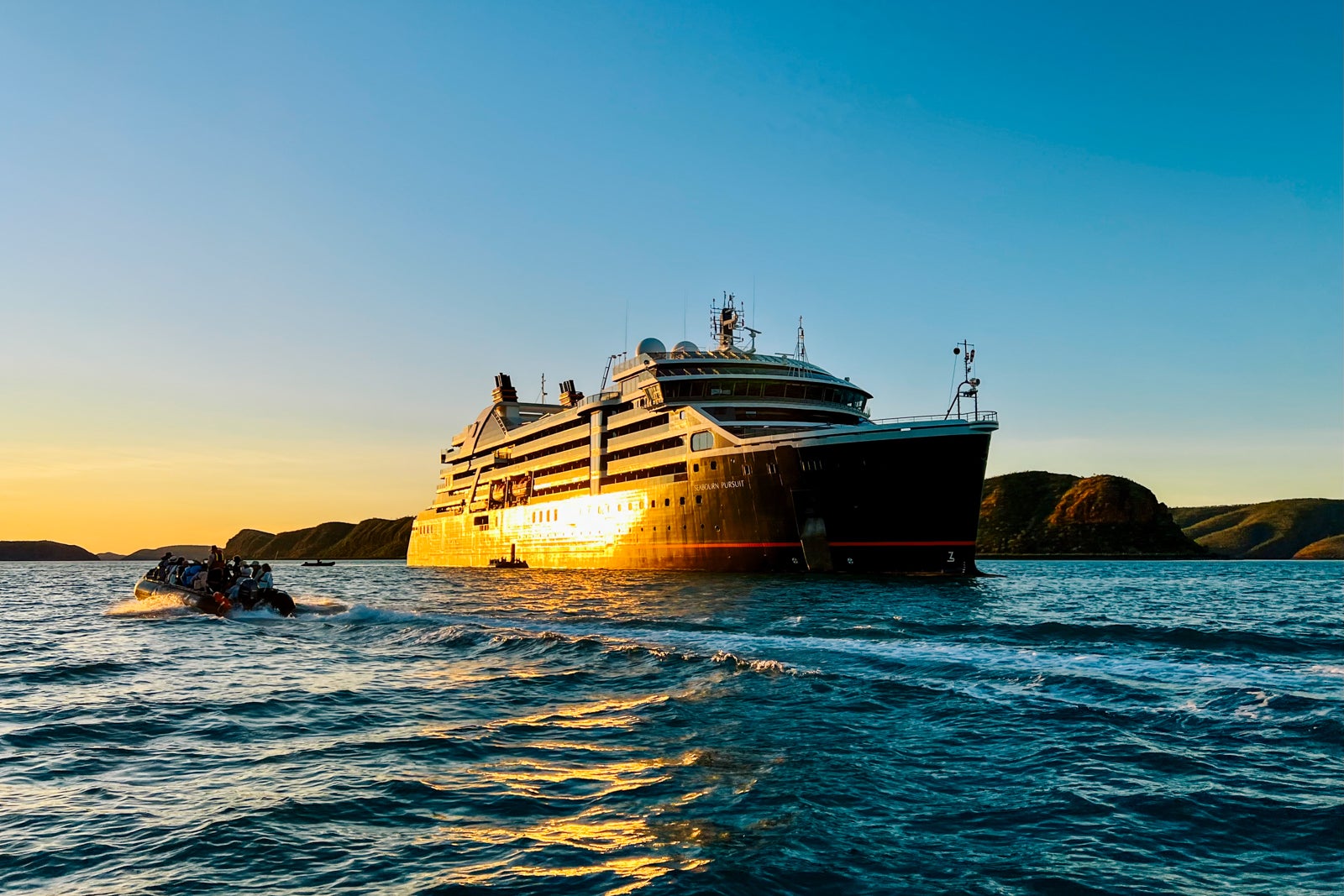
Seabourn Pursuit is one of the world's newest and most elegant expedition ships.
Like all expedition ships, it's specifically designed and equipped to get travelers to remote and hard-to-reach places like Antarctica that most people never get to see.
For starters, it's built to be inordinately tough. Its strengthened hull allows it to bump through ice in polar regions, and its unusually large fuel tanks and food storage areas allow it to operate for long periods in remote areas without reprovisioning.
Additionally, it travels with its own landing craft — small rubber Zodiac boats — to get passengers ashore in remote areas. It also carries other adventure gear for exploring remote areas, including kayaks, snorkeling equipment and scuba gear, and it has two submarines for exploring deep underwater.
Related: Expedition cruises: The ultimate guide to cruising to remote, hard-to-reach places
As is typical for expedition ships, Seabourn Pursuit travels with a large expedition team of experts on the places it goes. The members of the team lead landings and lecture on board.
While small compared to most cruise ships, including Seabourn's five traditional luxury ships , Seabourn Pursuit is relatively large for an expedition ship at 23,615 gross tons — something that has both advantages and disadvantages when it comes to operating expedition-style trips.
Twice the size of the latest expedition vessels built for such expedition cruise leaders as Lindblad Expeditions and Quark Expeditions, it offers a wider array of eateries, lounges and other onboard venues than is typical for such a vessel. But its bigger size also comes with a capacity for more passengers, which can be a drawback when operating expedition-style landings in remote areas.
Seabourn Pursuit is the second of two nearly identical expedition ships that Seabourn has launched over the past two years as it moves into the expedition cruising space for the first time. The first vessel in the series, Seabourn Venture , also sails to remote parts of the world, including Antarctica and the Arctic.
What I loved about Seabourn Pursuit
Its elegant and upscale onboard experience.
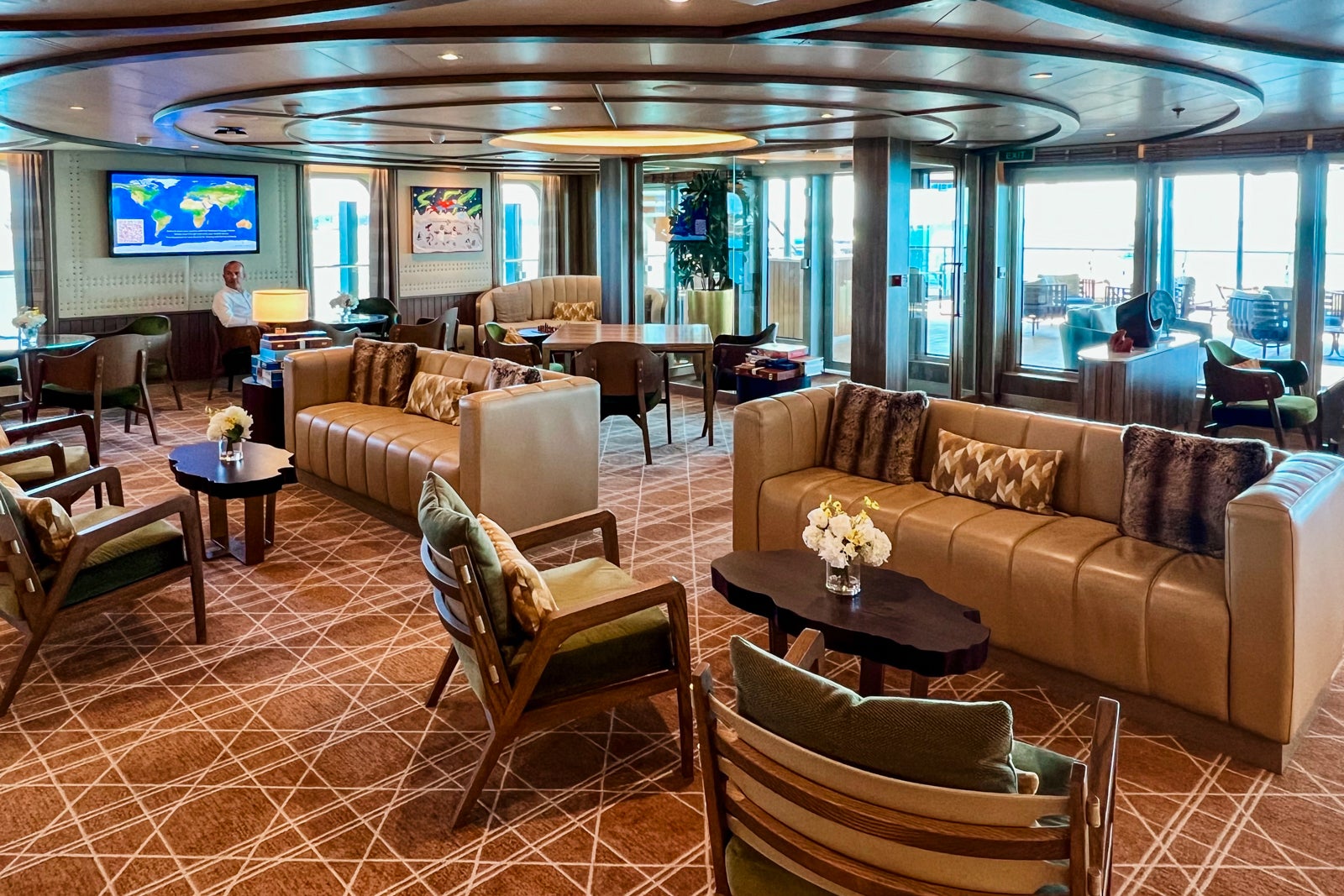
Seabourn Pursuit offers an elegant and upscale onboard experience that is unlike almost anything else found in the expedition cruise space. Its onboard venues, including its restaurants, lounges and spa, are beautifully designed, as is typical for Seabourn ships. It also sails with an extraordinarily high ratio of crew to passengers, allowing for high service levels (on my sailing, the ratio was exactly one-to-one, with 238 crew and 238 passengers).
Essentially, what Seabourn has done with Seabourn Pursuit is create an expedition ship that mimics the luxury feel of its traditional ocean ships. Or, to put it another way, Seabourn Pursuit is a luxury ship with all the adventure-focused trappings of expedition cruising overlaid on top.
This is relatively unusual in the expedition cruise space. Some of the best-known luxury cruise operators, including Regent Seven Seas Cruises and Crystal, don't operate expedition ships. Those that do, such as Silversea Cruises , don't always operate expedition vessels that are as elegant and upscale in feel, in part because they sometimes are older vessels.
Its always available caviar
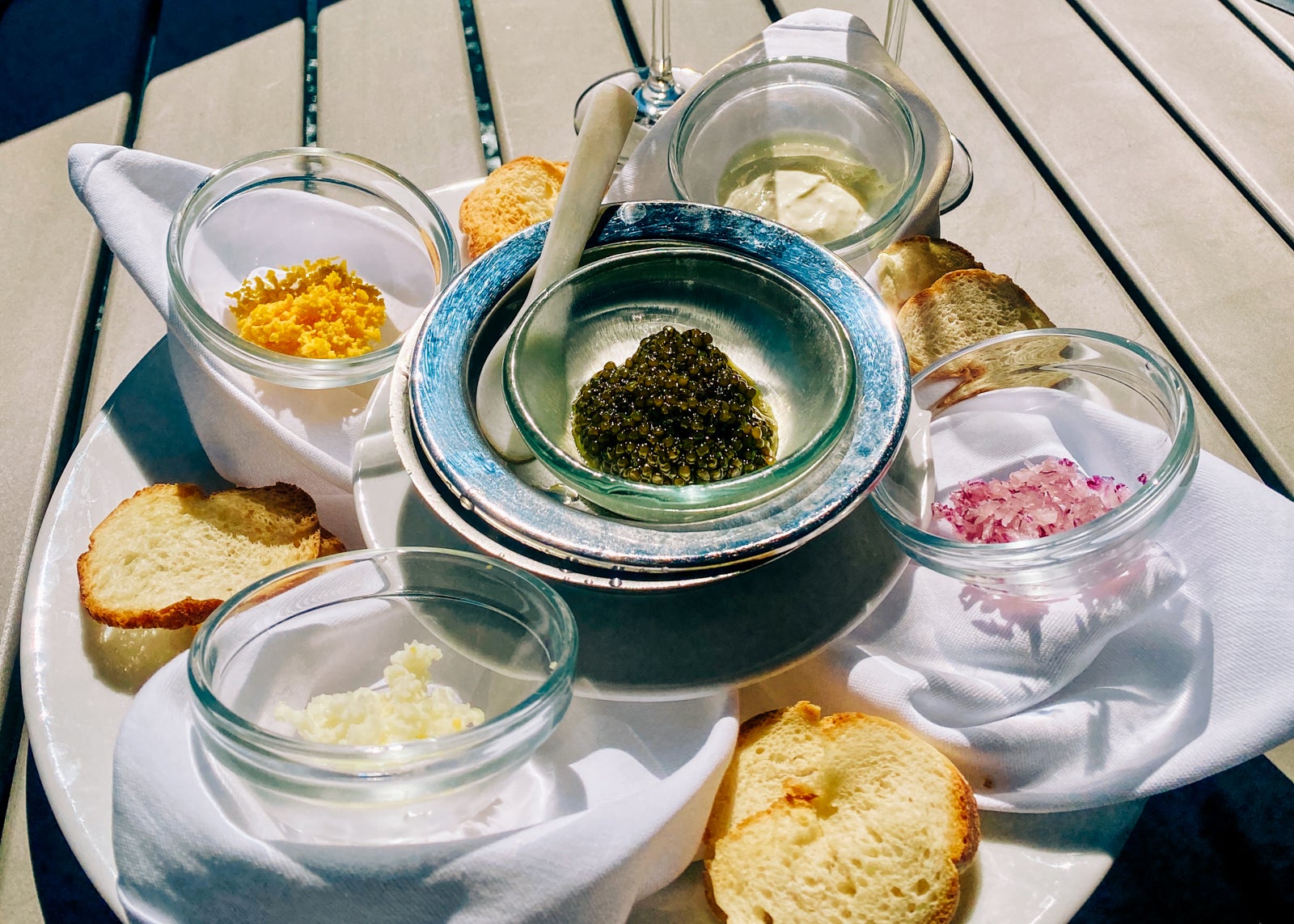
Speaking of elegant and upscale, one of the wonderful little luxury touches on Seabourn Pursuit is that you can order caviar to your room or anywhere else you happen to be on the ship at any time, day or night. There's no extra charge. It's a small thing, but it speaks to the luxury level you'll get when sailing on Seabourn Pursuit. Just note that Seabourn doesn't advertise this much on board, presumably because of the cost. You sort of have to be in the know (and now you are, so ... order away).
What I didn't love about Seabourn Pursuit
The high passenger count.
Seabourn Pursuit can carry up to 264 passengers — a large number in the expedition cruise ship space. The newest ships from two of the best-known expedition cruise operators, Lindblad Expeditions and Ponant, by contrast, carry just 126 passengers and 184 passengers, respectively. New ships from Aurora Expeditions are built to hold 132 people. In expedition cruising, this sort of differential in passenger capacity is a big deal. It can make a considerable difference in the quality of the expedition cruise experience.
The more passengers an expedition ship has on board, the more its expedition guides have to break them up into separate groups for landings, slowing down the process of exploring at any single landing site. The result is that passengers on smaller ships often get to see more wildlife and scenery up close than passengers on bigger ships. This is particularly true in polar destinations such as Antarctica, where passenger landings are restricted to 100 people at a time.
Related: Is this the ultimate Antarctica cruise ship? Our take on Lindblad's National Geographic Resolution
Seabourn built Seabourn Pursuit larger than many existing expedition ships in part to offer passengers the same sort of luxury experience that they get on the line's traditional ocean ships. The ship had to be bigger to make room for all the upscale venues, including multiple restaurants and lounges, that Seabourn passengers expect. But in expedition cruising, sailing on a smaller vessel with fewer people is its own type of luxury.
Seabourn Pursuit cabins and suites
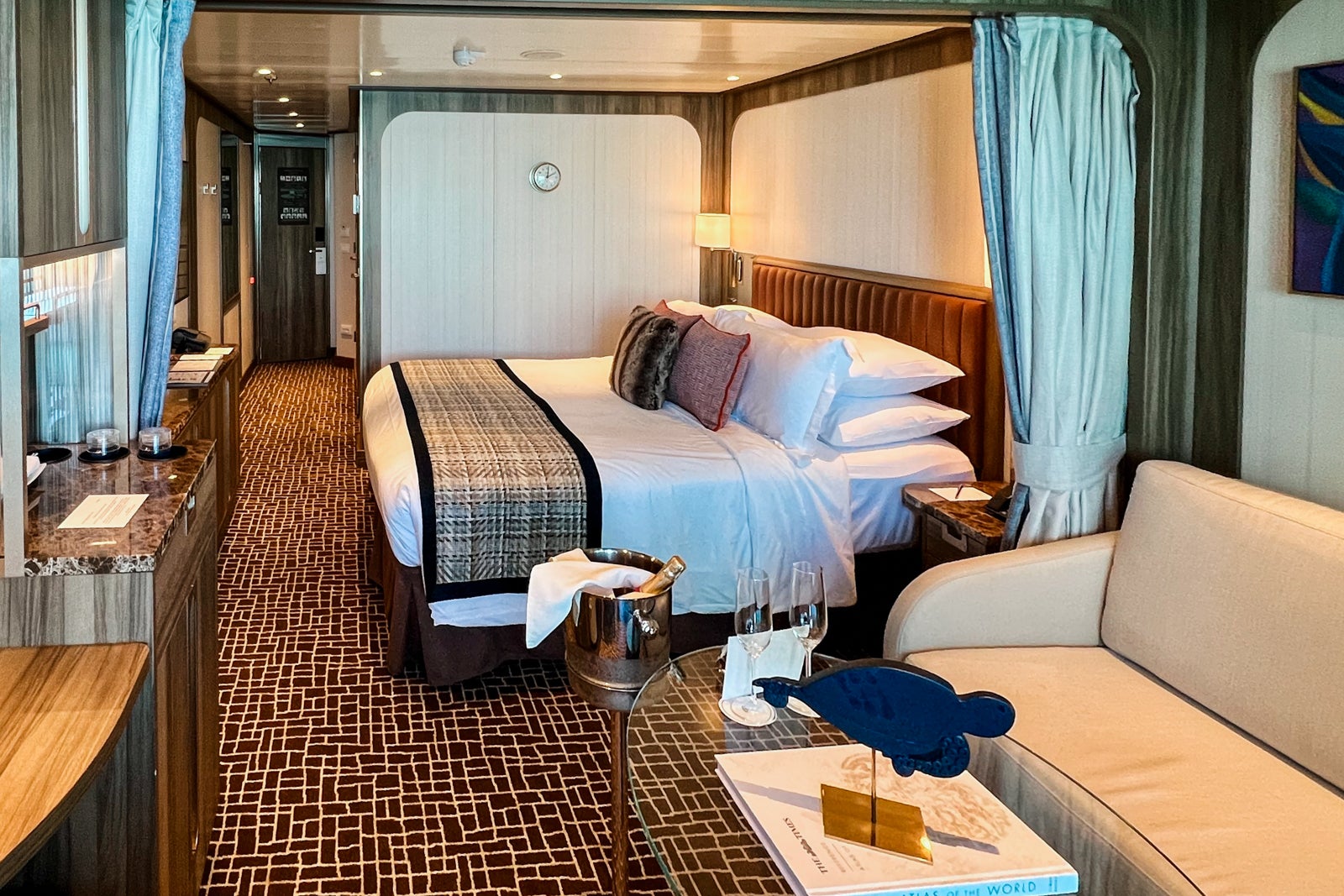
Picking a room on Seabourn Pursuit isn't as complicated as it is on some ships. There is basically just one main cabin category that accounts for the vast majority of the 132 accommodations on board: the Veranda Suite.
On paper, there are five categories of Veranda Suites, but all the rooms in these categories — 101 in all — are basically the same, with the only difference between them being their location. Higher-category Veranda Suites are toward the middle of the ship, which is considered more desirable. Lower-category Veranda Suites are toward the front of the ship.
My cabin was one of the lower-category Veranda Suites toward the front of Deck 6, and just like the higher-category Veranda Suites, it measured 355 square feet — a generous amount for an expedition ship cabin. That space included a 78-square-foot balcony area, the same as you'll find with higher-category Veranda Suites.
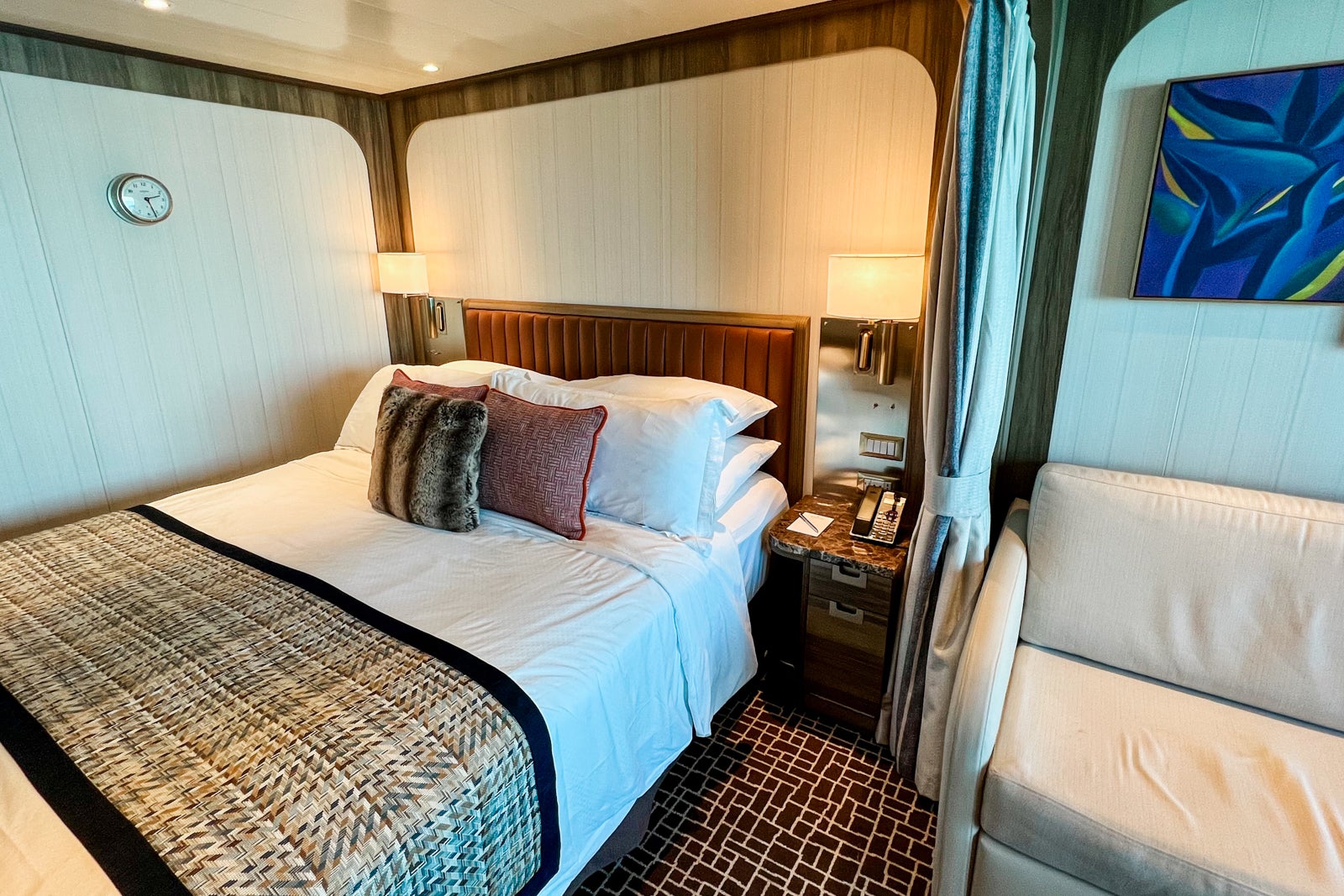
As with all Veranda Suites, my room featured a queen-size bed that could be split into two twin beds, a built-in cabinet and wall-mounted TV opposite the bed and an adjacent seating area with a sofa, a chair and a built-in desk. There was also a walk-in closet and a bathroom.
Decor-wise, it was a lovely cabin with all the high-end finishings and amenities you would expect on a luxury ship. The look was contemporary and residential, with synthetic walnut and bronze cabinetry topped with expensive marble, quality bone white furnishings, patterned mocha and bone carpeting and walls covered in faux parchment.
I particularly liked the custom bedside panels with perfectly placed built-in bedside lights and foldaway reading lamps controlled by vintagelike toggle switches. The bed itself was opulent, with a super-comfortable mattress and high-end sheets. Each side of the bed was topped with three large white pillows that, from top to bottom, were extra firm, firm and soft (as explained on a pillow menu). Two red patterned throws and a sumptuous faux fur pillow rounded out the high-end look.
Among thoughtful touches to the room were its heated compartment for fast-drying wet clothing after Zodiac landings and Swarovski Optik binoculars to borrow during the voyage. A minibar was also stocked with almost any drink I wanted. (Though the one drink I wanted most in my cabin, a morning coffee, was unavailable. Unlike many cabins on high-end ships, the room had no espresso maker.)
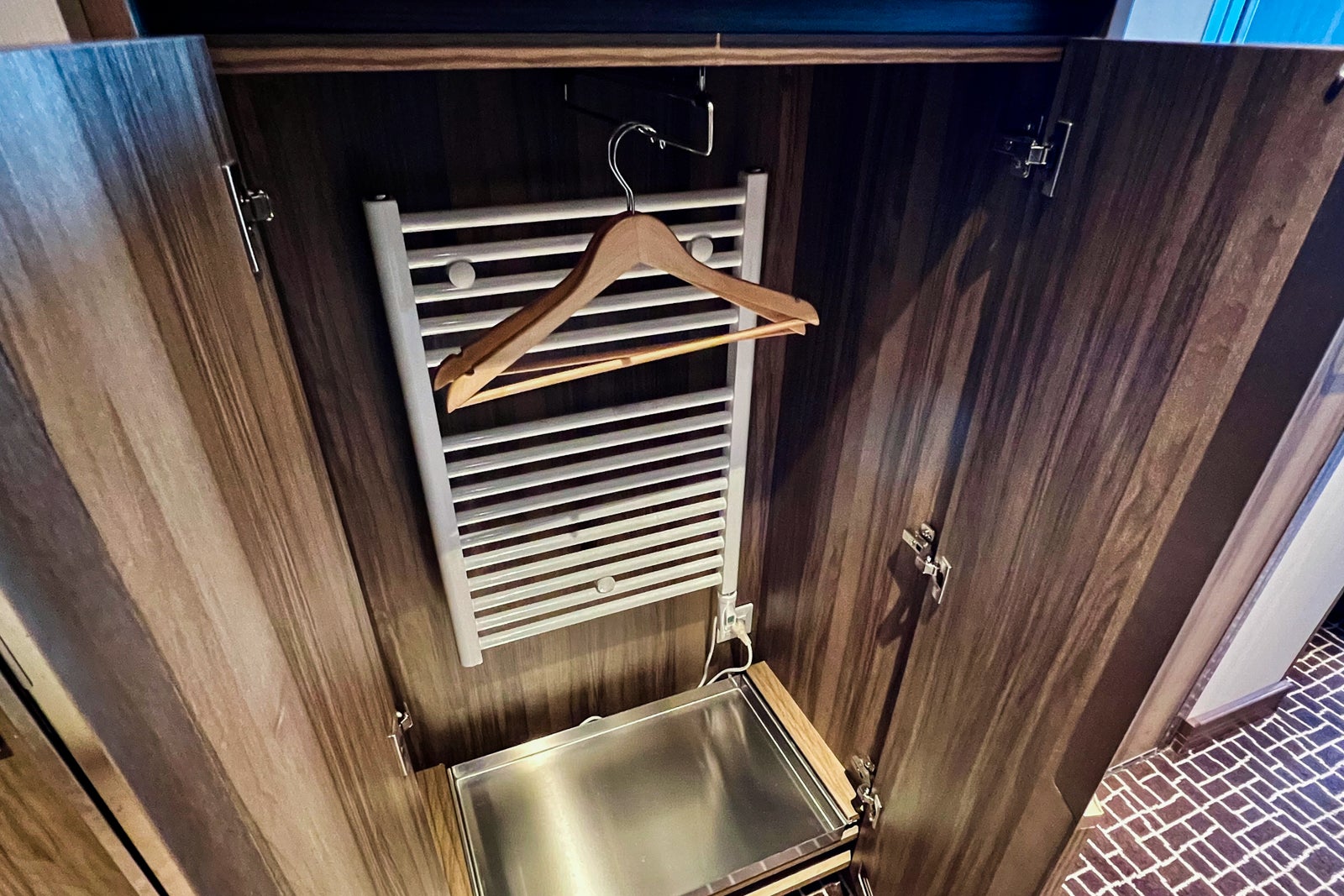
On a practical note, the room was loaded with power outlets of all sorts — enough to keep even the most device-laden traveler fully charged. The bedside panels on both sides of the bed had both U.S.-style 110-volt and European-style 220-volt outlets, as well as two USB ports (alas, there were no fast-charging USB-C ports, something that is increasingly standard on new ships). More outlets and USB ports were located at the desk area and above the cabinet across from the bed.
If there was a flaw to the room's design, it was its storage space, which seemed to take a back seat to the overall look. The built-in cabinet across from the bed was stylish but too narrow to be practical. The desk across from the sofa lacked drawers that would have made it more functional — no doubt to keep its minimalist line.
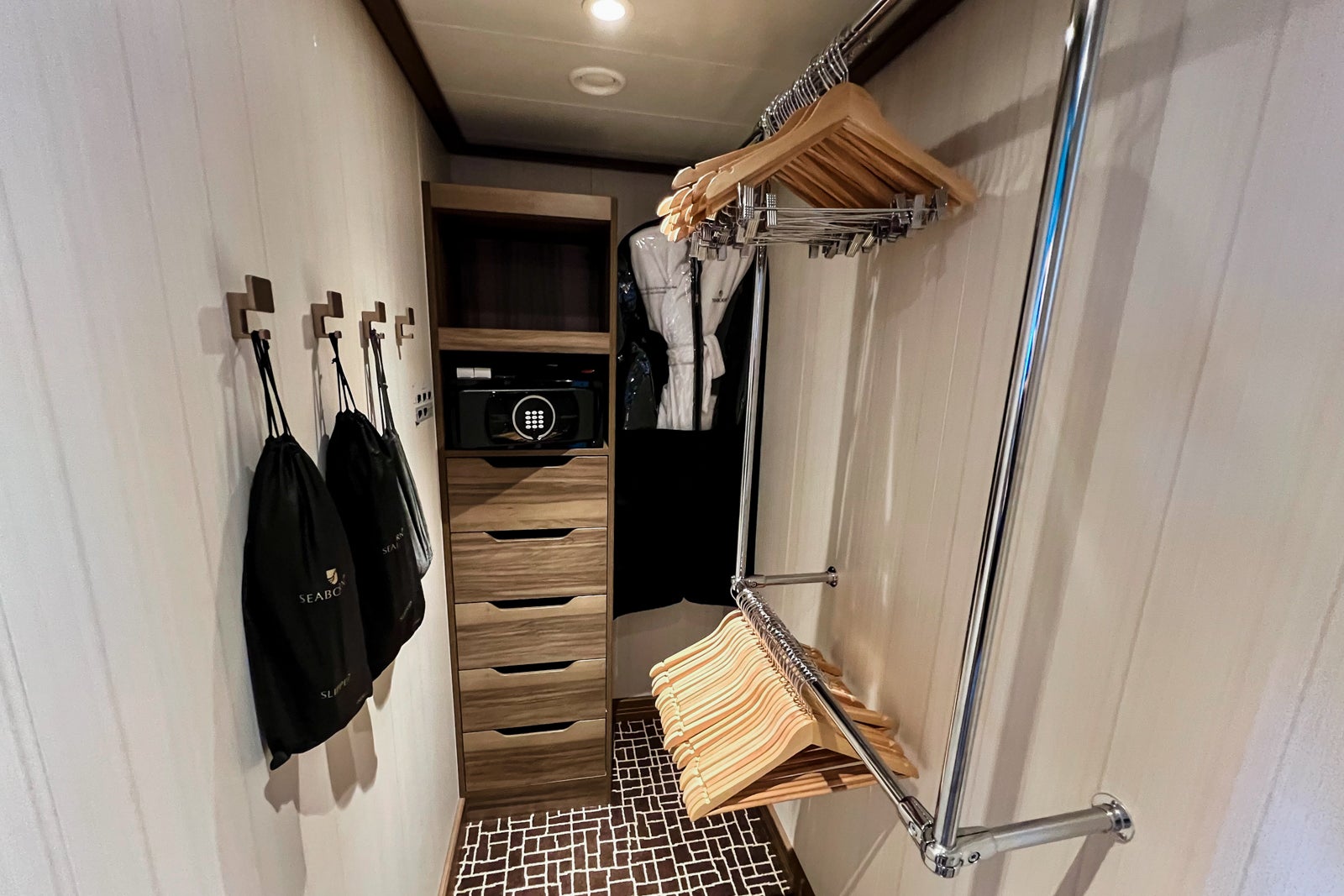
More notably, perhaps, the room's walk-in closet was just a tad too narrow to be fully functional. It offered lots of room for hanging clothes on one side but was light on shelving for sweaters, folded shirts and the like — the result of a significant amount of its space having been left open so that passengers could walk into it. A less elegant but more practical use of this block of space would have been to forgo the idea of a walk-in closet and create large built-in wardrobes that opened from the outside.
The same sort of style-over-practicality in design was evident in the bathroom. It was a beautiful space with marble tile walls and floors, a built-in marble vanity and high-end Grohe fixtures, but it wasn't optimally designed for function. Despite being larger than the typical cruise ship bathroom, it had a comically tiny shower (so tiny it was an exercise in contortion to soap up) and lacked a single drawer for hiding away toiletries. The only storage was three impractically small and narrow shelves to the side of the vanity and several hard-to-reach shelves tucked under the corners of the vanity.
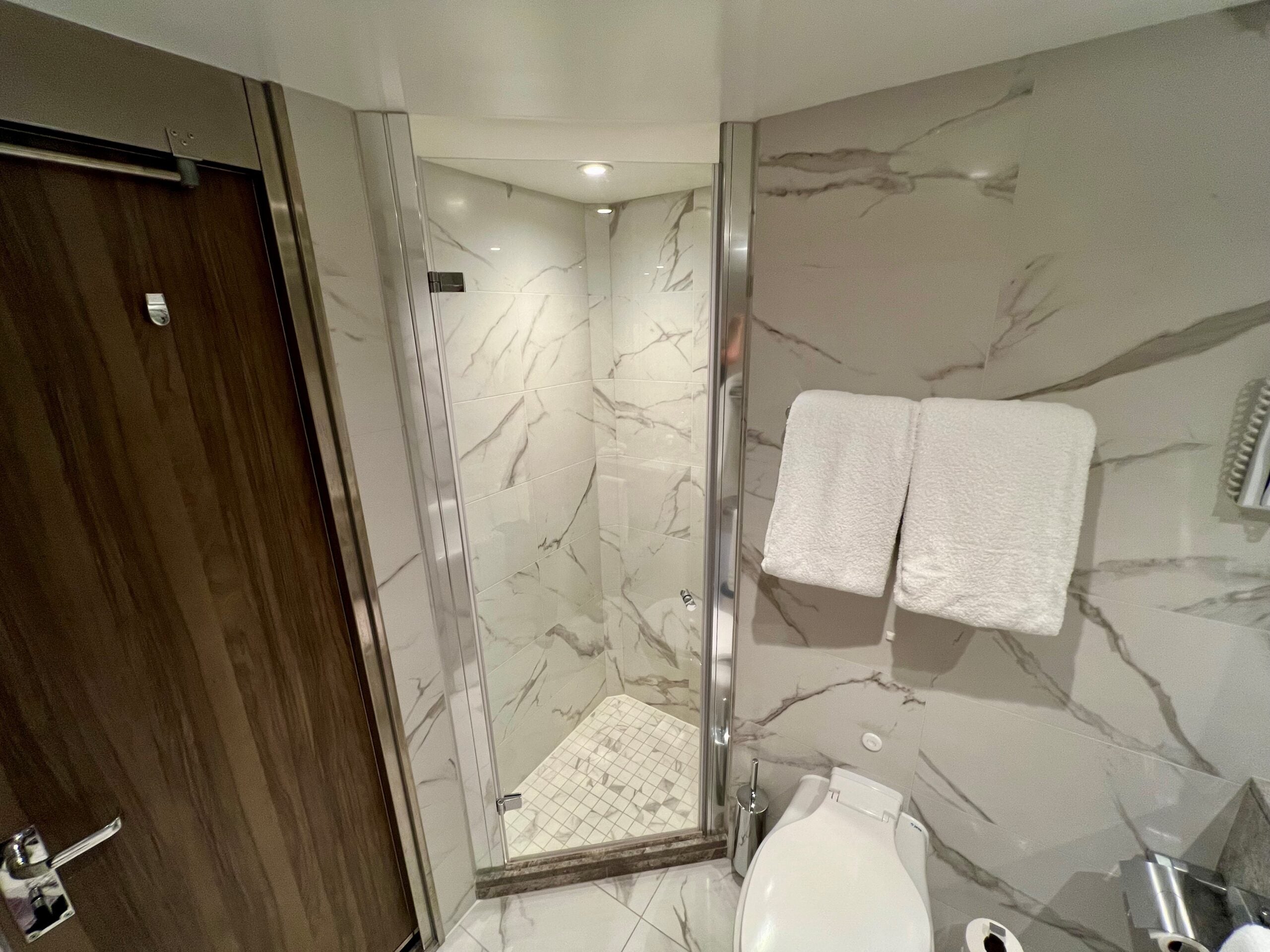
The bathroom also contained a bathtub that few people would use. A bathtub is a nice touch when there is room for one, but in this case, there wasn't. The bathtub ate up the space that could have allowed for a bigger shower — something everyone expects these days.
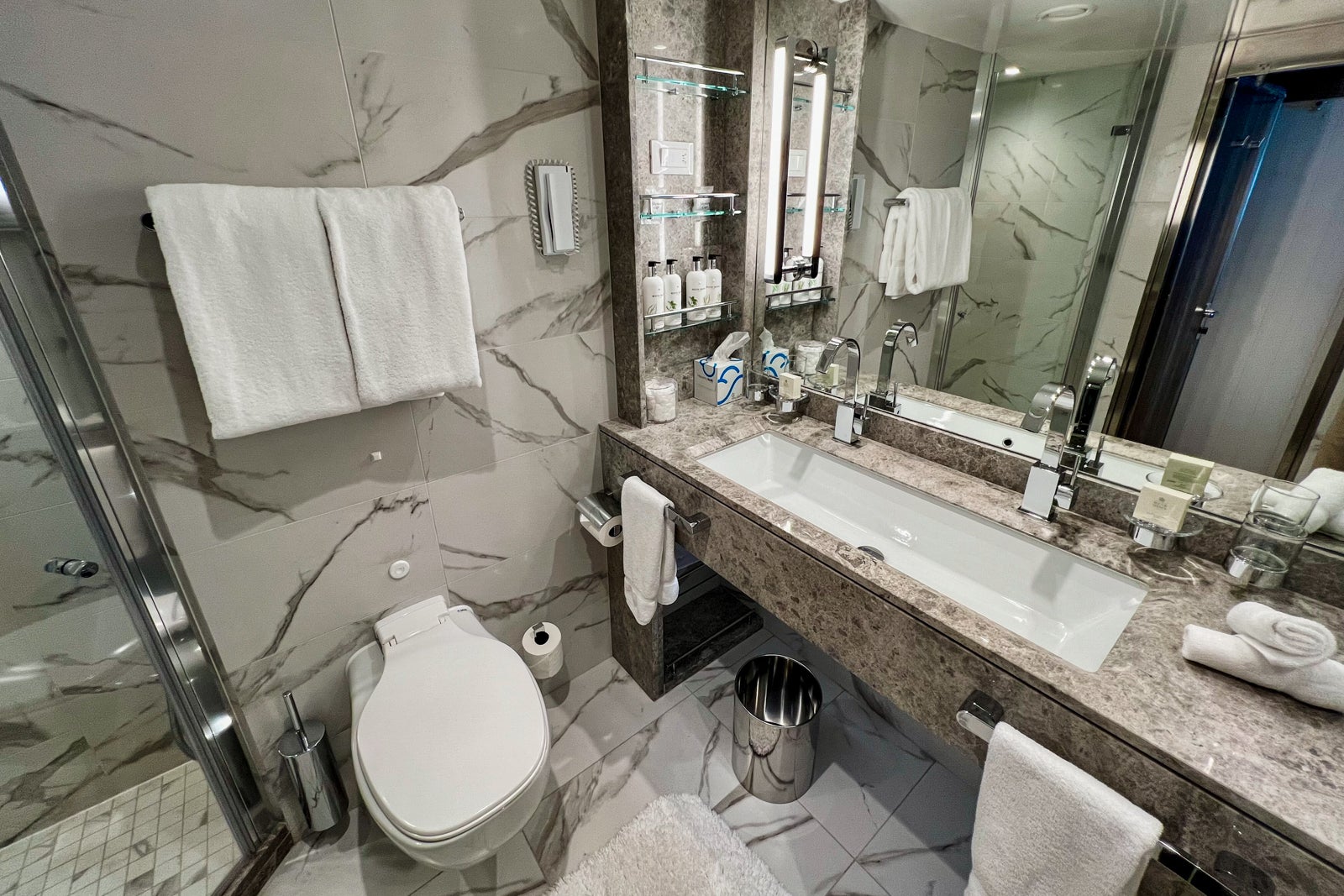
For those who want something more spacious than a standard Veranda Suite such as mine (and are willing to pay significantly more for the privilege), Seabourn Pursuit also has more than two dozen larger suites — a few truly spectacular.
The most over-the-top suites on the ship, by far, are its two Wintergarden Suites. Measuring a whopping 1,175 square feet, they are two-story-high apartments that each have an expansive living area on their lower floors and a stunning bedroom with a bed facing floor-to-ceiling glass walls on their upper floors. Both of the suites can be combined with an adjacent Veranda Suite to create an even larger two-bedroom complex that measures 1,605 square feet.
Also spectacular are the ship's two rear-facing Signature Suites, which fill up the entire back of Deck 8. Each of the suites measures 1,380 square feet, not including its balcony, and has a massive living area overlooking the ship's wake in addition to a bedroom. Each also has a seemingly endless wraparound balcony with its own Jacuzzi and elegant lounge furniture.
Related: Ditch the polar gear: 7 warm-weather expedition cruises that will wow nature and adventure lovers
Two more larger suites on the ship are its Owners Suites, which measure 1,023 square feet, including balcony space. Located at the front of the vessel, they also have large living areas separate from their bedrooms.
Two other categories of suites on Seabourn Pursuit that are larger than the standard Veranda Suites but not nearly as big as the Wintergarden, Signature and Owners suites are its nine Penthouse Suites and 16 Panorama Veranda Suites. These two categories of rooms measure 527 square feet and 417 square feet, respectively, including their balcony space.
Seabourn Pursuit restaurants and bars
As is typical for small ships, Seabourn Pursuit has just a handful of eateries. Still, it manages to offer a wide range of cuisines with rotating theme nights in one of its restaurants. Several bars and lounges offer a diversity of drink choices.
Restaurants
Seabourn Pursuit has two main restaurants: The Restaurant and The Colonnade.
The Restaurant is the more formal of the two, offering a fine dining experience in a stylish space filled with custom-designed, modern Italian furniture and bronze-framed wine displays.
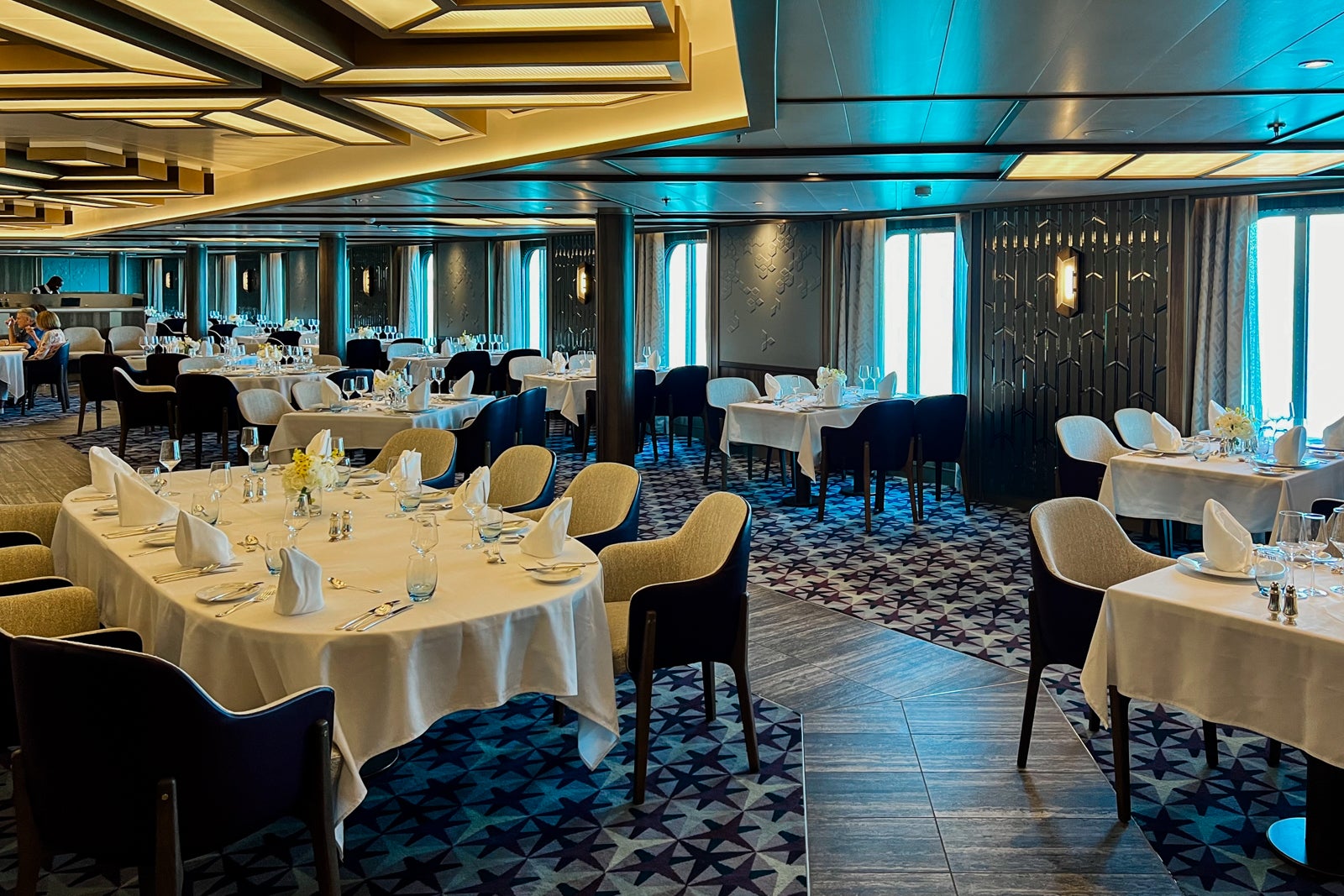
Open for breakfast, lunch and dinner, The Restaurant offers classic cuisine such as eggs Benedict in the morning and grilled snapper and beef tenderloin in the evening.
The Colonnade is a more casual alternative eatery that offers a buffet service for breakfast and lunch (augmented with some a la carte menu items that you can order from your waiter). It then transforms into a waiter-served sit-down restaurant at dinnertime.
The Colonnade's cuisine at dinner changes daily, offering passengers a more diverse dining experience in the evenings than one might expect from a ship with just two restaurants. One night, it'll have a French focus, the next, Spanish. When I was on board, nights devoted to Australian, Thai, Italian and American cuisines were also on the schedule.
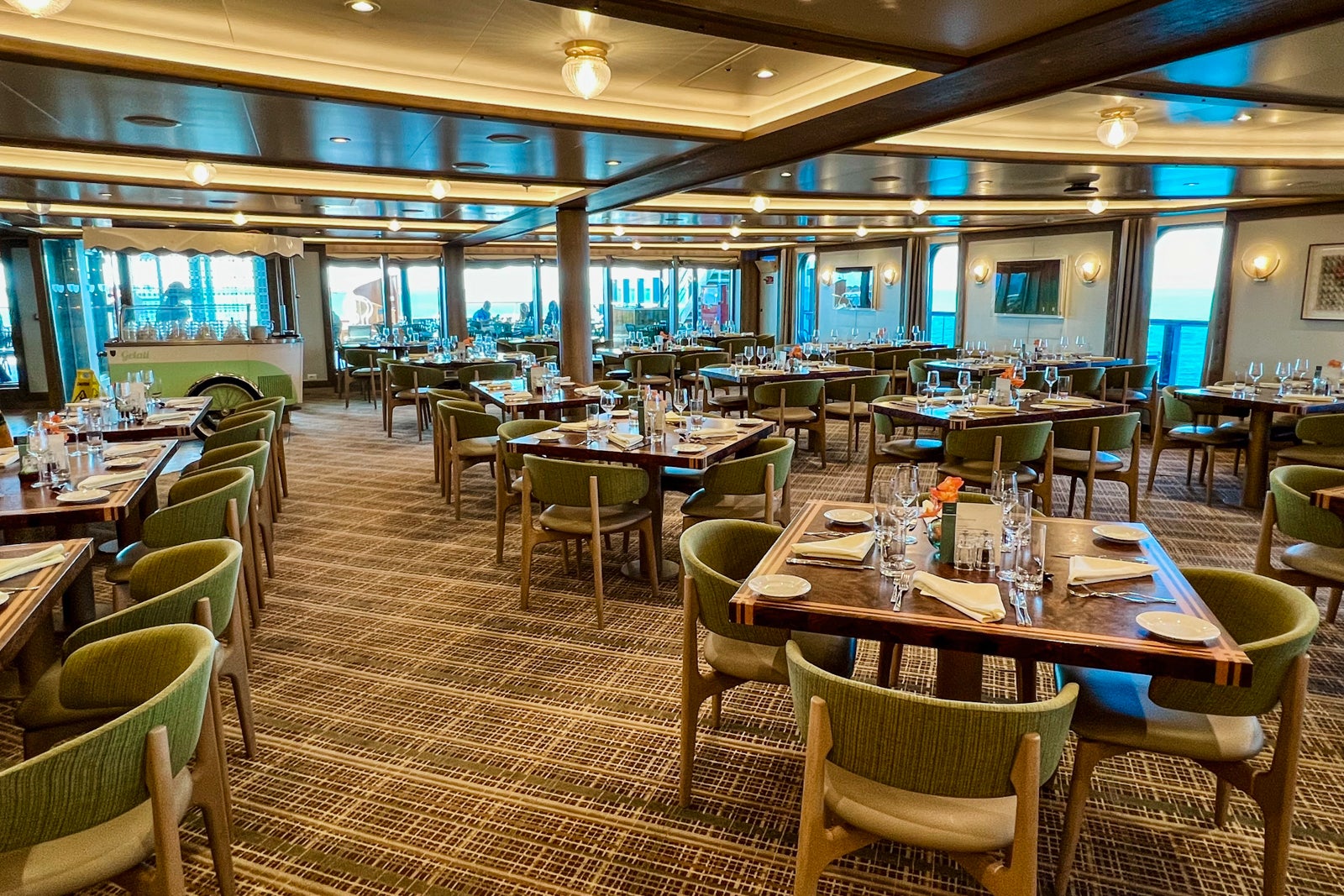
Additionally, on several nights of each cruise, The Colonnade morphs into a pop-up eatery called Earth & Ocean that offers an eclectic mix of dishes inspired by the places the ship visits around the world.
The Colonnade has both indoor and outdoor seating, with the outdoor area known as The Patio. Seabourn touts The Patio in its marketing material as a separate eatery, but it's not really.
In addition to the above, passengers will find sushi made to order every evening in The Club, one of the ship's bars. A nod to the popular sushi eateries found on Seabourn's bigger ships, the sushi dishes at The Club can be something you order as an appetizer before heading to The Restaurant or The Colonnade for dinner, or they can be your full meal. Just note the sushi menu is relatively limited.
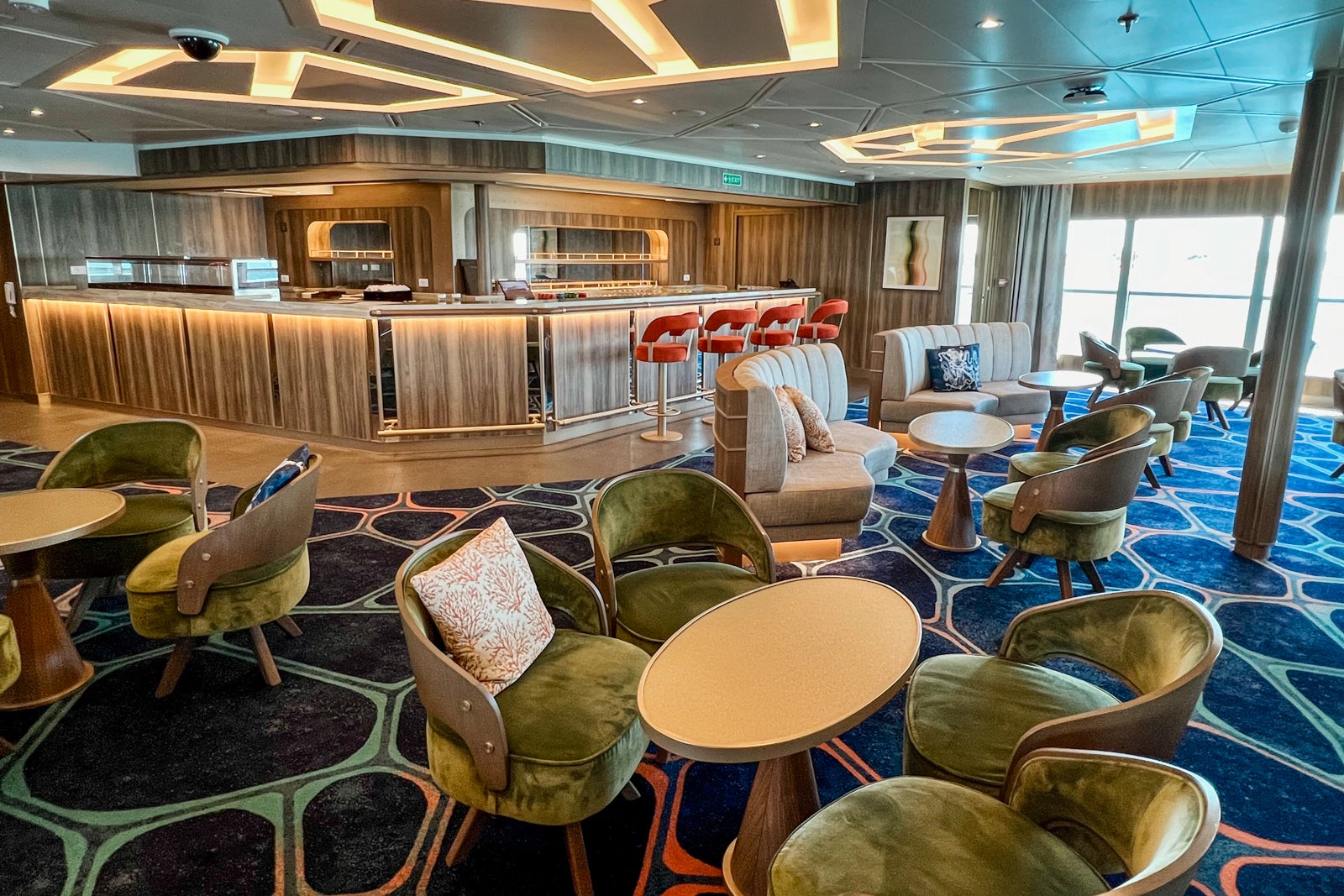
You'll also find quick grab-and-go bites available during the day in The Bow Lounge, a small, unstaffed lounge space overlooking the ship's bow. It has a refrigerator stocked with small portions of salads and wraps in glass containers. The Bow Lounge also has a self-serve espresso machine for cappuccinos, lattes and other espresso drinks.
Additional small bites are available throughout the day at Seabourn Square, a living roomlike lounge space that is home to the ship's main coffee bar, guest services desks, games tables and a library area.
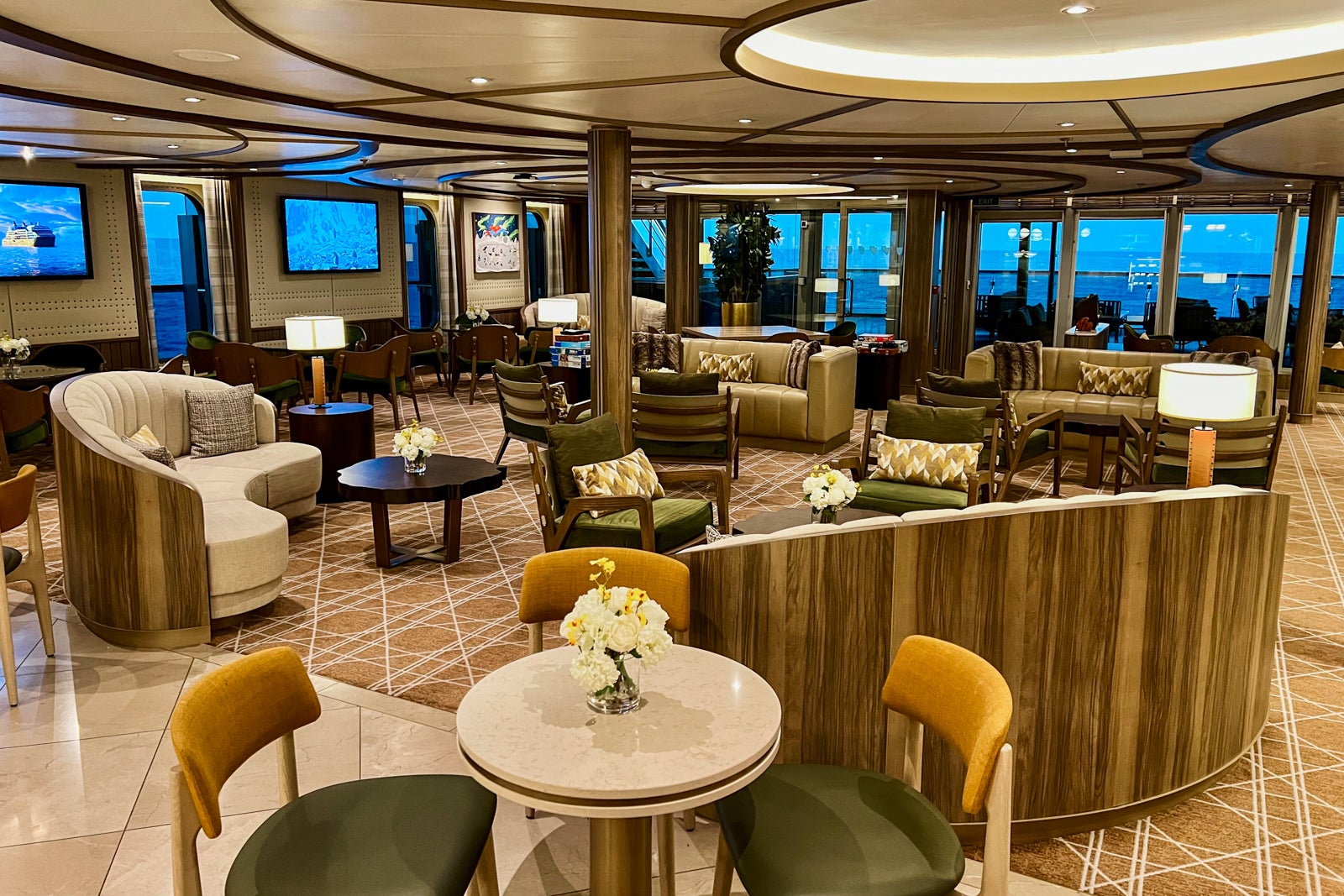
Along with barista-made coffee drinks, Seabourn Square's European-style coffee bar serves pastries in the morning and small sandwiches, homemade cookies and desserts during the day. It's also one of two places on the ship where you'll find lovely homemade gelati — the other being The Colonnade (at lunchtime).
Should the above options not be enough to keep you satiated, you can always order room service. Seabourn Pursuit offers in-suite dining around the clock, with an all-day menu of six starters, a dozen mains and various desserts. The menu is a mix of casual items such as sandwiches and burgers and more elegant dishes such as a Black Angus New York steak. During dinner hours, passengers can also order anything they want off the day's The Restaurant menu.
In general, the cuisine on board Seabourn Pursuit is high-end but nothing that will leave you wowed. Dishes in The Restaurant skew to classic continental fare that is traditional and safe, with relatively simple plating. A typical night might bring such main dishes as a filet of red snapper draped over cooked Swiss chard with piped mashed potatoes on the side or slices of pork tenderloin over polenta with vegetables. The choices don't typically include anything overly innovative. On my sailing, the execution was also hit-or-miss.
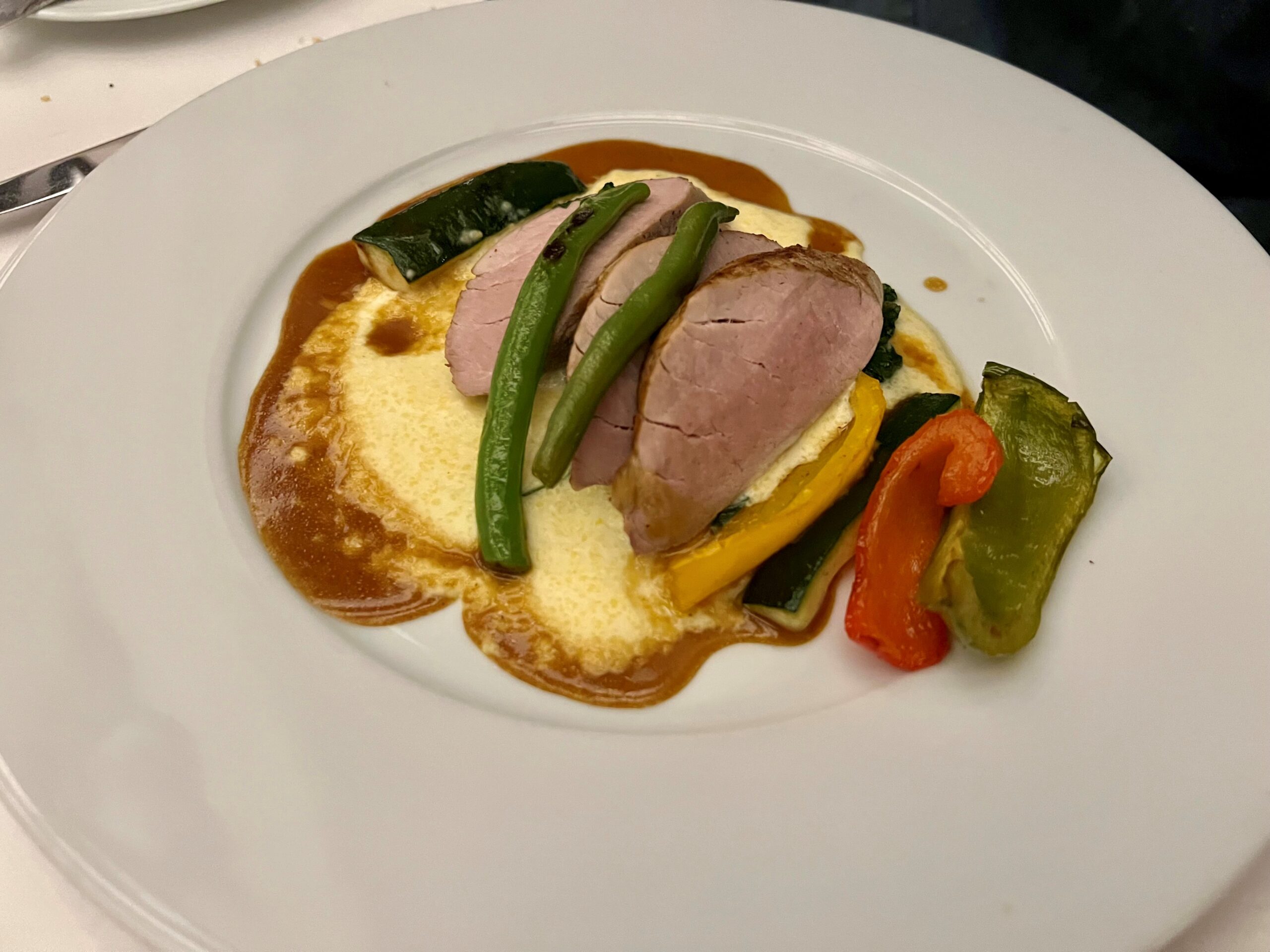
Additionally, for those who like flavorful food, be warned that dishes at both The Restaurant and The Colonnade come out very unseasoned — that is, they are very light on salt, pepper, herbs and spices. This is by design, as Seabourn has many older customers who are on low-sodium diets or have other health or taste concerns for which they have requested blander dishes. Still, it could be a turnoff if you're the type of luxury traveler who travels in part for distinctive culinary experiences.
Foodies also should note that the complimentary wines included with meals are more down-market than you might expect for a luxury ship. On my sailing across Australia's Kimberley region, the ship was serving a 19 Crimes shiraz as its main red on some nights that retails in Australia for under 10 Australian dollars (about $6.70). Tastewise, it was about what you'd expect at that price point.
There are plenty of wonderful wines on Seabourn Pursuit, for sure. But for the most part, they're only available with an upcharge.
One standout element of Seabourn Pursuit's culinary offerings is its breakfast buffet in The Colonnade. I loved such luxury touches as the giant juice machine for making fresh orange juice to order; the wide array of available fruits, including fresh berries (something you generally only find at breakfast buffets on luxury lines); the array of homemade breads; and the congee station.
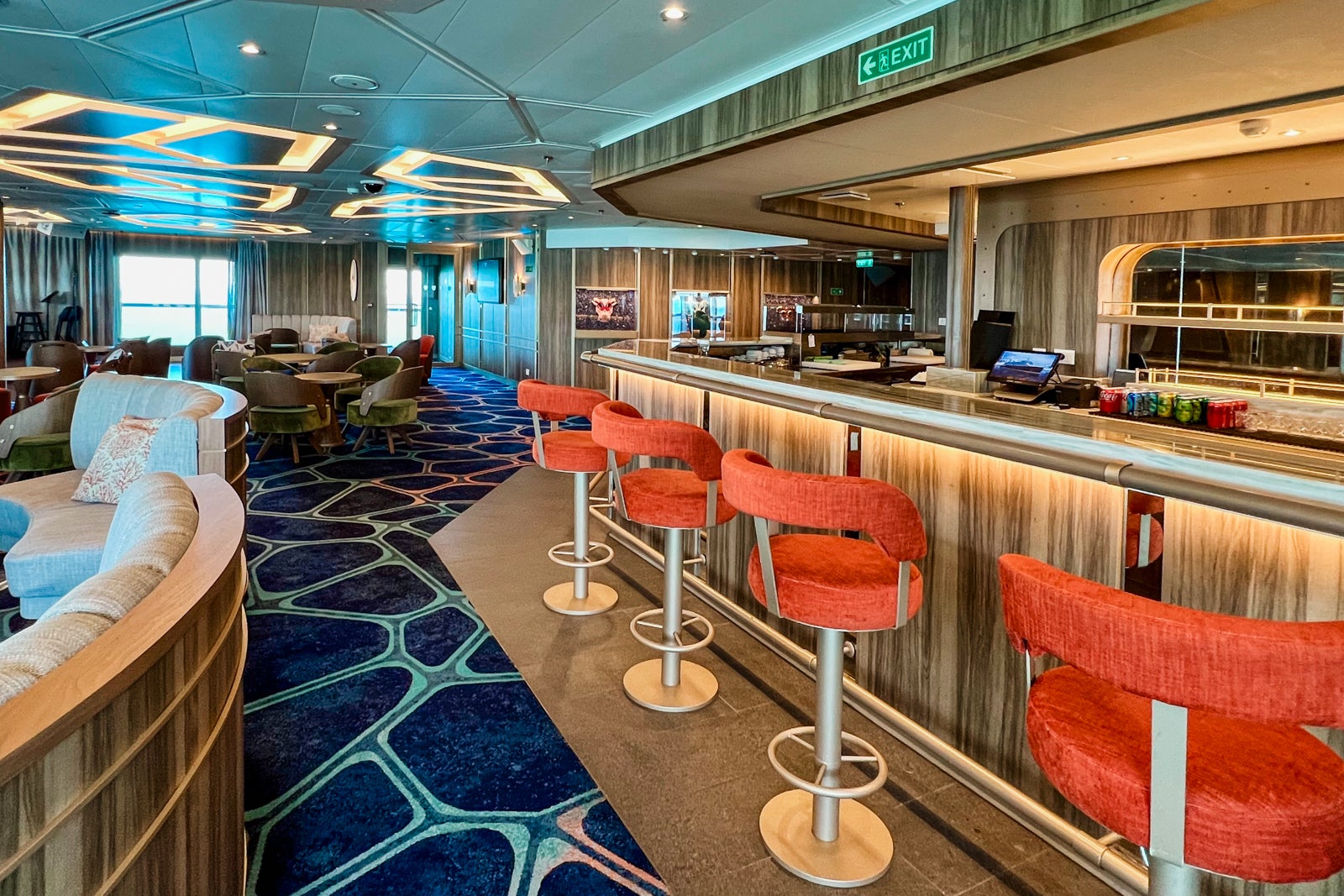
If you're heading out for a drink in the evening on Seabourn Pursuit, you're probably heading to one of three places: the Expedition Lounge, the Constellation Lounge or The Club.
Just outside the ship's theater, where expedition-related briefings take place, the Expedition Lounge is a cozy space that evokes the age of exploration with steam trunk-inspired leather and fabric furnishings. Anchored by two fireplaces with faux flames, with a bar tucked into the wall in between, it lacks a menu of signature drinks, but its bartenders will make you whatever you desire.
Given its location, the Expedition Lounge is popular as a drinking spot just before and after the evening expedition briefing.
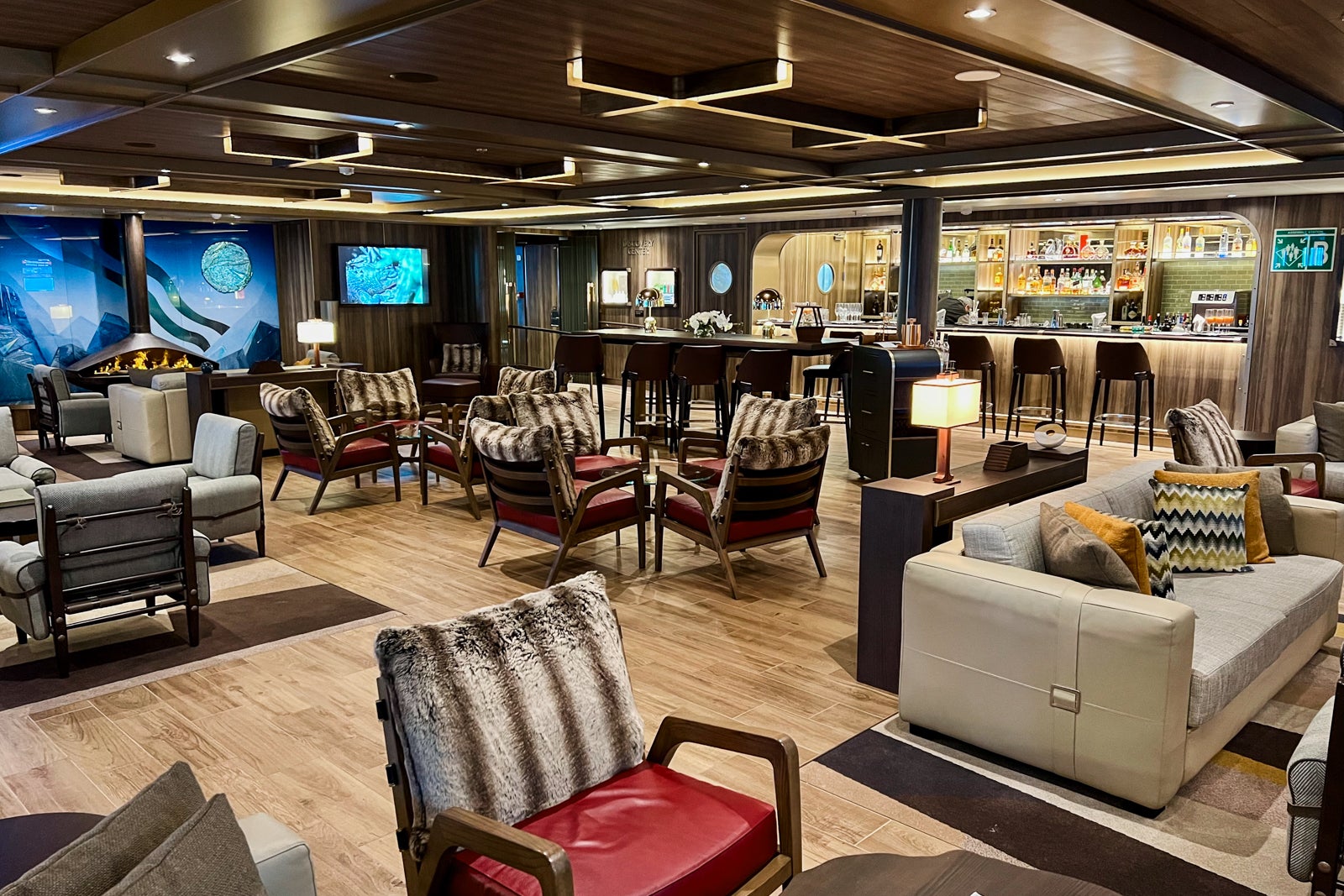
Five decks higher at the top front of the ship, the Constellation Lounge is a classic observation lounge with stunning 270-degree views through floor-to-ceiling glass walls. As its name suggests, it takes its theme from the night sky with carpets and cushions patterned from the constellations. Even the lighting follows the theme, with dozens of ceiling-mounted lightbulbs mimicking the stars above.
Unlike the Expedition Lounge, the Constellation Lounge has live music every night (on my sailing, it was a singing and guitar-playing duo), and it's also home to a signature cocktail menu designed by mixologist Brian Van Flandern — a well-known drinks creator. In the early evening, it offers a self-serve buffet of tapas along its back wall.
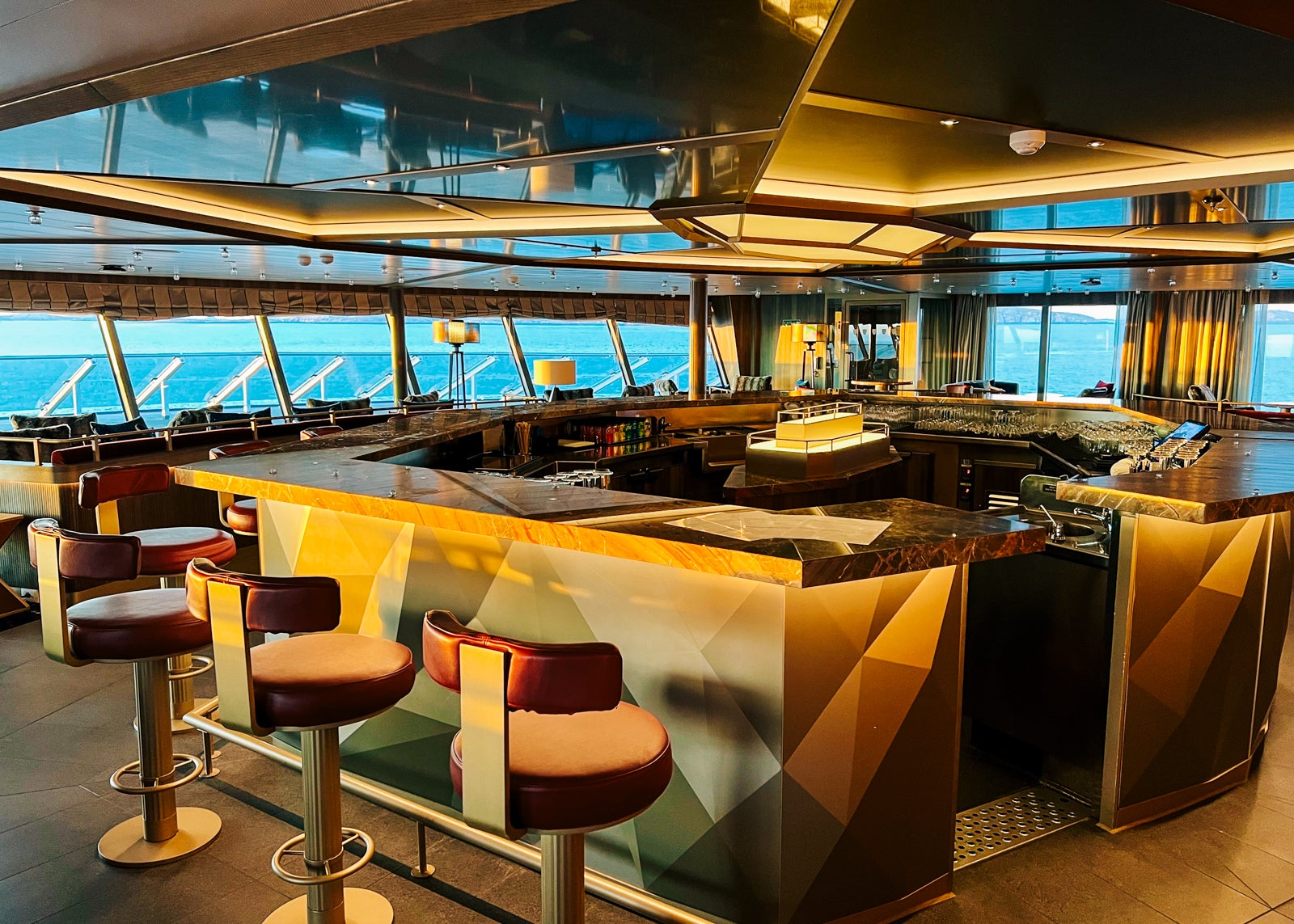
The Club, on the same deck as the Constellation Lounge but at the back of the ship, is another cozy space with a faux fireplace and warm, residential furnishings. As noted above, it features sushi made to order in the evenings. It also has a signature drinks menu with an array of sake-infused Saketinis, as well as handcrafted cocktails with such names as Smokin' Margarita and Honey Dew Wop.
Like the Constellation Lounge, The Club has live music nightly. During my sailing, it was home to a piano player.
Because of its made-to-order sushi bites, which are popular, The Club is always the busiest of the bars at night. There were times in the early evening when I had trouble finding a table.
The Club also has the most interesting cocktail menu on the ship. That said, in general, the cocktails on Seabourn Pursuit aren't as cutting edge as what you'll find at high-end cocktail lounges on land, despite the brand's relationship with mixologist Van Flandern. You're not going to find sophisticated garnishes, handmade bitters, smokers for infusions or unusually shaped ice cubes as you do nowadays at upmarket cocktail bars on land. The bartenders don't appear particularly steeped in cocktail culture.
Related: The most epic cruise ever? What it's like traveling to the North Pole on a luxury icebreaker
I was especially surprised to find Old-Fashioneds and Negronis ordered at the ship's bars arrive loaded with small machine-made ice cubes of the sort you get in your soda at a fast food outlet. These ice cubes melted fast and diluted the drinks to a point where they were undrinkable after a few sips. If you want a mixed drink, be sure to order it "up" (served without ice).
In addition to the above, Seabourn Pursuit offers two small outdoor bars that are open part of the day: the Sky Bar and the Patio Bar.
The Sky Bar is at the top of the ship just outside of The Club and serves a small outdoor sunning area with hot tubs. It's also the one bar area on the ship where you can smoke.
The Patio is the bar for drinks around the infinity pool at the back of the ship.
Seabourn Pursuit activities
As is typical for expedition ships, the activities on Seabourn Pursuit revolve heavily around experiencing and learning about the wildlife and natural wonders of the mostly remote destinations that the vessel visits.
Seabourn Pursuit sails with a 24-member expedition team that includes experts in geology, marine biology, ornithology, local cultures and other topics of relevance. The team leads outings for exploring, typically by Zodiac boat, and lectures on board about what passengers are seeing on such outings.
A typical day in Antarctica, for instance, might include a Zodiac landing to see penguins, a secondary Zodiac outing to cruise coastal waters in search of whales and icebergs, and an onboard lecture on the history of Antarctic exploration.
In Australia's Kimberley, a typical day might bring a Zodiac cruise down a mangrove-lined river in search of crocodiles or an up-close look at the region's otherwordly red rock formations, followed by a lecture on the region's thousands-of-years-old Indigenous Australian rock art.
The hub for such activities is the Discovery Center, a theaterlike space used for daily lectures, recaps of the day's explorations and briefings on the next day's off-ship exploring.
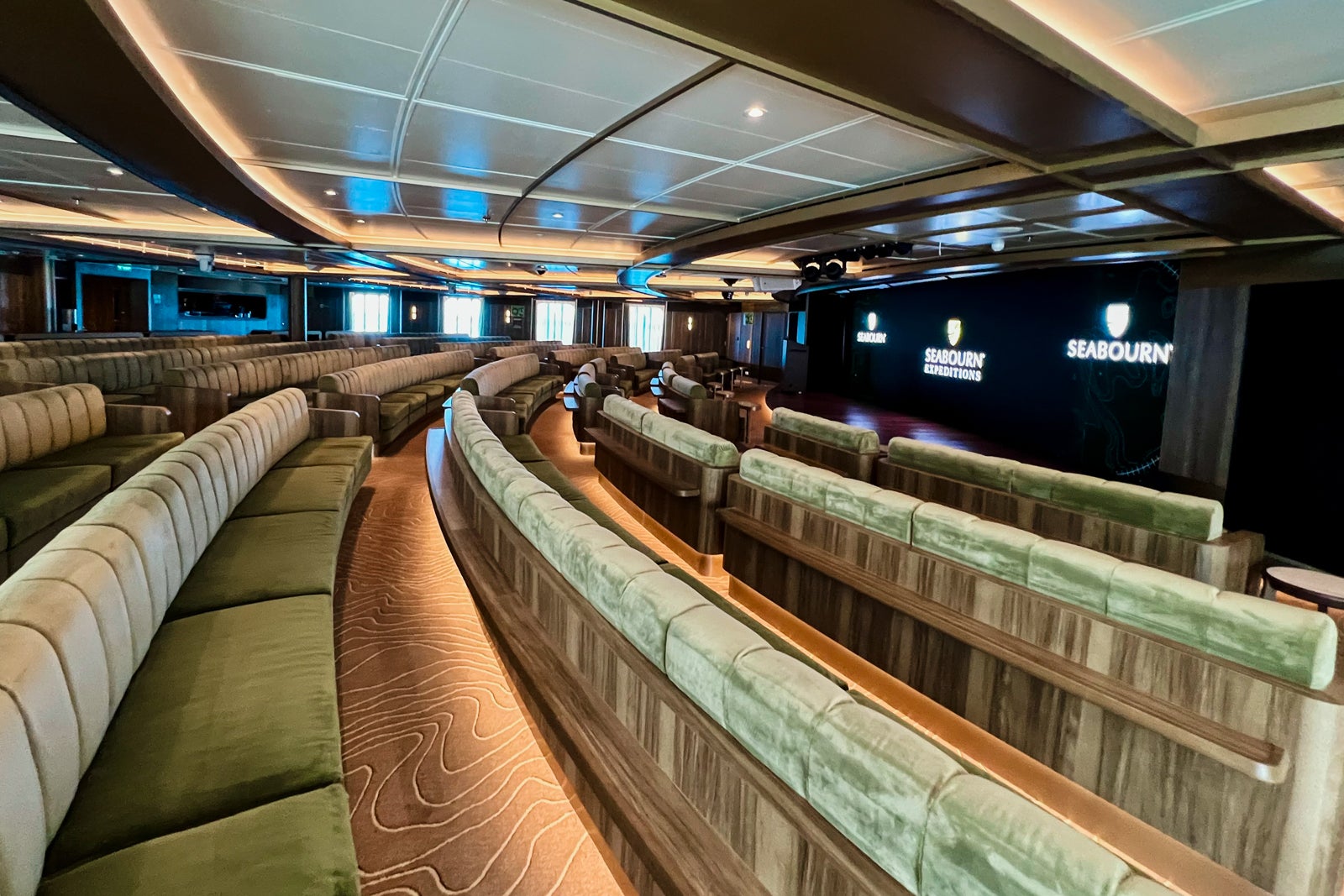
Seabourn Pursuit also has two side-by-side mud rooms (called The Landing Zone) with lockers where passengers can change, clean and store their boots and gear following excursions.
Just off the mud rooms are the side-of-the-ship portways where passengers board Zodiacs for the daily outings.
Seabourn Pursuit sails with a fleet of 24 Zodiacs for such outings, stored at the very top of the ship and lowered by cranes during landing operations. The ship also carries eight sea kayaks for included-in-the-fare kayaking tours, snorkel gear for snorkeling during outings and two submarines for extra-charge underwater exploration. The latter is still relatively rare on expedition ships.
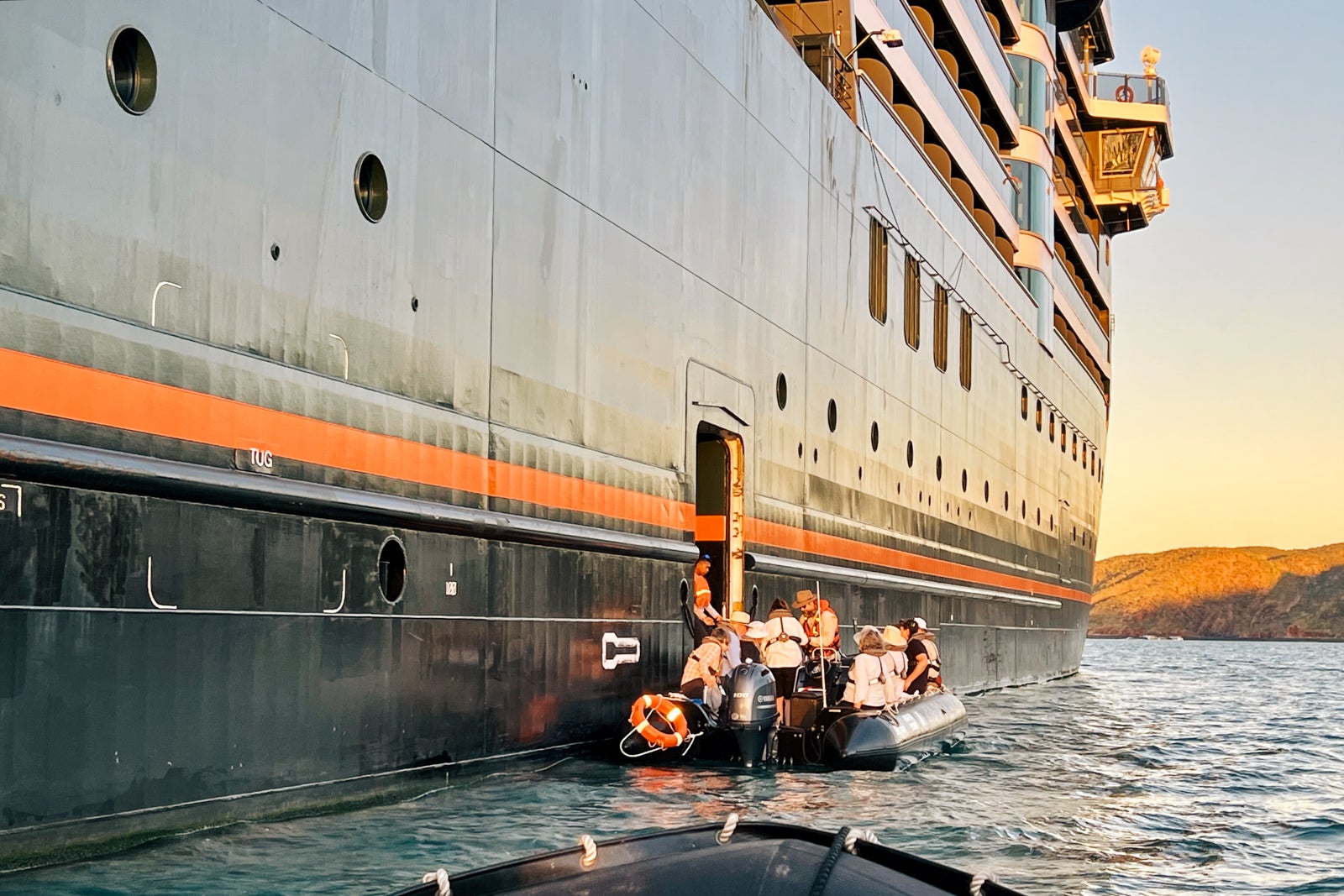
Both kayaks and submarines are used on the ship's Antarctica and South Pacific sailings but not in the Kimberley. The presence of crocodiles in the Kimberley makes the use of kayaks risky. Other factors, such as strong tides, keep Seabourn from using the submarines in the Kimberley.
In addition to the above, Seabourn Pursuit offers complimentary scuba diving sessions led by an onboard divemaster in select warm-water destinations in the South Pacific.
While expedition cruise-style adventure is the focus of trips on Seabourn Pursuit, the vessel also offers traditional cruise ship allures such as a sun deck with an infinity pool, two whirlpools and chaise lounges at the back of Deck 5. More chaise lounges are located at the backs of Deck 6 and Deck 7. There are two more whirlpools at the back of Deck 9.
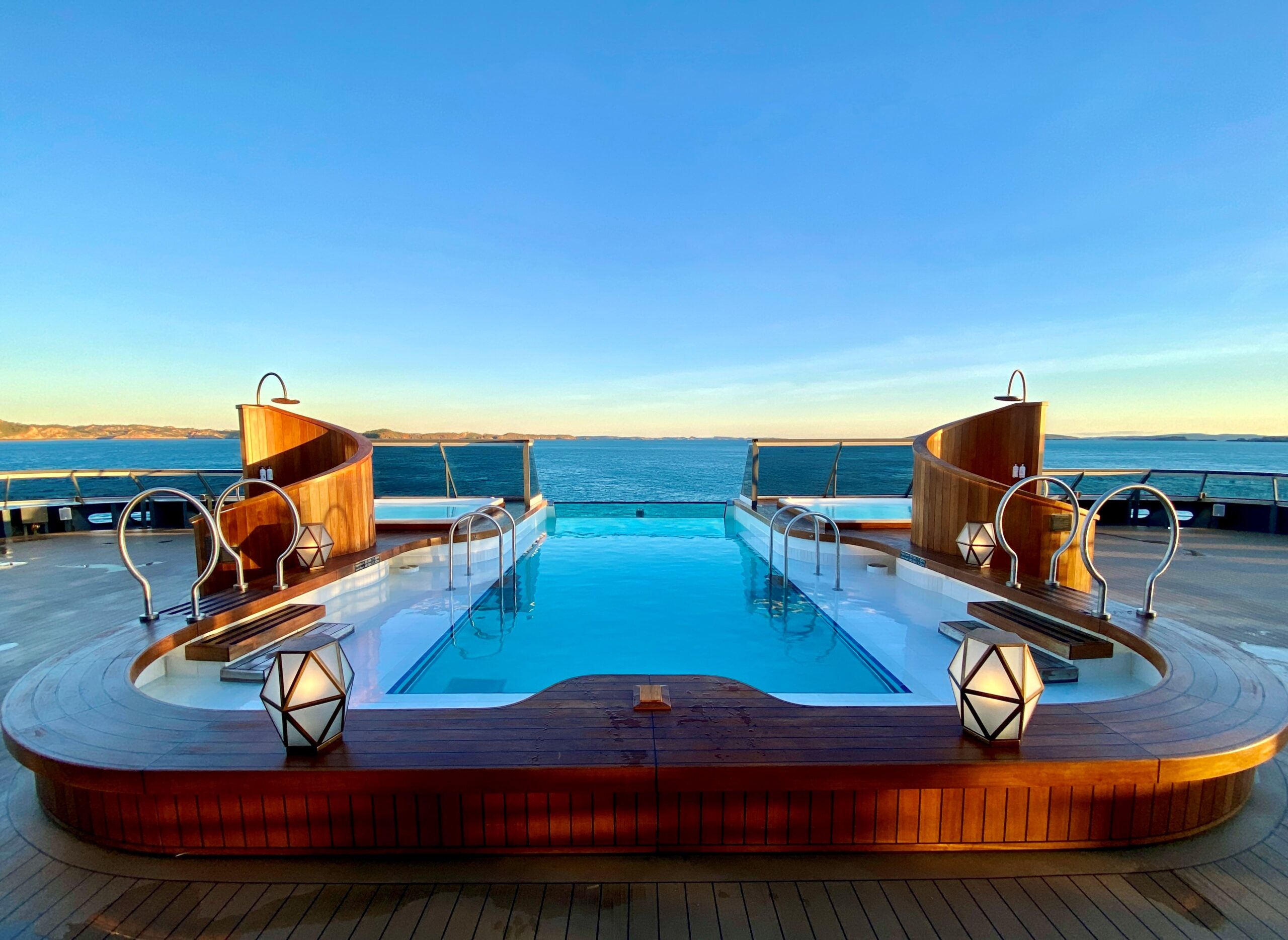
Seabourn Pursuit also has a small but elegant spa and wellness center with four treatment rooms (including a room for couples treatments), separate men's and women's saunas that offer stunning views of the ocean through floor-to-ceiling windows, a hair and nail salon and a small fitness room.
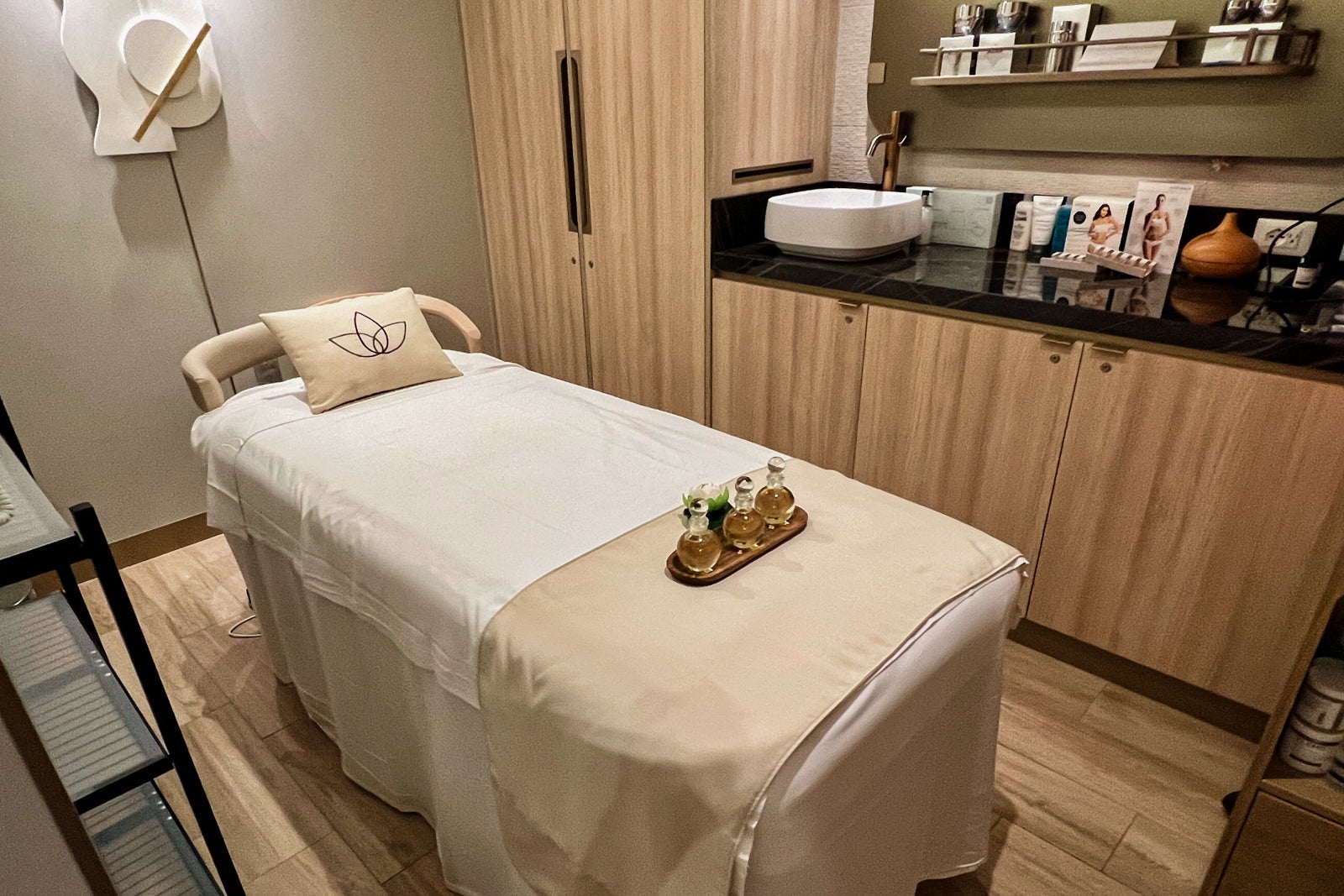
Just be prepared to pay up for spa services. As is often the case on cruise ships, particularly luxury cruise ships, the pricing is sky-high. A 50-minute facial, for instance, will cost you about $270, including an 18% gratuity that is automatically added to bills.
Unlike on Seabourn's bigger ocean ships, there is no casino on Seabourn Pursuit. Seabourn regulars also will notice the ship lacks a back-of-the-ship marina or a secondary pool area.
Another difference with Seabourn's bigger ocean ships is its open-bridge policy. On most days, while the ship is underway, passengers can visit the bridge at will and watch it in operation. This is more common on expedition ships than on bigger traditional vessels.
Seabourn Pursuit itineraries and pricing
Seabourn Pursuit currently spends its summers in the Kimberley region of Australia and its winters in Antarctica. In both cases, the ship operates expedition-style trips that revolve around landings to see wildlife and scenery.
Seabourn Pursuit also offers a few one-off sailings across the South Pacific and down the coast of Chile in the spring and fall, traveling between the Kimberley region of Australia and Antarctica.
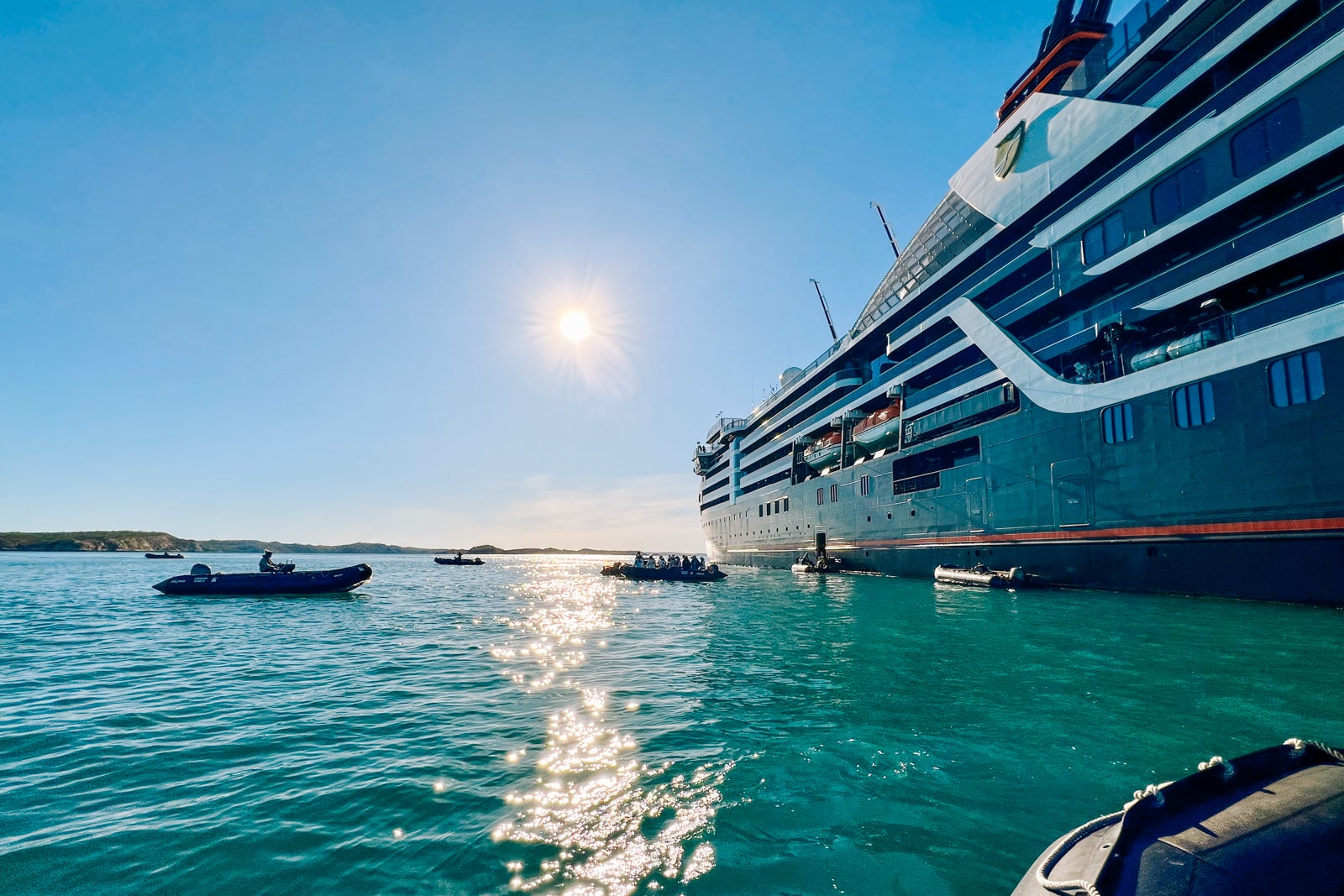
The Kimberley sailings are mostly 10-night trips that follow one-way routings between Broome and Darwin, Australia. The Antarctica sailings range from 11 to 21 nights in length, with the longer sailings including visits to South Georgia Island and the Falkland Islands.
Fares start at $8,499 per person, based on double occupancy, for a 10-night Kimberley cruise.
An 11-night Antarctica trip that includes 10 nights on the ship and a night at a hotel in Buenos Aires, Argentina, starts at $8,498 per person.
What to know before you go
Required documents
Seabourn Pursuit sails global itineraries for which passengers always need a valid passport. For some itineraries, passengers also need visas to enter countries on the schedule. Be sure to research visa requirements far in advance of your sailing so you have time to get everything in order before you go. Visa processing can be a time-consuming process. Note that you will very likely be denied boarding if you arrive for your cruise without the proper travel documentation. In such cases, you are not eligible for a refund.
When assembling your documents, be sure your passport will be valid for six months beyond the end of your cruise, as that's a requirement to enter many countries .
You will also need to fill out preboarding documents online before your cruise.
Related: When and how to renew your passport, according to the State Department
Seabourn's all-inclusive fares cover all crew gratuities, and passengers thus aren't expected to tip when on board Seabourn ships. The only time you might be expected to tip while on a Seabourn cruise is during an off-the-ship excursion, as gratuities for tour guides and drivers on shore tours are not included in fares.
All passengers can access the ship's Wi-Fi for free. Passengers in Ocean View and Verandah suites receive unlimited standard internet service (basic browsing, messaging and emailing) on one device, while passengers in higher-category Penthouse and Premium suites get unlimited premium internet service (streaming and video calling) on multiple devices. Passengers who have reached the Diamond tier of the Seabourn Club loyalty program also will receive the faster premium service, no matter their suite category.
Passengers in suites that only come with standard internet service can pay about $20 a day to upgrade to the premium service that allows for streaming. Upgrading also lets you access the internet on up to four devices simultaneously.
Carry-on drinks policy
All drinks are complimentary on Seabourn Pursuit, with the exception of the most expensive wines and liquors. However, if you are particular to certain brands, you can bring on board an unlimited amount of wine and liquor, both on embarkation day and in ports of call, and you do not have to pay a corkage fee.
Smoking policy
The only place you can smoke cigarettes, cigars or pipes on Seabourn Pursuit is along the starboard half of the ship's outdoor Sky Bar area. Smoking such items anywhere else on the ship, including in all interior areas, in suites and on private balconies, is prohibited.
The rules are slightly looser for electronic cigarettes, which can be smoked in passenger suites and the Sky Bar area.
Passengers caught smoking traditional cigarettes, cigars or pipes in their suites or on balconies will be charged a $250 per day cleaning fee.
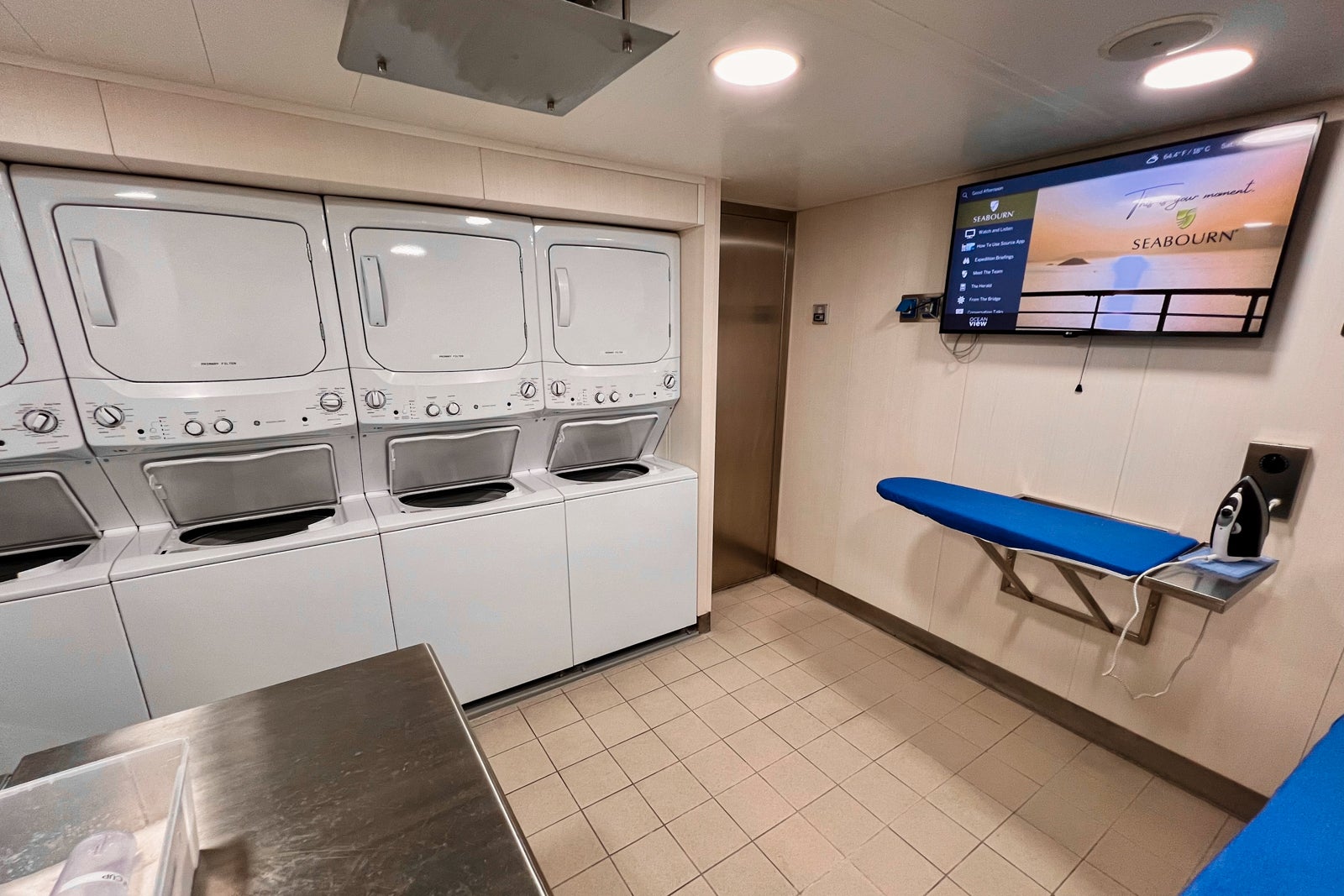
You have two options for doing laundry on Seabourn Pursuit. You can pay to have your clothes washed, pressed or dry-cleaned by the ship's laundry service, or you can clean them yourself for free using the self-service launderette found on Deck 5.
If you choose the former option, your suite attendant will pick up your dirty clothes and bring them back clean. Prices for such service range from $6.50 for a men's shirt to $11 for a dress unless you have status in Seabourn's loyalty program. If you do, you might get some or all of your send-out laundry done for free. The amount depends on your loyalty level, with top-tier Diamond Elite members getting complimentary normal laundry and pressing services throughout their sailing, plus limited dry cleaning services.
For those doing their own laundry, the ship's launderette has washers, dryers, complimentary detergent and ironing boards.
Electrical outlets
Seabourn Pursuit suites offer both U.S. 110-volt and European 220-volt outlets, as well as USB ports next to beds. You'll find additional outlets and USB ports at the built-in desks in suites and above the cabinets across from beds in Veranda Suites. Americans may want to bring an adapter for charging devices in public rooms, where the outlets are all European-style.
The onboard currency is the dollar, regardless of where Seabourn Pursuit is in the world. The ship operates on a cashless system. You will use your cruise keycard to pay for all purchases and then receive a final bill at the end of the cruise. You can pay that bill with a credit card (Visa, Mastercard, Diners Club, American Express or Discover) that you've registered with the ship or with cash.
You can request a cash advance on board but will be charged a 3% fee on the amount.
Drinking age
The minimum drinking age on Seabourn Pursuit is 21, with some exceptions. On sailings departing and returning to Australia, New Zealand, Europe and some parts of Asia, the drinking age is 18. For cruises departing and returning to Japan, the drinking age is 20.
The ship's crew can also refuse to serve alcohol to anyone they deem excessively inebriated or a danger to others on board.
Pack for your cruise like you would for a stay at a high-end resort. During the day, you'll want casual outfits suitable for the day's weather and activities, including appropriate swimwear cover-ups and comfortable shoes for walking. Guests tend to be stylish and elegant even when dressed casually, but shorts and jeans are welcome in all lounges and dining venues.
In the evening, after 6 p.m., guests should adhere to Seabourn's "elegant casual" dress code. For men, it's slacks with a collared dress shirt or sweater; jackets are optional. For women, it's slacks or a skirt with a blouse, a pantsuit or a dress.
Seabourn makes a point of noting jeans are not allowed in The Restaurant after 6 p.m.
Bottom line
Seabourn Pursuit is one of the most elegant and upscale expedition ships currently sailing the world's oceans. Like all Seabourn ships, it features lovely interior venues designed by noted hospitality design firm TIhany Design, and it has spacious, high-end accommodations, including some truly spectacular suites. It sails with a large number of crew to passengers, ensuring high levels of service. If you're looking to explore the ice-filled coast of Antarctica or the rugged shores of Australia's rugged Kimberley region in the utmost style and are willing to pay up for the privilege, this could be the ship for you.
Planning a cruise? Start with these stories:
- The 5 most desirable cabin locations on any cruise ship
- A beginners guide to picking a cruise line
- The 8 worst cabin locations on any cruise ship
- The ultimate guide to what to pack for a cruise
- A quick guide to the most popular cruise lines
- 21 tips and tricks that will make your cruise go smoothly
- Top ways cruisers waste money
- The ultimate guide to choosing a cruise ship cabin
- Search Please fill out this field.
- Manage Your Subscription
- Give a Gift Subscription
- Newsletters
- Sweepstakes
This Cutting-edge Expedition Ship Takes Travelers to Antarctica in Cool Scandinavian Style
Viking Polaris is a sleek expedition vessel that takes travelers to the Southern Ocean — but doesn't skimp on comfort. Here's a closer look at what it's like on board.
Staterooms and Suites
Bars and restaurants, where viking polaris sails, shore excursions, amenities and entertainment, family-friendly offerings, accessibility.
Courtesy of Viking Cruises
To be honest, Antarctica was never on my must-visit list. I don’t hold anything against the continent, of course, but it always seemed to me that Antarctica’s a place for rough-and-ready types: people more interested in the frigid outdoors than the creature comforts on board. Trudging through knee-deep snow to spot seals or enduring biting winds while hoping to see a humpback? I figured that was somebody else’s ideal adventure, not mine.
How wrong I was.
On a recent trip to Antarctica aboard Viking Polaris , I not only discovered the multidimensional allure of the ice — but I also realized that you don’t have to sacrifice amenities for adventure.
That’s thanks in large part to Polaris , which was launched in 2022. One of two identical expedition ships from Viking, this 378-passenger vessel has much in common with the nine ocean and 90 river ships of the brand that’s a favorite of Travel + Leisure readers . Aboard this newly constructed expedition ship, the décor is an elegant interpretation of modern Scandinavian style and there are no inside cabins, a particularly important consideration for trips on the sometimes rocky Drake Passage.
As is the case on all Viking ships, some shore excursions and meals in specialty restaurants are included in the fare, as are wine and beer with meals. Viking’s signature emphasis on onboard enrichment is demonstrated through partnerships with the National Oceanic and Atmospheric Administration and the Cornell Lab of Ornithology, among others, who help with programming on Polaris .
But as plush as the ship may be, it can’t compete with the surroundings. In spite of my skepticism — I’ve always considered myself a warm-weather cruiser — Antarctica’s dreamy, otherworldly landscape was a revelation. Penguins, whales, and towering icebergs were tantalizingly close, seemingly just a sliding glass door away.
The ship’s expedition team worked like a well-oiled machine, ensuring that guests understood the protocols for behavior ashore and abided by the International Association of Antarctica Tour Operators (IAATO) regulations to ensure the protection of wildlife and the environment.
With its capacity of 378 passengers, Polaris is one of the largest ships operating in the Southern Ocean that’s allowed to take guests ashore. Because no more than 100 people are allowed at a given landing site at a time, trips to the ice for us were fewer in number — and shorter overall — than they can be on smaller vessels.
If maximizing your time on terra firma is a priority, Polaris might not be the best choice for you. If, on the other hand, you like your shoreside adventures with a touch of luxury back on board, this ship might be just right. It certainly changed my mind.
Read on for more about Viking Polaris , the ship’s many amenities, the feel of the onboard experience, and details on the vessel’s Antarctic itineraries.
Viking Polaris
- Itineraries in Antarctica that put guests face-to-face with penguins, whales, and more — and navigate some of the most breathtaking landscapes on the planet.
- All staterooms have floor-to-ceiling windows that open, allowing for ocean views, iceberg photography, and bracing Antarctic breezes from the comfort of your cabin.
- Mamsen’s is a daytime dining option that celebrates Nordic specialties, including heart-shaped waffles, which are served all day with sour cream, jam, and brown cheese.
- The onboard spa offers complimentary traditional hot-and-cold therapies, including a snow grotto, thermal beds, an open-air hot tub, and cold bucket shower.
Polaris has half a dozen stateroom categories. At the top end, the 1,200-square-foot owner’s suite on deck 6 has its own dining room, living room, butler’s pantry, and outdoor lounge with a hot tub. Entry-level Nordic Balcony suites clock in at 215 square feet, with a floor-to-ceiling window — known on Viking as a Nordic Balcony — that partially retracts to let fresh air in. Depending on the category you book, you may get priority boarding on embarkation day and access to your stateroom from as early as 11 a.m.
There are no inside cabins on Polaris — you’re here for the views, after all — and staterooms of all categories are comfortable and elegantly furnished in Viking’s signature Scandinavian style: think muted tones of beige, blue, white, and gray, with blond woods and wool accents. All suites have generous closet space, and a heated drying closet to store outdoor clothing and footwear — another key consideration on polar cruises.
I was particularly impressed by the heated bathroom floor, roomy walk-in shower (never a given on expedition ships), and capacious bathroom drawers in my Deluxe Nordic Balcony stateroom, one step up from the entry level category. (I would’ve liked a volume control for the in-cabin speaker, over which announcements were often made.)
All cabins have a mini fridge that’s restocked as needed with soft drinks and snacks at no charge, a Nespresso coffee maker, two pairs of binoculars, and a small library of books. Bedside and deskside outlets have both 110- and 220-volt sockets and USB ports. Every guest receives a Viking-branded Helly Hansen jacket and lightweight puffer, ordered online pre-cruise, and passengers are loaned waterproof pants and rubber boots that are essential for landings.
Viking doesn’t charge for dining in its specialty restaurants, and depending on your stateroom cabin category, you can make as many as four guaranteed reservations at both premium restaurants up to 100 days in advance. Manfredi’s is an elegant Italian trattoria (the bistecca Fiorentina is a standout) and at the Restaurant, expect a menu of typical formal dining staples, such as New York strip, beef tenderloin, and poached salmon. Beyond the allotted reservations, guests can dine at either restaurant as many times as they like, provided there’s availability. (Room service is also complimentary — and guests on my sailing were raving about the southern-fried chicken.)
Elsewhere on board, World Café is the all-day buffet, with live cooking stations and open kitchens. Of note are two stations within the Café: one has raw seafood and sushi, with an ever-evolving lineup of rolls and nigiri, while the other is a pick-your-cut grill with a selection of aged steaks, pork chops, and burgers.
Aquavit Terrace is another dining venue, overlooking the swimming pools, with seating to accommodate overspill from the buffet. Its light-filled Aquavit bar — look up to admire the dog sled suspended from the ceiling — is a good spot for pre-dinner cocktails and ocean views.
Mamsen’s is a small restaurant serving Norwegian cuisine for breakfast, lunch, and afternoon tea. The grab-and-go venue offers a smörgåsbord of open-face sandwiches, traditional split pea soup, desserts, and made-to-order heart-shaped Norwegian waffles that were, for me at least, irresistible.
Across the ship, passengers with food restrictions are welcome to request appropriate substitutions.
Several bars play to the convivial spirit of most Antarctica-bound passengers. Most popular is the one in the Living Room, where everyone gathers to read, join group activities, and enthusiastically compare notes on the day’s landings. Second in popularity is the Hide, an intimate lounge secreted on Deck 1. By day, it’s a quiet spot for reading or undisturbed post-lunch naps. In the evenings it takes on a speakeasy vibe, the bartender serving from a tightly edited selection of premium spirits with the cozy mood set by a water-vapor fireplace. At the front of the ship, Pap’s bar in the Explorer Lounge is a good place for cocktails with a view; the Viking Bar outside Manfredi’s and the Restaurant is handy for aperitifs.
From October through March, the Antarctic summer, Polaris cruises to the White Continent from Ushuaia, Argentina. Viking’s 13-day Antarctic Explorer itineraries begin with an overnight in Buenos Aires then a flight to Ushuaia for embarkation. After a two-day crossing of the Drake Passage, passengers spend the next seven days exploring Antarctica before returning to Ushuaia.
In March, after a final Antarctic cruise, Polaris heads north, following the coast of South America, transiting the Panama Canal, and stopping in cities such as New York and Toronto. The ship typically reaches the Great Lakes in May, where it spends the Northern Hemisphere summer until it turns south once again.
As is the case on all Viking ships, there’s at least one complimentary shore excursion every day, weather permitting. On my journey aboard Polaris , we typically got to choose from two: a Zodiac ride to a landing site — or a tour of the surrounding seas if landing wasn’t possible — or a 45-minute jaunt on what Viking calls its special operations boats, each with a dozen comfortable seats. To control capacity on land, both options must be booked in advance. (In Antarctica, unpredictable wind speeds and ever-changing sea conditions mean that no landing can ever be guaranteed, so expect adjustments along the way: midway through my sailing, the captain had already revised landing locations four times.)
Still, there were several opportunities to set foot on the seventh continent. I was blown away by the sight — and, honestly, the overwhelming stench — of the Gentoo penguin colony at Damoy Point. Depending on the time of year, other penguin species will be around, as will fur and Weddell seals. On one excursion, I caught an awe-inspiring glimpse of a humpback’s forked tail, as it arced briefly above the surface of Fournier Bay.
During one trip on the special operations boat, whizzing through the Melchior Islands, I found myself unexpectedly impressed by the massive and majestic icebergs. Guests can also get on the water by signing up for guided tours by two-person kayaks; Polaris carries 12 of them.
The only activity with an extra cost is a 30-minute dive on one of two submersibles aboard. The $500 trip, with as many as five other passengers, takes the adventurous few as far as 500 feet below the surface, looking for animals including penguins and the rare phantom jellyfish. The 11-ton, egg-yolk yellow subs are, it’s worth mentioning, named Ringo and George; the expedition ship Viking Octantis carries twin subs named John and Paul.
The best entertainment on Polaris is what’s going on outside the ship, and the onboard enrichment program is focused on wildlife, history, topography, and oceanography. On my sailing, there were lots of talks about the animals we’d see and very detailed briefings, held in the Aula theater, about our landing sites. The team of expedition guides on my cruise included an ornithologist, cetacean specialist, naturalist, and an ecotoxicologist. These scientists encouraged guest participation in their real-world research, whether it was collecting water samples to gauge the presence of microplastics or remotely shooting underwater video footage to measure the abundance and diversity of the region’s sea life.
Polaris and its sibling ship Octantis are the only commercial cruise vessels authorized to release weather balloons into the atmosphere. Once per departure, guests can watch a launch; data from the sensors on the balloons is used by meteorologists to inform weather forecasts all over the world.
Besides all the expedition and science activities, entertainment options are somewhat limited: expect to find low-key things like art classes, nautical knot demonstrations, and movie and documentary screenings. In the evenings, a classical or contemporary musical duo would play in the Explorer Lounge and the Living Room, where loveseats and chaises draped in reindeer hides are arranged around water-vapor fireplaces. When they weren’t out on the ice, my fellow passengers occupied themselves with books, board games, and moments of solitude. I enjoyed walking the ship and taking in the many paintings and photographs centered around the theme of Antarctic exploration, which are detailed in an audio tour available through Viking’s mobile app.
Spa lovers, like me, should enjoy the ship’s deck 2 sanctuary; I found it a heavenly haven after spending hours ashore. The wellness area is filled with traditional Nordic hot-and-cold therapies, including things such as a jetted pool, stone thermal beds, a “snow grotto” of constantly falling shaved ice, an ice-bucket shower, and a sauna. There’s also a badestamp , or hot tub, with a window permanently open to the ocean, for sightseeing while you soak.
Polaris also has an impressively large fitness center, one side equipped with cardio machines, the other a spacious wood-floored studio for yoga, meditation, or weights. (I was able to seamlessly stream Peloton workouts on my phone in the gym, thanks to the ship’s strong Wi-Fi.) The ship also has a hair salon and, on deck 3, a small boutique with sundries — and much-coveted Viking Antarctica jacket patches that my fellow passengers had to have.
This isn’t a ship for kids: all Viking cruises, including those on the Viking Polaris, are adults-only, with a minimum age of 18.
Two Nordic Junior Suites on Deck 4 comply with ADA regulations. That said, Viking requires all passengers headed to Antarctica to present a doctor’s attestation that they are healthy enough to travel on such an expedition, with no pre-existing conditions that could require the sort of advanced medical attention that’s unavailable in this remote corner of the world. Because all Antarctica landings are “wet,” with cruisers climbing from the ship to an inflatable tender then onto shore in water up to the calves, some people with limited mobility may not find these trips to be practical, in spite of the accommodations on board.
Related Articles

Getting sick on a cruise ship could cost you as much as the vacation
Over 34 million are expected to travel on cruise ship in 2024.
A record 34.7 million people are estimated to go on a cruise trip in 2024, according to the Cruise Lines International Association (CLIA) . And if they’re not careful, some of them could wind up with a hefty medical bill.
It’s vital for anyone going on a cruise to pay close attention to the fine print of their cruise line’s terms, especially when it comes to medical care.
In the worst case scenario, you could be forced to pay thousands of dollars before you’re allowed leave the ship, like in the case of Vincent Wasney .
Wasney, who was uninsured at the time, went a cruise with his wife in December of 2022. After suffering a series of seizures, Wasney had to be evacuated off the ship by a rescue boat to seek appropriate medical care on land. However, as he was leaving he was presented with $2,500 bill for the care he had already received on the ship.
Wasney was traveling on a Royal Caribbean cruise, which has a policy in their terms of agreement in which guest must pay all onboard costs before the end of the cruise .
Even for those passengers who are insured, they could still be left with a costly bill due to a medical emergency, considering that most cruise ships don’t accept health insurance.
Here is everything you need to know about how medical care on cruise ships works.
What are common health concerns on a cruise?
Medical staff aboard cruise ships typically handle medical concerns like the ones seen in emergency departments and urgent care centers on land, Joe Scott, the chair of the cruise ship medicine section of the American College of Emergency Physicians (ACEP), told Quartz.
“While sea sickness and sunburns may be more frequent and motor vehicle collisions less so, complaints of chest pain, abdominal pain, fever, injuries, and mental health issues are regularly seen and evaluated,” Scott said.
The U.S. Centers for Disease Control and Prevention (CDC) warns that shipboard environments can “facilitate the spread of person-to-person, foodborne, and waterborne diseases .”
According to the CDC, roughly half of all passengers that seek medical care are a cruise ship are older than 65
What are cruise ships equipped to handle?
All oceangoing cruises that are members of CLIA are required to meet medical facility guidelines set by ACEP, CLIA vice president of communications and public affairs Sally Andrews told Quartz.
These guidelines include having “at least one qualified medical professional available 24/7 for medical bay visits or cabin ‘house calls,’” Andrews said.
Cruise ships are also required to have an examination room, an intensive care room, and equipment that can process lab tests, monitor vital signs, and administer medications.
“Larger cruise ships are typically equipped to manage the first few hours of any emergency that may occur, and well prepared to manage many conditions for a few days,” Scott said.
About 95% of conditions reported to ship medical staff is managed onboard, according to the CDC.
Why don’t cruise ships accept health insurance?
Most cruise ships don’t accept health insurance because each trip has guests from all around the world with hundreds of different insurance plans, each with different polices for international coverage.
“Requiring payment of all charges while on board reduces this very large administrative burden,” Scott said.
Cruise lines typically encourage guests to seek reimbursement from their plans when they get home. But coverage could vary depending on the policy.
For example, Medicare does not cover healthcare services obtained more than 6 hours away from a U.S. port .
What should you look for in a travel insurance plan?
The best way to protect yourself is to buy a travel insurance plan that covers medical expenses. Premiums for these plans can cost up to a couple hundred dollars, but in the case of an emergency they can save a traveler thousands.
Scott recommends travelers purchase plans that cover their current medical conditions and the locations they plan to visit on their trip.
He also stresses that a good plan should have sufficient medical evacuation coverage since cruise ships often visit remote locations.
According to Scott, air medical evacuations from the Caribbean to the U.S. mainland could cost around $20,000 and similar evacuations in Alaska, the South Pacific, and Australia could cost over $100,000.
What preventative actions can you take to protect yourself on a cruise?
“Contrary to what some may think, the medical concerns you have onshore will continue when you are on a cruise,” Scott said.
He recommends passengers bring extra quantities of their current medications, along with a list of their prescriptions , medical problems, and contact info for their doctors. This list could come in handy for the ship’s medical staff in the case of an emergency.
Scott also said that people should wash their hand frequently, stay hydrated, and know their limits.
“Climbing the stone steps in Santorini may sound exciting but if you don’t regularly exercise in the heat, you might want to reconsider,” Scott said.
For the latest news, Facebook , Twitter and Instagram .

- The Inventory
Support Quartz
Fund next-gen business journalism with $10 a month
Free Newsletters

Getting sick on a cruise ship could cost you as much as the vacation
Most cruise ships don't accept health insurance in the event of a medical emergency.
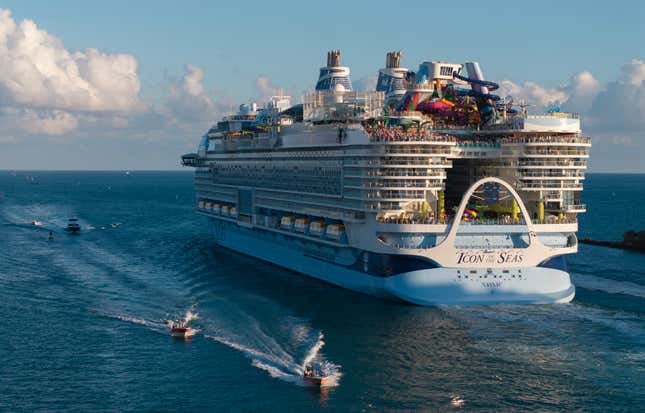
A record 34.7 million people are estimated to go on a cruise trip in 2024, according to the Cruise Lines International Association (CLIA) . And if they’re not careful, some of them could wind up with a hefty medical bill.
Suggested Reading
It’s vital for anyone going on a cruise to pay close attention to the fine print of their cruise line’s terms, especially when it comes to medical care.
Related Content
In the worst case scenario, you could be forced to pay thousands of dollars before you’re allowed leave the ship, like in the case of Vincent Wasney .
Wasney, who was uninsured at the time, went a cruise with his wife in December of 2022. After suffering a series of seizures, Wasney had to be evacuated off the ship by a rescue boat to seek appropriate medical care on land. However, as he was leaving he was presented with $2,500 bill for the care he had already received on the ship.
Wasney was traveling on a Royal Caribbean cruise, which has a policy in their terms of agreement in which guest must pay all onboard costs before the end of the cruise .
Even for those passengers who are insured, they could still be left with a costly bill due to a medical emergency, considering that most cruise ships don’t accept health insurance.
Here is everything you need to know about how medical care on cruise ships works.
What are common health concerns on a cruise?
Medical staff aboard cruise ships typically handle medical concerns like the ones seen in emergency departments and urgent care centers on land, Joe Scott, the chair of the cruise ship medicine section of the American College of Emergency Physicians (ACEP), told Quartz.
“While sea sickness and sunburns may be more frequent and motor vehicle collisions less so, complaints of chest pain, abdominal pain, fever, injuries, and mental health issues are regularly seen and evaluated,” Scott said.
The U.S. Centers for Disease Control and Prevention (CDC) warns that shipboard environments can “facilitate the spread of person-to-person, foodborne, and waterborne diseases .”
According to the CDC, roughly half of all passengers that seek medical care are a cruise ship are older than 65
What are cruise ships equipped to handle?
All oceangoing cruises that are members of CLIA are required to meet medical facility guidelines set by ACEP, CLIA vice president of communications and public affairs Sally Andrews told Quartz.
These guidelines include having “at least one qualified medical professional available 24/7 for medical bay visits or cabin ‘house calls,’” Andrews said.
Cruise ships are also required to have an examination room, an intensive care room, and equipment that can process lab tests, monitor vital signs, and administer medications.
“Larger cruise ships are typically equipped to manage the first few hours of any emergency that may occur, and well prepared to manage many conditions for a few days,” Scott said.
About 95% of conditions reported to ship medical staff is managed onboard, according to the CDC.
Why don’t cruise ships accept health insurance?
Most cruise ships don’t accept health insurance because each trip has guests from all around the world with hundreds of different insurance plans, each with different polices for international coverage.
“Requiring payment of all charges while on board reduces this very large administrative burden,” Scott said.
Cruise lines typically encourage guests to seek reimbursement from their plans when they get home. But coverage could vary depending on the policy.
For example, Medicare does not cover healthcare services obtained more than 6 hours away from a U.S. port .
What should you look for in a travel insurance plan?
The best way to protect yourself is to buy a travel insurance plan that covers medical expenses. Premiums for these plans can cost up to a couple hundred dollars, but in the case of an emergency they can save a traveler thousands.
Scott recommends travelers purchase plans that cover their current medical conditions and the locations they plan to visit on their trip.
He also stresses that a good plan should have sufficient medical evacuation coverage since cruise ships often visit remote locations.
According to Scott, air medical evacuations from the Caribbean to the U.S. mainland could cost around $20,000 and similar evacuations in Alaska, the South Pacific, and Australia could cost over $100,000.
What preventative actions can you take to protect yourself on a cruise?
“Contrary to what some may think, the medical concerns you have onshore will continue when you are on a cruise,” Scott said.
He recommends passengers bring extra quantities of their current medications, along with a list of their prescriptions , medical problems, and contact info for their doctors. This list could come in handy for the ship’s medical staff in the case of an emergency.
Scott also said that people should wash their hand frequently, stay hydrated, and know their limits.
“Climbing the stone steps in Santorini may sound exciting but if you don’t regularly exercise in the heat, you might want to reconsider,” Scott said.
📬 Sign up for the Daily Brief
Our free, fast, and fun briefing on the global economy, delivered every weekday morning.

IMAGES
VIDEO
COMMENTS
The answer to how much of a cruise ship that is underwater varies depending on several factors. It's all about the size of the ship and the amount of load being carried. But in general, it is around 10% of the ship's height or around 30 feet for the biggest cruise ships out there. The main thing to remember is that the amount of the ship ...
According to this principle, the cruise ship displaces an amount of water equal to its own mass. Let's take an example of the largest cruise ship, Symphony of the Seas, which weighs approximately 228,000 tons and would displace 228,000 tons of water.
How much does a cruise ship weigh, how long does it measure, and what is its height? Well, the 50 largest cruise ships in the world weigh over 100,000 gross tons . Royal Caribbean International ...
For large cruise ships, this equates to approximately 30 feet or 9 meters. The underwater part of the ship's hull is typically wide at the back and narrows towards the bow. The amount of the ship that is underwater ranges from 20 feet for a smaller ship to 31 feet for the largest vessels.
Usually, about 10% of a cruise ship's overall height is under the water. This equates to about 30ft for large cruise ships. The underwater part of the ship's hull is typically wide at the back narrowing towards the bow. Some of the largest cruise ships in the world, like Royal Caribbean's Oasis-class ships, have a height above the ...
The design of a cruise ship's hull is crucial for its stability. These massive ships have wide hulls to help them displace the right amount of water. On average, about 30 feet of a large cruise ship is underwater, allowing it to float and navigate safely. Cruise Ship Weight, Length, and Height Statistics
But how much of a ship is actually underwater? Around 10% of a cruise ship is below the water. Some of the largest cruise ships in the world, Royal Caribbean's Oasis-class ships, have a height above the waterline of around 72 metres (236ft 11in), and a draft below the water of around 9.3 meters (30ft 6in). ...
How Much of a Cruise Ship is Under water? Usually, about 10% of a cruise ship's overall height is under the water. This equates to about 30ft for large cruise ships. The underwater part of the ship's hull is typically wide at the back narrowing towards the bow. It usually correlates proportionally that the larger the cruise ship is, the ...
the average cruise ship is about 60% underwater. This means that the top 40% of the ship is above the waterline, while the bottom 60% is submerged. This design is necessary to provide stability and buoyancy for the ship, as well as to allow for the storage of cargo and fuel.
Discover the intriguing dimensions of cruise ships with our in-depth look at how much of a cruise ship is under water - essential maritime insights.
How Much of a Cruise Ship Is Under Water and Why? Oct 21, 2023. Fact Checked By Bobby Pham
Generally, about 10% of the ship's height or around 30 feet for the biggest cruise ships is underwater. The weight of passengers and crew also contributes to how much of the ship is underwater. For instance, the Symphony of the Seas cruise ship can carry 9,000 people, including passengers and crew.
The weight of passengers on board also contributes to how much of a cruise ship is underwater. For instance, the Symphony of the Seas cruise ship can carry 9,000 people, including passengers and crew. The average weight of US males is 199.8 pounds. The average weight of US females is 170.8 pounds. Assume each passenger has 100 pounds of luggage.
This means a big part of the ship is actually underwater to help keep it stable and balanced. They weigh over 100,000 tons and have up to 14 decks full of fun activities and places to relax, offering everything passengers need for a great vacation on the water.
In simple terms, it indicates how much of the ship is underwater. Factors Influencing the Draft Ship's Load. As a ship takes on more weight, be it cargo, fuel, provisions, or passengers, it will sit deeper in the water, increasing its draft. ... In essence, the portion of a cruise ship that's submerged underwater is influenced by a variety ...
So, let's dive in and navigate the depths of a cruise ship's design! Understanding the Design of a Cruise Ship. A cruise ship is a complex structure with a design that balances functionality, stability, and aesthetics. To understand how much of the ship is underwater, it's crucial to have a basic understanding of its design.
That said, a cruise ship should be much less submerged when it's empty as compared to when it's full of passengers at full capacity. ... In general though, there's about 40% of cruise ship underwater that you can't see. That means whatever you see above water usually only accounts for 60% of the ship's entire size. Remember though ...
How much does a cruise ship weigh, how long does it measure, and what is its height? Well, the 50 largest cruise ships in the world weigh over 100,000 gross tons. Royal Caribbean International owns the four largest ships in the world. In terms of height, the average Royal Caribbean International cruise ship measures 14 decks (stories) high ...
These ships are meticulously designed and engineered to float on water, with only a small portion of their total size being underwater. The majority of a cruise ship's structure is above the waterline, creating a majestic sight as it sails through the ocean. The hull of a cruise ship, which is the outermost layer of the ship's underwater part ...
Venture, the first expedition ship for the luxury cruise line, is outfitted with two submarines, and I was on my way to board one of them for a 30-minute dive to the bottom of the ocean in the frigid Arctic waters of Greenland. ASHLEY KOSCIOLEK/THE POINTS GUY. Each submersible is capable of diving nearly 1,000 feet below the surface, holds six ...
Underwater Cruise Ship Rooms Underwater Cruise Lounge. In 2019, Ponant, a French expedition company, launched the first underwater lounge. Blue Eye, designed by architect Jacques Rougerie, is a ...
The bottom of a cruise ship is not perfectly flat, although it does look flat from a distance. Under the water, the front of the ship is usually v-shaped or u-shaped, with the back of the ship having a square-like shape. In this article, we will look at how the bottom of cruise ships are shaped - and why they are shaped like this.
How much of a cruise ship is underwater? About 10% of a ship's overall height is underwater. This could end up being anywhere from 20 feet to 30 feet. That said, the larger the vessel, the ...
The 5 most desirable cabin locations on any cruise ship; A beginners guide to picking a cruise line; The 8 worst cabin locations on any cruise ship; The ultimate guide to what to pack for a cruise; A quick guide to the most popular cruise lines; 21 tips and tricks that will make your cruise go smoothly; Top ways cruisers waste money
In just a few months, Disney Cruise Line will welcome its next ship, 4,000-passenger Disney Treasure, to the fleet when the 144,000-ton ship sets sail from Port Canaveral, Florida, with its first ...
That's thanks in large part to Polaris, which was launched in 2022.One of two identical expedition ships from Viking, this 378-passenger vessel has much in common with the nine ocean and 90 ...
How to Cruise on a Budget 1. Book the Cheapest Room on an Old Ship. A simple yet effective way to save money on a cruise is to book the cheapest room on the oldest ship.
Over 34 million are expected to travel on cruise ship in 2024. A record 34.7 million people are estimated to go on a cruise trip in 2024, according to the Cruise Lines International Association ...
Getting sick on a cruise ship could cost you as much as the vacation Most cruise ships don't accept health insurance in the event of a medical emergency. By. Bruce Gil. Published Sunday 5:00AM.
Cunard Cruise Line, however, fills a niche offering back-to-back transoceanic cruises many months of the year. Its Queen Mary 2 is the last "ocean liner" in service, a ship that was purpose ...